 , 张相玉
, 张相玉
RESEARCH PROGRESS IN AUXETIC MATERIALS AND STRUCTURES1)
RenXin , ZhangXiangyu
, ZhangXiangyu
中图分类号:O34
文献标识码:A
通讯作者:
收稿日期:2018-11-14
网络出版日期:2019-05-18
版权声明:2019力学学报期刊社 所有
基金资助:
展开
摘要
关键词:
Abstract
Keywords:
-->0
PDF (1758KB)元数据多维度评价相关文章收藏文章
本文引用格式导出EndNoteRisBibtex收藏本文-->
引 言
超材料(metamaterials,"Meta"起源于希腊语"${\rm M}\varepsilon \tau \alpha$",意为:超越,亚$\cdots$,另类等)是21世纪以来出现的一类新材料,它的概念来源于电磁学,定义为具有自然界罕见的电磁特性的新型人造材料.目前超材料的概念已逐步渗透到多个领域中,超材料的定义进一步扩展为:具有天然材料所不具备的超常物理性质的人工材料,如光学超材料、声学超材料[1]、热力学超材料、力学超材料[2]等.超材料的关键是通过设计材料的内部结构从而人为控制材料的各种属性以获得自然界没有的新材料.与传统材料相比,超材料在静态模量、密度、吸能耗能、声学、热传导和负泊松比等方面具有超乎寻常的优势.泊松比$\nu $是以法国科学家Siméon Denis Poisson(1787---1840)命名的用以度量材料泊松效应的系数,泊松比也称横向变形系数,表征材料在垂直于作用力方向上的横向变形特性. Poisson将泊松比$\nu $定义为在弹性加载方向上材料的横向应变($et$)和纵向应变($el$)的比值的负数,即$\nu= -et/el$. 对于各向同性材料, $\nu$也可以用表征材料尺寸变化的体积模量$B$和表征形状变化的剪切模量$G$来表示[3],即$v= (3B/G -2)/(6B/ G+ 2)$.这个公式定义了均匀各向同性材料的泊松比的区间,由于$0 \leqslant B/G \leqslant \infty $,则$-1 \leqslant v\leqslant 0.5$. 多种各向同性材料的泊松比$v$关于$B/G$的函数分布如图1所示[4]. 泊松比0.5对应剪切模量为0的液体,而泊松比的另一个极值$-1$出现在体积模量为0时,对于各向异性材料泊松比的范围可能更大. 生活中人们熟知的材料泊松比一般在0$\sim $0.5之间,气体的泊松比为0,常见金属的泊松比大约在0.3左右,橡胶的泊松比接近0.5. 图1中液体和橡胶的泊松比接近0.5,它们属于致密的不可压缩性材料,其在压力作用下体积几乎不发生变化.
 显示原图|下载原图ZIP|生成PPT
显示原图|下载原图ZIP|生成PPT图1多种各向同性材料泊松比$\upsilon (-1\sim 0.5)$关于体积模量$B$与剪切模量$G$比值$B$/$G$的函数分布[
-->Fig. 1The distribution of the Poisson's ratio $(-1 \sim 0.5)$ of various isotropic materials with respect to the ratio of the bulk and shear modulus $B/G$[
-->
具有负力学参数的材料是典型的力学超材料,例如负泊松比、负压缩性、负刚度和负法向应力等[5].此外,力学超材料还 包括超流体、具有正负交替力学参数的材料、轻质高刚度材料等.作为力学超材料中研究最多的分支,负泊松比材料在变形过程中常常表现出反直觉的变形行为,在单轴压力(拉力)作用下,传统材料在垂直于荷载方向上发生膨胀(收缩),而负泊松比材料却沿横向收缩(膨胀),如图2所示.材料的负泊松比特性不受尺度的影响,既可以是材料的整体行为,还可源于其内部结构,即既是宏观材料的性质,也是微观内部结构的性质[6],图3为不同尺度的负泊松比材料和结构. 1987年,Lakes[6]在$Science$首次报道了人造负泊松比材料,通过将聚氨酯泡沫放入铝制模具中,并对其进行压缩、加热、冷却和松弛处理获得了具有特殊内凹结构的负泊松比聚氨酯泡沫. 此后,人造负泊松比材料大量涌现,负泊松比材料和结构迅速发展[7].
 显示原图|下载原图ZIP|生成PPT
显示原图|下载原图ZIP|生成PPT图2拉压荷载下的材料行为[
-->Fig. 2Behaviour in tension and compression[
-->
 显示原图|下载原图ZIP|生成PPT
显示原图|下载原图ZIP|生成PPT图3不同尺度的负泊松比材料[
-->Fig. 3Auxetic materials with different scales[
-->
负泊松比材料和结构在抗剪切性、抗压痕性、抗断裂性、曲面同向性、渗透率可变性[9]和能量吸收性能等方面具有很大优 势. 目前负泊松比材料的应用已涉及人工假体[10]、纺织材料、智能传感器[11-13]、智能过滤器[9,14]、分子过滤器[15]、防护垫[16]、减震器[17]和隔声器[18]等多个领域.
本文从负泊松比材料和结构的种类、原理、性质等方面对国内相关研究成果和最新进展进行了总结,并指出了负泊松比材料存在的问题和可能的解决途径,以期为相关的研究者提供参考.
1 天然负泊松比材料和结构
早在160多年前,经典弹性理论已经提出了负泊松比材料存在的可能性[19].尽管目前大多数的负泊松比材料是通过人工设计制造的,但很早就有研究发现某些天然材料存在负泊松比特性,包括具有特殊结构的分子材料和具有纤维或多孔微结构的生物材料,例如黄铁矿晶体、立方体金属元素、多孔的松质骨骼和猫皮肤等.1.1 负泊松比分子材料
1944年,Love[20]首次证明了黄铁矿晶体存在负泊松比特性并估算其泊松比值约为$-1/7$. Ray等[21]指出负泊松比特性是许多立方体结构金属的共同特征,当沿[110]方向拉伸时,69%的立方体结构金属和具有面心立方结构的固态稀有金属会产生负泊松比效应,如图4(a)所示. 此外还有研究发现$\alpha $-方晶石在大的轴力作用下能表现出负泊松比特性[22],二维结构$\delta$-磷也具有高度的负泊松比特性,可用于制造低维机电设备,如图4(b)所示,图中$a$和$b$为单位晶胞的两个基本矢量方向[23]. 显示原图|下载原图ZIP|生成PPT
显示原图|下载原图ZIP|生成PPT图4负泊松比微观结构
-->Fig. 4Auxetic microscopic structures
-->
一般而言,大多数负泊松比分子结构的力学行为都可以结合几何构造和简单变形机理进行解释.如通过分子力场模拟,发现沸石支架结 构具有负泊松比特性[15].通过布里渊散射研究MFI-硅沸石的单晶弹性特征,发现合成沸石结构存在轴向负泊松比行为[24]. Kou等[25]通过第一原理计算提出合成薄硼片(如硼烯)具有特殊的三角铰链结构,其在拉应变下具有负泊松比特性. Qin等[26]通过分子动力学模拟发现具有褶皱结构的石墨烯分子可以表现出负泊松比行为. Mortazavi等[27]采用第一原理密度泛函理论计算,发现碳化钼薄片具有负泊松比特性.
Yu等[28]在最新的研究中提出一类新型负泊松比单层二维材料存在面内负泊松比特性,与传统的负泊松比机理不同的是,其负泊松比行为是由电子效应引起的. Qin等[29]提出半氟石墨烯可表现出负泊松比特性,这种新型负泊松比机制是由氟原子的化学功能引起的,可看作是一种制造负泊松比纳米材料的新方法.
1.2 负泊松比生物材料
负泊松比生物材料是指在生物体内发现的具有负泊松比特性的材料,如靠近骨骺的松质骨骼[30]、猫皮肤[31]、奶牛乳 头皮肤[32]等,这些生物材料的负泊松比效应大多是由微观纤维结构引起的.除了生物组织以外,细胞也同样存在负泊松比行为,如红细胞的细胞骨架膜[33],胚胎干细胞[34]和染色质凝胶[35]等. 负泊松比效应可能是细胞转化过程中分子力传导的关键因素,Wang[34]通过观察小鼠胚胎干细胞(ESCs)发现其细胞核在转化过渡期间具有负泊松比效应,如图5所示,将处在转化阶段的胚胎干细胞放在比其自身直径小很多的流体微通道内,其细胞质(蓝色部分)和细胞骨架(红色部分)均沿流体的方向(图中箭头方向)发生拉伸,而细胞核却沿各个方向发生均匀膨胀. Pagliara等[36]进一步提出分化期间ESCs细胞核的负泊松比效应可能是由染色质解聚引起的. 此外,Yan等[37]制造了用于预测多能干细胞神经元细胞分化的各种负泊松比聚氨酯支架模型,研究发现支架的负泊松比微观结构可能会增强神经元细胞分化. Yamamoto和Schiessel[35]通过理论分析提出,核小体的协同聚集和分解动力可能会使染色质凝胶表现出负泊松比特性.
 显示原图|下载原图ZIP|生成PPT
显示原图|下载原图ZIP|生成PPT图5转化阶段的胚胎干细胞细胞核受拉膨胀[
-->Fig. 5Nucleus of an embryonic stem cell in the transition state (T-ESC) expands when stretched[
-->
2 胞状负泊松比材料和结构
胞状负泊松比材料属于多孔材料的范畴,具有轻质、高吸能、高隔音和高阻尼等特性. 目前对于胞状结构的研究从二维逐步延伸到三维,研究者们对胞状结构进行了深入的变形机理分析.
图6的Milton--Ashby图展示了正泊松比材料与胞状负泊松比材料之间的关系,图中灰色椭圆表示普通固体的属性域,红色(深色)区域表示胞状负泊松比材料的属性域,$B$为体积模量、$G$为剪切模量、 $\rho $ 为质量密度[38].
 显示原图|下载原图ZIP|生成PPT
显示原图|下载原图ZIP|生成PPT图6负泊松比材料Milton-Ashaby图[
-->Fig. 6Milton--Ashby map of auxetic materials[
-->
通过设计轻质超材料可以填补图中的空白区域,低密度特性主要取决于材料的内部结构和基材的性质.
例如Schaedler等[39]研制出了一个纳米尺度的超轻镍金属晶格,如图7所示,其密度仅为10,mg/cm$^{3}$,将该结构置于蒲公英上时不会将蒲公英压溃.
 显示原图|下载原图ZIP|生成PPT
显示原图|下载原图ZIP|生成PPT图7微观点阵结构[
-->Fig. 7Micro lattice structure[
-->
2.1 内凹结构
常见的二维内凹结构有内凹六边形蜂窝模型、内凹三角形模型(双箭头模型)和星形模型等.内凹结构的负泊松比特性与其特有的内凹角结构有关,但内凹形状并不是结构具有负泊松比特性的充分条件,只有当内凹角度达到一定程度即折叠程度较高时,内凹结构才会产生负泊松比效应[40].Gibson等[41]在1982年首次提出了二维内凹六边形蜂窝结构,如图8所示.对该内凹蜂窝结构施加水平方向的拉力,其纵向杆(图8中橙色杆件)会同时向外移动,其原因是斜杆在受到拉力时,结构内凹角展开,同时斜杆(图8中绿色杆件)发生旋转,导致整体结构膨胀产生负泊松比效应.大多数内凹结构在受拉时不可避免地会发生斜杆的面内旋转,这是内凹系统具有负泊松比特性的主要原因.蜂窝结构在弯折、拉伸和扭转等作用下的变形特性及弹性常数等也是研究的热点[42].Gibson等[43]提出了一种二维蜂窝结构的力学模型,并利用此模型推导了结构沿加载方向上的泊松比和弹性模量,表达式如下
$\nu _{12} = \dfrac{\left( {h / l + \sin \theta } \right)\sin \theta }{\cos ^2\theta } (1)$
$E_1 = k\dfrac{ h / l + \sin \theta }{b\cos ^3\theta } (2)$
$k = E_{\rm s} b\left( { \dfrac{t}{l}} \right)^3 (3)$
其中$h$,$l$,$b$, $\theta $ 的定义参见图9,$E_{\rm s}$是胞状单元构成材料的弹性模量.
 显示原图|下载原图ZIP|生成PPT
显示原图|下载原图ZIP|生成PPT图8内凹负泊松比材料力学行为[
-->Fig. 8Auxetic behaviour of re-entrant structures[
-->
 显示原图|下载原图ZIP|生成PPT
显示原图|下载原图ZIP|生成PPT图9内凹六边形蜂窝结构[
-->Fig. 9Re-entrant hexagon honeycomb structure[
-->
Larsen等[44]率先使用拓扑优化方法设计负泊松比结构,图10是经过优化的二维内凹三角形结构,其负泊松比特性可以通过改变杆件的长度和两个相邻杆件之间的角度进行调节.拓扑优化方法的出现大大增加了负泊松比结构设计的自由性,根据给定的约束和性能等指标,对材料的分布进行优化从而得到最佳的结构方案.星形模型可看作是二维内凹蜂窝结构的变体,各阶星形模型如图11所示,当阶数为1时,即为内凹蜂窝结构,星形结构的负泊松比特性可以通过连接杆的刚度进行调节[45].
 显示原图|下载原图ZIP|生成PPT
显示原图|下载原图ZIP|生成PPT图10二维内凹三角形结构[
-->Fig. 10The 2D re-entrant triangular structure[
-->
 显示原图|下载原图ZIP|生成PPT
显示原图|下载原图ZIP|生成PPT图11旋转对称星型系统:(a)负泊松比蜂窝结构; (b) 3阶星型结构; (c)4阶星型结构;(d) 6阶星型结构[
-->Fig. 11Star-shape systems with different rotational symmetry of order: (a) auxetic honeycomb; (b) star-3 system; (c) star-4 system; (d) star-6 system[
-->
大多数的内凹结构通过单元之间的连接可转化为三维结构,实现多个主应力方向的负泊松比特性.
Evans等[48]首次提出了三维正交内凹蜂窝负泊松比结构,如图12所示,当支杆足够细长时,支杆的弯曲是结构产生负泊松比效应的决定性因素[49],其力学性能可以通过特征长细比和内凹角度进行调节[50].通过结构设计,可以使常规内凹蜂窝结构(NRHH)具有不同的力学特性,如通过在NRHH中嵌入菱形结构生成了一种新型的负泊松比蜂窝结构,如图13所示,其具有比NRHH更高的平面内刚度和临界屈曲强度[51].NRHH的另一种变体是零泊松比半内凹蜂窝结构,其具有高于NRHH的弹性模量,在正交方向上具有更大的刚度,如图14所示.且该零泊松比半内凹蜂窝结构可以很好地与圆柱贴合,如图15所示,正泊松比蜂窝材料包裹于圆柱时,其中部呈现出内凹的形状,负泊松比蜂窝材料则呈现出拱形. 因此,该零泊松比蜂窝结构在用作圆柱形或其他异性夹芯材料时更具优势[52].
 显示原图|下载原图ZIP|生成PPT
显示原图|下载原图ZIP|生成PPT图12三维内凹蜂窝结构[
-->Fig. 12The 3D re-entrant models[
-->
 显示原图|下载原图ZIP|生成PPT
显示原图|下载原图ZIP|生成PPT图13嵌入菱形结构的内凹蜂窝结构[
-->Fig. 13Auxetic honeycomb with rhombic structures[
-->
 显示原图|下载原图ZIP|生成PPT
显示原图|下载原图ZIP|生成PPT图14半内凹蜂窝结构[
-->Fig. 14Semi re-entrant hexagonal honeycomb[
-->
 显示原图|下载原图ZIP|生成PPT
显示原图|下载原图ZIP|生成PPT图15蜂窝管: (a)半内凹蜂窝结构; (b)传统正泊松比蜂窝结构;(c)负泊松比内凹结构[
-->Fig. 15Images of "tubes" formed from: (a) a semi re-entrant honeycomb; (b) a conventional honeycomb; (c) a re-entrant auxetic honeycomb[
-->
三角形模型由于构造简单,可以演变成许多三维结构,图16的三维双箭头模型为典型的三角形模型的变体,由二维三角形单元的顶部与底部两两相连后组合形成. 相邻单元的连接不仅没有影响结构的负泊松比效应,还增加了结构的弹性模量.模型在准静态荷载下的坍塌应力随张拉角$\theta _{1}$的增大和填充角$\theta _{2}$的减小而增大[53].此外,还有通过将三角形模型拉伸旋转得到的圆柱形负泊松比结构[54],如图17所示,其垂直方向的有效弹性模量$E$*和有效泊松比$\upsilon^* $的计算公式如下
$E^\ast = \dfrac{\delta }{\varepsilon _y } = \dfrac{HKE\alpha ^3}{2K^2\beta \sin ^2\phi + \left( {K + K^2} \right)\sin ^3\phi } (4)$
$\upsilon ^{\ast } = - \dfrac{\varepsilon _x }{\varepsilon _y } = \Bigg [ \left( {H - \dfrac{H}{KL}} \right)\sin \phi \cos \phi + $
$\quad \left( {\beta H - \dfrac{\beta H}{L}} \right)\cos \phi - \dfrac{H^2}{L}\sin \phi - \dfrac{\beta H^2}{L} \Bigg ] \Bigg / $
$\quad \Bigg [\left( {L + \dfrac{L}{K}} \right)\sin ^3\phi + \left( {3\beta L + \dfrac{\beta L}{K}} \right)\sin ^2\phi + 2\beta ^2L\sin \phi \Bigg ] $ (5)
式中的变量见图17(a). $K$和$\beta $为长细比,其中$K=M /L$, $\beta= N/L$; $\alpha $为壁厚与壁长的比值,$\alpha = T_{L } / L=T_{M} / M$.
 显示原图|下载原图ZIP|生成PPT
显示原图|下载原图ZIP|生成PPT图16三维双箭头结构[
-->Fig. 163D double arrow structure[
-->
 显示原图|下载原图ZIP|生成PPT
显示原图|下载原图ZIP|生成PPT图17三维内凹三角形结构[
-->Fig. 173D re-entrant triangular structure[
-->
2.2 旋转多边形结构
负泊松比旋转多边形结构是负泊松比材料的另一大类. 旋转系统一般由刚性多边形通过顶点铰接构成,旋转多边形结构的泊松比可正可负,主要取决于多边形的组合方式及系统的开放程度等[55].负泊松比旋转多边形结构产生负泊松比效应的原理是系统受力后刚性多边形绕顶点旋转展开(回缩),使结构整体发生膨胀(收缩),旋转多边形结构也可延伸到三维结构. Grima等[55-59]、Alderson等[60]和Rafsanjani等[61]等对旋转多边形模型进行了广泛而深入的研究.图18为典型的旋转正方形结构[56],它可以看作是二维的,也可以看作是三维结构在某一方向上的投影. 假定正方形完全刚性不发生变形,则结构的泊松比、弹性模量和柔度矩阵可以分别用下面3个公式分别表示
$\nu _{12} = \nu _{21} = - 1 (6)$
$E_1 = E_2 = \dfrac{ 8K_h }{l^2} \cdot \dfrac{1}{ 1 - \sin \theta } (7)$
${\pmb S} = \left(\!\! \begin{array}{ccc} {S_{11} } & {S_{12} } & 0 {S_{21} } & {S_{22} } & 0 0 & 0 & 0 \end{array} \!\! \right) = \dfrac{1}{E}\left(\!\! \begin{array}{ccc} 1 & 1 & 0 1 & 1 & 0 0 & 0 & 0 \end{array}\!\! \right) (8)$
式中,$K_{h}$为铰接节点的刚度,$l$为正方形边长, $\theta $ 为相邻正方形之间的夹角,${\pmb S}$为是单元的柔度矩阵.
 显示原图|下载原图ZIP|生成PPT
显示原图|下载原图ZIP|生成PPT图18旋转正方形结构[
-->Fig. 18Rotating square model[
-->
图19为典型的旋转三角形结构[57],该旋转三角形结构的泊松比、弹性模量和柔度矩阵公式如下
$\nu _{12} = \nu _{12}^{ - 1} = - 1 (9)$
$E_1 = E_2 = \dfrac{ 4\sqrt 3 K_{\rm h}}{l^2\left[ {1 + \cos \left( {\dfrac{\pi }{3} + \theta } \right)} \right]} (10)$
${\pmb S} = \left( \!\! \begin{array}{ccc} {S_{11} } & {S_{12} } & 0 {S_{21} } & {S_{22} } & 0 0 & 0 & 0 \end{array} \!\! \right) = \dfrac{1}{E}\left(\!\! \begin{array}{ccc} 1 & { - 1} & 0 { - 1} & 1 & 0 0 & 0 & 0 \end{array} \!\! \right) (11)$
其中,$K_{\rm h}$是铰的刚度,$l$是三角形边长.
 显示原图|下载原图ZIP|生成PPT
显示原图|下载原图ZIP|生成PPT图19旋转三角形结构[
-->Fig. 19Rotating triangle model[
-->
考虑到正方形为特殊的矩形,可将旋转正方形结构模型进一步拓展为更普遍的负泊松比旋转矩形结构,如图20所示[58].旋转矩 形结构的泊松函数、弹性模量和柔度矩阵的公式如下
$\nu _{21} = \left( {\nu _{12} } \right)^{-1} = \dfrac{a^2\sin ^2\left( {\dfrac{\theta }{2}} \right) - b^2\cos ^2\left( {\dfrac{\theta }{2}} \right)}{a^2\cos ^2\left( {\dfrac{\theta }{2}} \right) - b^2\sin ^2\left( {\dfrac{\theta }{2}} \right)} (12)$
$\left.\begin{matrix} E_1 = \dfrac{8K_{\rm h} \left( {a\cos \dfrac{\theta }{2} + b\sin \dfrac{\theta }{2} } \right)}{\left( {a\sin \dfrac{\theta }{2} + b\cos \dfrac{\theta }{2} } \right)\left( { - a\sin \dfrac{\theta }{2} + b\cos \dfrac{\theta }{2} } \right)^2} \\ E_2 = \dfrac{8K_{\rm h} \left( {a\sin \dfrac{\theta }{2} + b\cos \dfrac{\theta }{2} } \right)}{\left( {a\cos \dfrac{\theta }{2} + b\sin \dfrac{\theta }{2} } \right)\left( {a\cos \dfrac{\theta }{2} - b\sin \dfrac{\theta }{2} } \right)^2} \end{matrix} \!\! \right\} (13) $
${\pmb S} = \left( \begin{array}{ccc} {S_{11} } & {S_{12} } & 0 {S_{21} } & {S_{22} } & 0 0 & 0 & 0 \end{array} \right) = \dfrac{1}{E}\left( \begin{array}{ccc} {\dfrac{1}{E_1 }} & { - \dfrac{\nu _{21} }{E_2 }} & 0 { - \dfrac{\nu _{12} }{E_1 }} & {\dfrac{1}{E_2 }} & 0 0 & 0 & 0 \end{array} \right) (14)$
其中$K_{\rm h}$为铰的刚度,$a$和$b$为矩形的边长.
 显示原图|下载原图ZIP|生成PPT
显示原图|下载原图ZIP|生成PPT图20旋转矩形结构[
-->Fig. 20Rotating rectangle model[
-->
此外,Grima等[59]提出了一种"半刚性"方形结构,通过给予"旋转刚性"结构额外的自由度使方形可以变形,这种微小的改变引起了结构力学性能的显著变化,使结构力学行为更接近真实材料,如沸石和SiO$_{2}$等.
Alderson等[60]研究了$\alpha$-方晶石四面体骨架结构的变形机制,如图21所示,共提出了3种模型:第1种是旋转四面体模型,假定四面体是刚性的并且可以自由转动,其负泊松比效应是由四面体旋转引起的;第2种是膨胀四面体模型,假定四面体结构保持形状和方向不变,但大小可以发生改变,负泊松比效应是由四面体膨胀引起的;第3种是协同四面体模型,假定四面体可自由转动且大小可变,负泊松比效应由四面体旋转和膨胀共同引起. 对上述3种模型进行泊松比计算,发现$\alpha$-方晶石的最小负泊松比可达到$-1$.
 显示原图|下载原图ZIP|生成PPT
显示原图|下载原图ZIP|生成PPT图21旋转四面体结构[
-->Fig. 21The rotating tetrahedral model[
-->
受到古代几何图形的启发,Rafsanjani等[61]提出了一种具有负泊松比和结构双稳态的力学超材料,一般的负泊松比结构在卸载后形状会恢复,而该双稳态结构在卸载后能保持形状不变,图22为他们研究的一个典型案例.
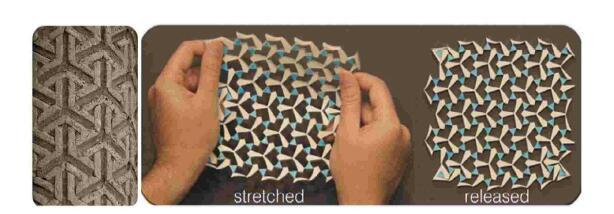 显示原图|下载原图ZIP|生成PPT
显示原图|下载原图ZIP|生成PPT图22负泊松比双稳态模型[
-->Fig. 22Bistable auxetic model[
-->
2.3 手性结构
手性结构是另一种被广泛研究的胞状负泊松比结构,Lakes[62]首次提出手性六角微观结构可具有负泊松比特性."手性"这个词最初是指物体不能与本身的镜像重合,就像人的左右手,因此称为手性结构.基本手性单元是通过将直线链(杆)沿切线方向连接到中心刚性节点形成的.根据每个刚性节点连接的切线杆的数量,可将手性结构分为三切向杆手性结构、四切向杆手性结构和六切向杆手性结构等,通过手性单元的平移阵列可以得到手性结构,如图23所示. 将手性单元通过镜像组合可形成反手性结构,如图24所示.其产生负泊松比效应的机理是:当结构横向受到压力时,刚性节点受力旋转,切向杆也随之旋转收缩产生负泊松比效应.此外,还有手性结构的变体:变换手性结构,变换手性结构是"手性"结构和"反手性"结构之间的过渡结构,如图25所示.系统中所有连杆以切线方式从圆上突出连接到节点形成"手性"单元,但是这些切线杆并不是旋转对称的,其排列顺序与每个圆 上附着的杆的数量有关[63].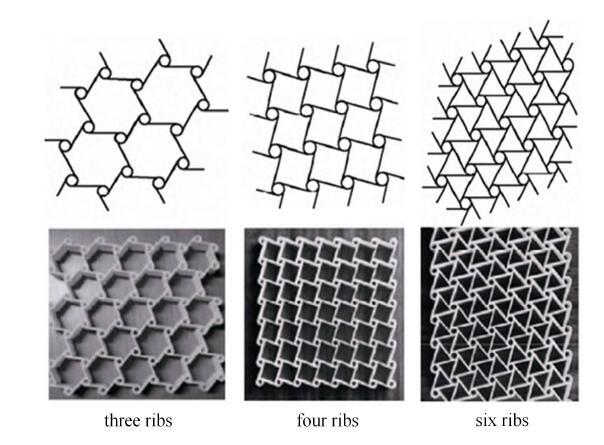 显示原图|下载原图ZIP|生成PPT
显示原图|下载原图ZIP|生成PPT图23手性结构[
-->Fig. 23Chiral structure[
-->
 显示原图|下载原图ZIP|生成PPT
显示原图|下载原图ZIP|生成PPT图24反手性结构[
-->Fig. 24Anti-chiral structure[
-->
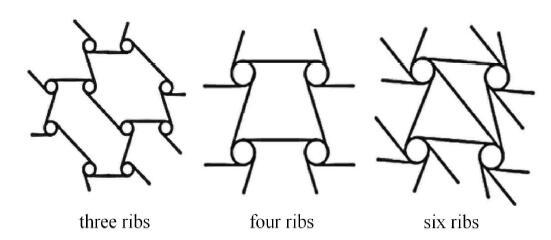 显示原图|下载原图ZIP|生成PPT
显示原图|下载原图ZIP|生成PPT图25变换手性结构[
-->Fig. 25Meta-chiral structure[
-->
构成材料的几何形状和材料性质对手性系统的力学性能具有显著影响.一般手性系统的泊松比取决于切向杆的长细比,且手性系统的刚度可以在不影响泊松比的情况下通过改变切向杆的相对刚度进行调节.此外,切向杆与节点的粘合材料用量对结构的刚度有显著影响.有****研究了平移无序排列对手性系统力学性能的影响,发现当连杆长细比足够大且无序系统中连杆整体长细比与其有序状态下对应相同时,无序排列对这些系统的泊松比的影响很小,如图26所示.
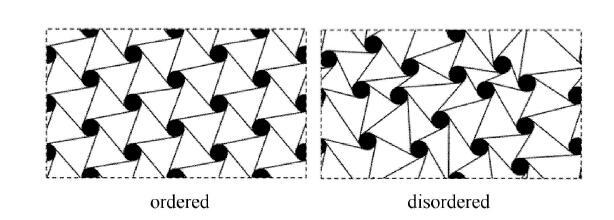 显示原图|下载原图ZIP|生成PPT
显示原图|下载原图ZIP|生成PPT图26有序和无序排列的手性系统[
-->Fig. 26Ordered and disordered chiral system[
-->
许多研究者提出了三维手性结构. Ha等[66]提出了一种负泊松比手性三维点阵结构,如图27所示.这些手性晶格由很多立方 体节点和交叉的杆件组成,杆件在外力作用下产生拉扭耦合效应使结构呈现负泊松比效应.Lu等[67]提出了一种在三个主应力方向上具有相同负泊松比的三维交叉手性结构,如图28所示.将手性材料相邻层之间通过斜杆相连可以得到三维多层手性结构,如图29所示[68],由于该结构的弹性变形主要取决于切向杆和竖向斜杆的变形,与环的形状无关,因此,环可以设计成任何形状而不影响结构的弹性模量.通过调节不同层之间斜杆的形状、角度、结构的层数等参数可以对三维手性结构的力学性能进行调节,从而达到结构性能调控和优化的目的.
 显示原图|下载原图ZIP|生成PPT
显示原图|下载原图ZIP|生成PPT图27手性点阵结构单元[
-->Fig. 27Unit cell of chiral lattice structure[
-->
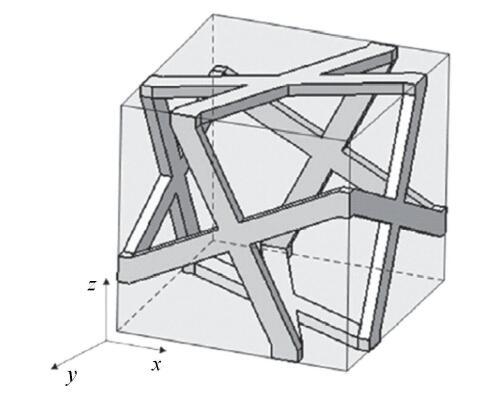 显示原图|下载原图ZIP|生成PPT
显示原图|下载原图ZIP|生成PPT图28具有三向统一负泊松比的三维交叉结构[
-->Fig. 28The cell of 3D cross structure with the uniform auxetic behaviour[
-->
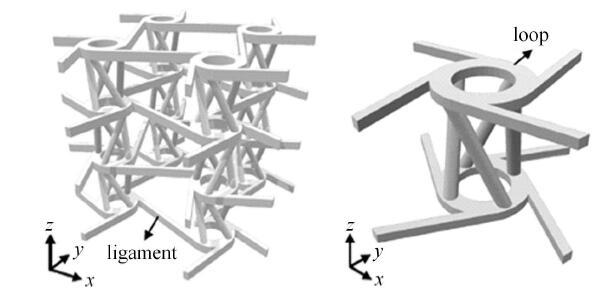 显示原图|下载原图ZIP|生成PPT
显示原图|下载原图ZIP|生成PPT图29圆形环手性负泊松比结构示意图[
-->Fig. 293D auxetic structure (CL)[
-->
此外,采用形状记忆金属制作手性结构的切向杆可获得具有形状记忆功能的新型负泊松比手性结构,它可以在没有外力作用下发生变形,如图30所示.当结构受热时,具有形状记忆功能的切向杆从原本的卷曲形状(图30(b))转变为直线(图30(a)),从而引起整体形状的扩张.图30(c)和图30 (d)为在忽略切向杆宽度的情况下结构的最大膨胀状态和完全收缩状态.此时结构的线性膨胀比为$d/(2r)$或($l^{2} - 4 r^{2})^{1 / 2} /(2 r)$,其中$l$是切向杆的长度[69].
 显示原图|下载原图ZIP|生成PPT
显示原图|下载原图ZIP|生成PPT图30手性结构收缩图例:(a)展开的三角形单元; (b)收缩的三角形单元;(c)最大膨胀状态; (d)完全收缩状态[
-->Fig. 30Contraction of chiral structures: (a) expanded triangular element;(b) compressed triangular element; (c) a single structural element at maximum extension; (d) at maximumcontraction[
-->
2.4 片状褶皱结构
片状褶皱结构的原理可用褶皱的纸张来解释,将一张褶皱的纸横向拉伸,其纵向也会随之向外扩展. Grima等[70]提出在石墨烯分子中引入空位缺陷修改石墨烯的内部结构,使碳原子向面外突出,其形状像一张褶皱的纸张,如图31中为负泊松比片状褶皱结构和石墨烯片材的典型变形模式. 显示原图|下载原图ZIP|生成PPT
显示原图|下载原图ZIP|生成PPT图31典型的褶皱片状结构: (a)不同拉力作用下褶皱纸片的变形;(b)拉力作用下引入3%内部缺陷的石墨烯薄片的变形[
-->Fig. 31Typical images of a crumpled sheet conformation: (a) a crumpled sheet of paper at different levels of applied strain; (b) a graphene sheet with 3% defects at different levels of applied strain[
-->
Javid等[71]提出了一类具有周期性球形波纹的非孔隙负泊松比材料,其负泊松比行为是由球形波纹的面外变形引起的. 图32为该无孔负泊松比材料在单轴拉伸下的数值模拟结果,此类波纹片材由于没有孔洞因而具有低应力集中的特性.
 显示原图|下载原图ZIP|生成PPT
显示原图|下载原图ZIP|生成PPT图32球形波纹片在拉伸变形下的数值模拟结果[
-->Fig. 32A typically numerical result of tensile deformation[
-->
许多研究人员从日本的剪纸艺术中得到启发,剪纸结构中的负泊松比效应与纸张中的折痕网络结构相关,许多研究者对材料和各种变量如何影响剪纸结构的负泊松比行为进行了研究[72]. 最典型的剪纸结构有Miura-ori图案的纸片结构[73]和渐变蜂窝剪纸结构[74]等. 还有研究者根据剪纸艺术原理设计了一类可用于变体结构等领域的胞状超材料[75].
此外,Chen等[76]使用聚醚醚酮薄膜研发了具有零泊松比的弯曲SILICOMB蜂窝结构,该结构可满足大变形的需求. Zhang等[77]研发了一种将管材和波纹片组合形成的负泊松比结构,如图33所示,并推导了其负泊松比公式.
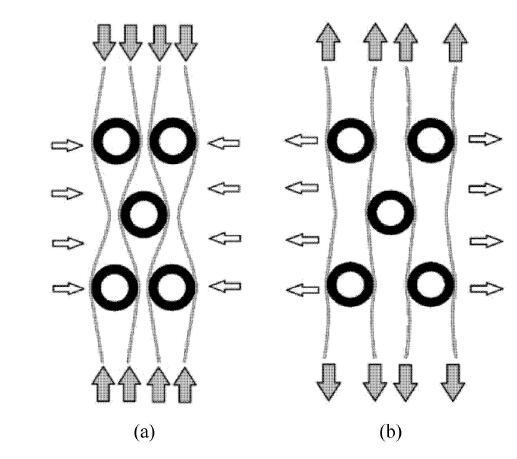 显示原图|下载原图ZIP|生成PPT
显示原图|下载原图ZIP|生成PPT图33波形板负泊松比结构: (a)受压; (b)受拉[
-->Fig. 33Auxetic structure with corrugated sheets: (a) under compression; (b) under extension [
-->
2.5 穿孔板结构
将不同形状和分布的切孔布置在薄片结构中,可以生成具有不同微结构的穿孔板结构. 穿孔板结构具有很大的灵活性,在一定程度上可以看作是前文提到的几种结构模型的延伸,通过设置特定的切孔形状可以得到如手性结构、内凹蜂窝结构等不同的胞元结构. 而具有不规则分布的穿孔、多级穿孔的平板机构赋予了穿孔板结构更多的设计灵活性.Grima等[78]率先提出了含有菱形或星形穿孔的二维材料在拉伸和压缩时可表现出负泊松比行为. 图34为几种典型的菱形穿孔板结构,具有横纵向不同的穿孔大小和穿孔角度,其中菱形穿孔平行于坐标轴泊松比的函数方程可表示如下
$$ \nu _{xy} = \left( {\nu _{yx} } \right)^{ - 1} = \dfrac{\alpha ^2\cos ^2 \dfrac{\theta }{2} - b^2\sin ^2 \dfrac{\theta }{2} }{\alpha ^2\sin ^2 \dfrac{\theta }{2} - b^2\cos ^2 \dfrac{\theta }{2} } (15)$$
式中,$a$和$b$为菱形的边长, $\theta$为菱形相邻两边的夹角.
星型穿孔板在拉力和压力作用下的变形机理如图35所示. 于靖军等[79]综合分析了不同切缝形状的穿孔板结构,并分析了直线型和"I"型穿孔板结构的变形机理,如图36所示.
 显示原图|下载原图ZIP|生成PPT
显示原图|下载原图ZIP|生成PPT图34菱形负泊松比穿孔板结构典型案例[
-->Fig. 34Examples of perforated sheets which may have negative Poisson's ratio[
-->
 显示原图|下载原图ZIP|生成PPT
显示原图|下载原图ZIP|生成PPT图35星型结构变形机理[
-->Fig. 35Deformation mechanism of star-shaped structure[
-->
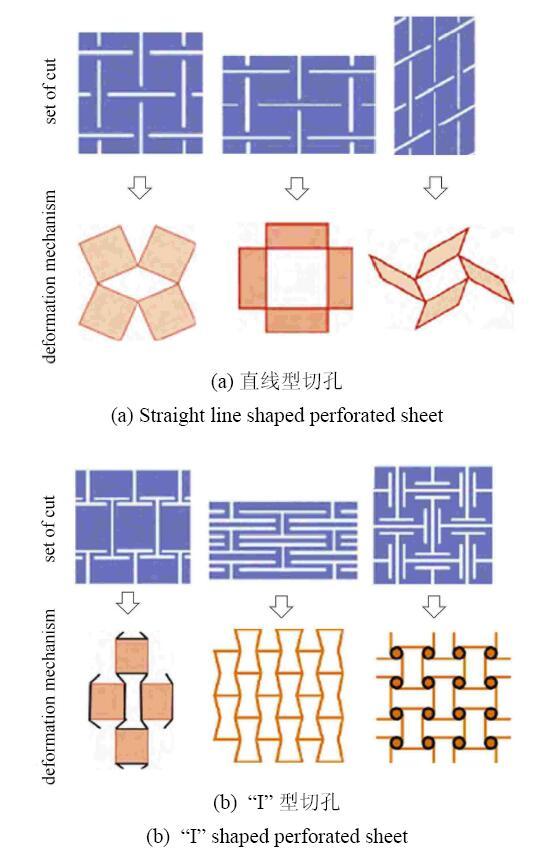 显示原图|下载原图ZIP|生成PPT
显示原图|下载原图ZIP|生成PPT图36不同切缝形状的穿孔板结构变形机理[
-->Fig. 36Deformation mechanism of perforated sheets structure with different cut shapes[
-->
结构高度对称性并不是结构具有负泊松比的必要条件,如图37所示的穿孔结构,尽管在分布上存在无序性和随机性,但该穿孔板结构仍然具有负泊松比特性[80]. 这一重大发现极大地提高了设计负泊松比材料的自由性.
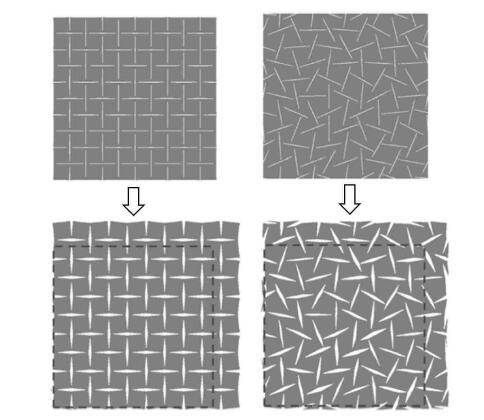 显示原图|下载原图ZIP|生成PPT
显示原图|下载原图ZIP|生成PPT图37有序和无序排列的穿孔板结构[
-->Fig. 37Ordered and disordered perforated structure[
-->
最近,Tang等[81]提出了一种采用多级概念设计负泊松比穿孔结构方法,具有高设计等级的结构在拉伸和压缩性能方面更具优势,图38(a)和图38(b)分别为一级和二级矩型穿孔板在拉力作用下的变形机理,图38(c)和图38(d)分别为一级和二级的方型穿孔板在拉力作用下的变形机理.
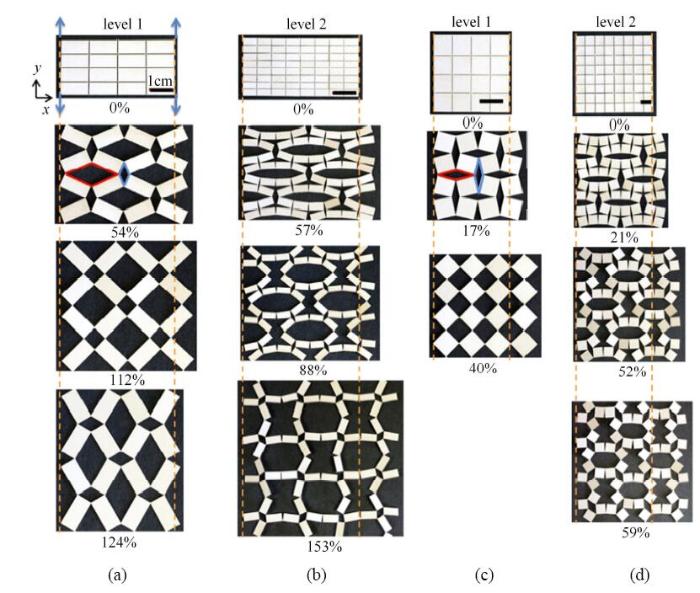 显示原图|下载原图ZIP|生成PPT
显示原图|下载原图ZIP|生成PPT图38不同级矩形和方形穿孔板在拉力作用下的变形[
-->Fig. 38Deformation of different rectangular and square perforated sheets under tension[
-->
2.6 联锁多边形结构
联锁多边形结构由规则周期排列的多边形刚体组成.其变形机理是:相邻刚体之间通过多边形各边的凹凸点进行连接,当结构受到拉力作用时,各刚体发生横向移动带动结构各连接处发生相对滑动,引起结构的整体扩张,从而产生负泊松比效应.典型的联锁六边形结构[83]如图39所示.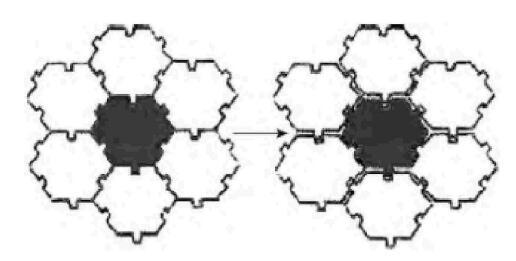 显示原图|下载原图ZIP|生成PPT
显示原图|下载原图ZIP|生成PPT图39联锁六边形结构[
-->Fig. 39Interlocking hexagons model[
-->
Magnox 反应堆芯部[84]是典型的连锁四边形结构,是成功将负泊松比效应运用于实际工程的实例之一,其泊松比可以达到$-1$,如图40所示. Magnox反应堆芯部的作用在于最大程度地减小了由地震作用产生的剪力,同时允许结构能够在一定程度上自由活动.
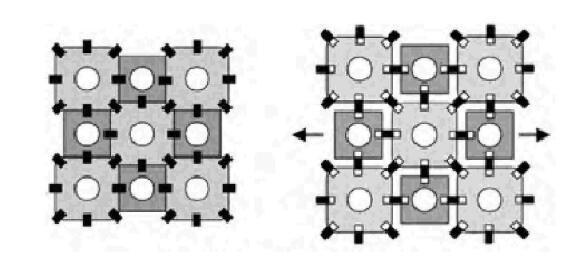 显示原图|下载原图ZIP|生成PPT
显示原图|下载原图ZIP|生成PPT图40联锁四边形结构-Magnox反应堆芯部[
-->Fig. 40Quadrilateral model-Magnox reactor model[
-->
2.7 纺织材料相关结构
各类负泊松比纤维、纱线和织物的出现,带来了纺织领域的革新. Evans研究团队[85]提出了由内旋的微胞和弯曲的原纤 构成的微观结构,该结构具有高度的各向异性.并提出了三段式拉伸理论:初始状态下颗粒和与其连接的原纤紧密排列在一起(图41(a));当将原纤沿长度方向拉伸时,颗粒沿垂直于纤维方向错位抬起而膨胀(图41(b));进一步拉伸时,内旋的微胞沿垂直于纤维方向竖向抬起进一步发生膨胀图(41(c)),完全膨胀状态下的结构如图41(d)所示. 在此基础上,研究得到节点$\!$-$\!$-$\!$纤维结构[86],其泊松比大小与结构参数、纤维拉伸和转动刚度有关. 2001年,Alderson等[87]通过改变传统的纺织工艺成功地研发了负泊松比聚丙烯纤维,其微胞$\!$-$\!$-$\!$原纤结构如图42所示.纤维由阴影部分的微胞通过原纤相互连接形成,当结构沿原纤方向受拉时,微胞将沿垂直于原纤方向向外移动从而引起结构整体膨胀.Ravrala等[88]在2006年成功研发了泊松比为$-0.72 \sim -0.05$的负泊松比聚酯纤维.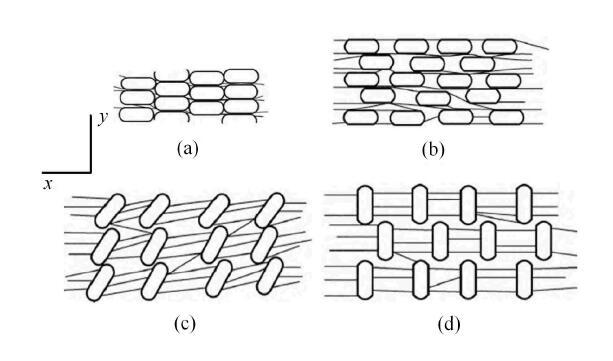 显示原图|下载原图ZIP|生成PPT
显示原图|下载原图ZIP|生成PPT图41微胞原纤结构三段式拉伸理论[
-->Fig. 41Schematic diagram of structural changes of PTFE under tension$^{ [
-->
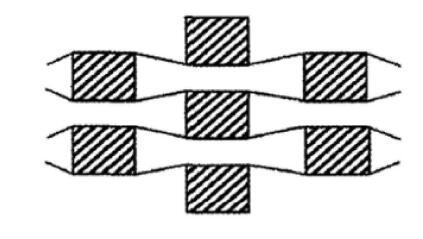 显示原图|下载原图ZIP|生成PPT
显示原图|下载原图ZIP|生成PPT图42负泊松比聚丙烯纤维微胞$\!$-$\!$-$\!$原纤模型[
-->Fig. 42Microcell-fibril schematic model of helical auxetic polypropylene[
-->
通过设计纱线的内部构造可以得到负泊松比纱线. 图43为Miller等[89]研制的负泊松比纱线,纱线由弹性模量较小的芯纱和弹 性模量较大的包缠纱组成.当纤维受到拉伸时,外部的包缠纱由于弹性模量较大因而伸长量较小;芯纱由于弹性模量较小因而伸长量较大.由于伸长量的差异,最后结构的两种纱线的位置发生了互换从而引起纱线整体截面变粗. Wright等[90]对上述纱线进行了力学性能试验研究,结果表明:纱线的负泊松比主要受芯纱和缠绕纱的初始拉伸模量、直径比、初始缠绕角度及原料本身泊松比值等因素的影响. Miller等[91]应用此负泊松比纱线研制出了单向负泊松比材料,其负泊松比值可达到$-6.8$.
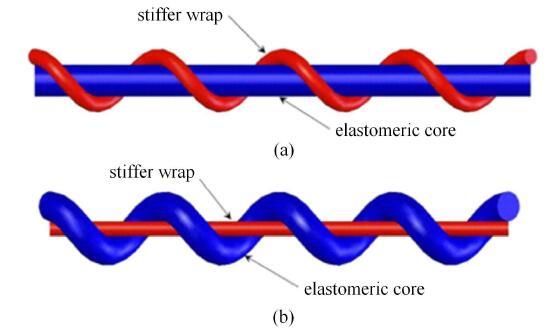 显示原图|下载原图ZIP|生成PPT
显示原图|下载原图ZIP|生成PPT图43负泊松比纱线图解: (a)未拉伸; (b)拉伸[
-->Fig. 43Structure of auxetic yarn: (a) un-stretched auxetic yarn; (b)stretched helical auxetic yarn[
-->
目前负泊松比织物的实现方法有两种:一种是通过负泊松比织线制成负泊松比织物;另一种是采用普通织线,通过设计织物结构并通过经编或横编等方法生产具有内凹结构、旋转结构和折叠结构的负泊松比织物[92-93]. Blaga等[94]究了一种具有折叠展开机制的负泊松比织物,并讨论了原料等因素对针织物折叠效果的影响,如图44所示,研究表明添加聚酰胺长丝、增加线圈密度和提高织物紧密度更能使织物发生折叠,从而使织物产生更明显的负泊松比效应.
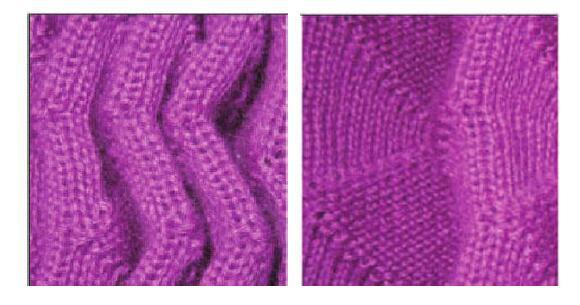 显示原图|下载原图ZIP|生成PPT
显示原图|下载原图ZIP|生成PPT图44应力下展开的毛/聚丙烯腈折叠织物[
-->Fig. 44Wool/PAN folded fabric stretched under stress[
-->
葛朝阳等[95]对图45所示的三维针织结构进行了理论推导和试验研究,并取代表性单元推导了其泊松比的表达式,该结构由经纱、纬纱及捆绑纱组成.研究结果表明:该三维针织结构在一定应变范围内具有负泊松比特性,且负泊松比效应受纱线半径、相邻经纱间的水平距离、纱线弹性模量等因素的影响.
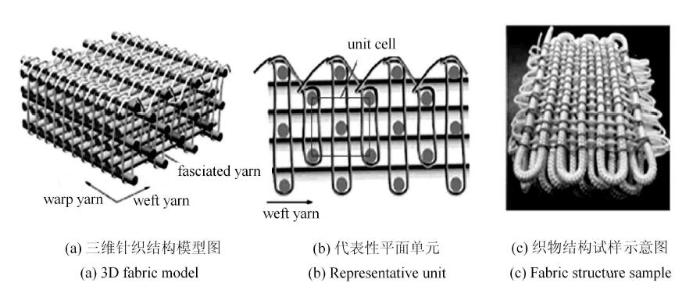 显示原图|下载原图ZIP|生成PPT
显示原图|下载原图ZIP|生成PPT图45三维针织结构示意图[
-->Fig. 453D knitted structure[
-->
常玉萍等[93]采用涤纶和丙纶为原料设计了如 图46所示的3种不同结构的织物.试验中2#织物的负泊松比效应最明显.织物的负泊松比效应和断裂强度均具有各向异性,在90$^\circ$方向上具有最佳的负泊松比效应和断裂强度;相同材料制成的织物由于内部结构差异而具有不同的负泊松比特性.此外,常玉萍等[96]选用了涤纶低弹丝和锦纶通过不对称编织得到具有负泊松比效应的六角网眼旋转结构,如图47所示,原本规整的六角网眼结构由于不对称编织导致受力不平衡而发生规律性左右歪斜.当受到拉力作用时,歪斜的六角网眼结构就会发生旋转展开,恢复至原本规整的六角网眼状态从而产生负泊松比效应.织物的负泊松比效应随六角网眼结构左右歪斜程度提高而愈加明显. 2017年,常玉萍等[97]研究了不同六角网眼结构织物[96,98-99]的负泊松比、拉伸性能与能量吸收性能之间的关系,并结合织物的断裂形态分析其拉伸断裂过程.
 显示原图|下载原图ZIP|生成PPT
显示原图|下载原图ZIP|生成PPT图46织物仿真结构图[
-->Fig. 46Fabric simulation structure[
-->
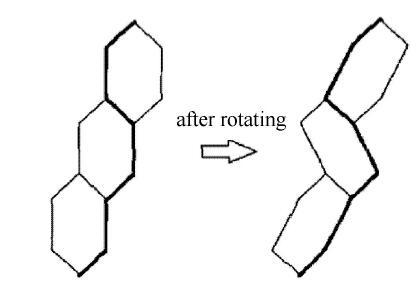 显示原图|下载原图ZIP|生成PPT
显示原图|下载原图ZIP|生成PPT图47旋转变形六角网眼结构[
-->Fig. 47Rotating tulle net structure[
-->
Boakye等[100]采用尼龙、PES和棉线三种材料分别织造了负泊松比针织样品,见图48,研究表明由于尼龙织物具有比其他两种材料织物更小的 初始折叠角度,因此具有更高的负泊松比效应. Ali等[101]采用常规棉线和弹性纤维编织出了负泊松比织物,并将其与常规织物作比较,研究表明,负泊松比织物比常规正泊松比织物更具舒适性及压阻特性,负泊松比织物的透气性比常规织物提高了182%,并具有孔隙率可变(拉伸下孔隙率增大)的特性,具有潜在的医用价值.
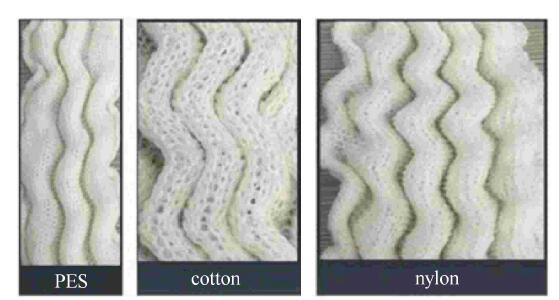 显示原图|下载原图ZIP|生成PPT
显示原图|下载原图ZIP|生成PPT图48三种材料织造样品[
-->Fig. 48Weaving samples of three materials[
-->
2.8 其他结构
Smith等[103]提出了一种新型交错杆结构,如图49(a)所示.通过与传统负泊松比结构的比较以及试验分析发现,交错杆结构更适用于预测聚氨酯泡沫的泊松比和应力$\!$-$\!$-$\!$应变关系.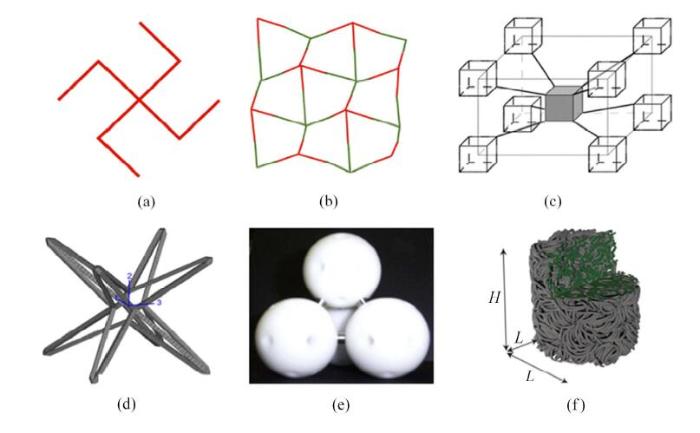 显示原图|下载原图ZIP|生成PPT
显示原图|下载原图ZIP|生成PPT图49负泊松比结构: (a)交错杆结构[
-->Fig. 49Auxetic models: (a) the missing rib model[
-->
如图49(b)所示,Grima等[104]提出了由凹凸不平的正方形网格中的四爪结构构成"蛋架"结构,四爪结构呈金字塔状,当结构受到拉伸时,四爪结构的4个杆件向外撑开,使结构产生负泊松比效应.
Gaspar等[105]提出了一种新型三维节点连杆结构,如图49(c)所示.结构的负泊松比行为主要是由两两相连的直杆弯曲引起的.
Dirrenberger等[106]提出了一种六面体结构,如图49(d)所示,该结构具有优异的压陷阻力,且具有轻量化特点.
Pasternak等[107]提出了一种负泊松比球形连杆结构,如图49(e)所示,其理论泊松比值为$-1$,但试验测试表明球连杆结构的泊松比值与理论值稍有差异. Rodney等[108]提出了一种由线缠绕制成的简易三维材料,在拉伸和压缩过程中表现出相当大的负泊松比特性,如图49(f)所示.
3 金属负泊松比材料和结构
本节中将具有负泊松比特性且基材为金属的材料和结构定义为金属负泊松比材料和结构,主要包括具有负泊松比微观结构的金属、负泊松比泡沫金属、以金属为基材制作的负泊松比物件.虽然在微观结构下,许多立方金属元素沿[110]方向拉伸时具有负泊松比特性,但宏观尺度上提及的金属材料尤其是在的大应变下具有负泊松比性能的金属材料和结构极少.金属材料可有效提高负泊松比多孔材料的强度和刚度,因此研究金属负泊松比材料可进一步拓展负泊松比材料和结构的应用.泡沫铜是最早被研究的负泊松比金属泡沫材料之一[109],Li等使用共振超声波谱进一步研究了负泊松比泡沫铜的性能,观察到测试样品在永久压应变下的最小泊松比约为$-0.7$[110].
Zhang等[111]采用理论分析和试验探讨了铁镓合金和铁铝合金的拉伸性能,并采用密度泛函确定两种合金的负泊松比效应,研究表明:这两种合金的负泊松比效应均由弹性各向异性引起.此外,作者通过理论推导预测铁锗合金Fe$_{75}$Ge$_{25}$具有低至$-0.9$的负泊松比值.
Schwerdtfeger等[112]使用选择性电子束熔炼法制造钛合金Ti-6Al-4V基材试样,研究发现该结构的泊松比主要取决于结构的 相对密度.Mitschke等[113]采用同样的方法制造了钛合金Ti-6Al-4V线弹性多孔结构,通过拉伸试验测量其线弹性,观察到其负泊松比值为$-0.75$.
Dirrenberger等[114]对负泊松比金属微结构进行了全应力场模拟,发现结构的负泊松比效应持续存在且在塑性屈服阶段变得更强.Taylor等[115]通过铝蜂窝板实验证明了低孔隙率周期性穿孔金属结构可表现出负泊松比特性,如图50所示.
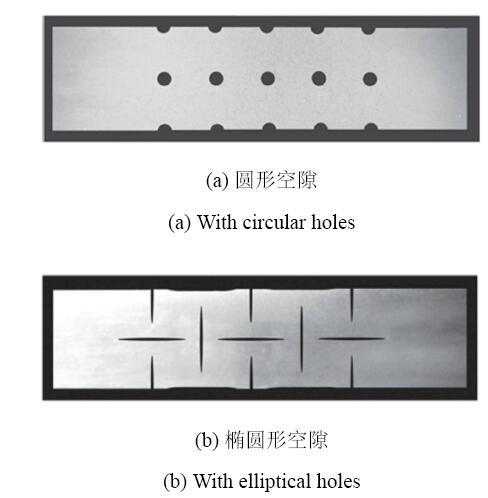 显示原图|下载原图ZIP|生成PPT
显示原图|下载原图ZIP|生成PPT图50未变形的不同空隙结构[
-->Fig. 50Samples comprised of different cavities in the undeformed configuration[
-->
过去大多研究者认为材料和结构的负泊松比特性主要取决于几何构型而不是化学成分或基础材料性质.而Ren等[116-117]的 研究工作表明:基材对负泊松比超材料和三维管状结构的负泊松比行为有着显著的影响.通过对负泊松比超材料和负泊松比管状结构的数值模拟和试验研究发现,当采用金属作为基材时,由屈曲诱导的三维负泊松比超材料和负泊松比管状结构的负泊松比效应将会消失.为了恢复负泊松比效应,本团队开发了设计三维金属负泊松比超材料和负泊松比管状结构的新方法,如图51所示,可以概括为以下4个步骤:设计用于诱导屈曲的三维负泊松比超材料或负泊松比管状结构;采用线弹性基材对三维负泊松比超材料或负泊松比管状结构有限元模型进行屈曲分析;选取三维负泊松比超材料或管状结构的理想屈曲模式;在理想屈曲模式下,调整典型体积元素的几何形状,同时在三个轴向方向上改变典型体积元素形成三维金属负泊松比超材料或负泊松比管状结构.
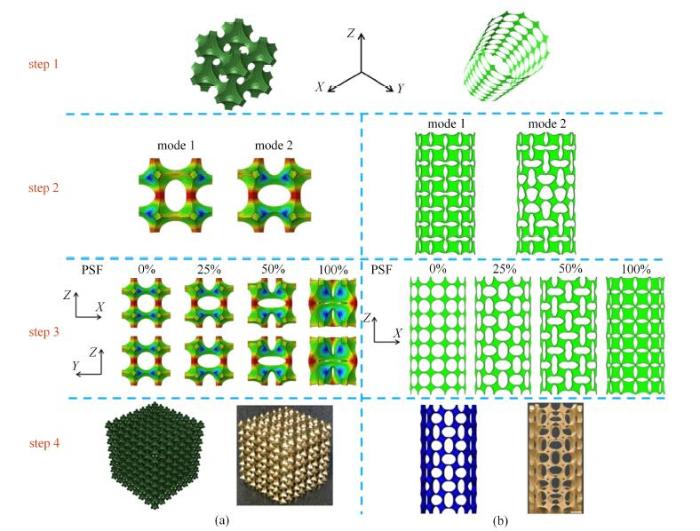 显示原图|下载原图ZIP|生成PPT
显示原图|下载原图ZIP|生成PPT图513D金属负泊松比材料和管状结构的生成方法:(a)负泊松比金属材料[
-->Fig. 51Methodology of generating 3D metallic auxetic metamaterials and 3D metallic tubular structures: (a) 3D metallic auxetic metamaterial[
-->
与传统的负泊松比材料相比,三维金属负泊松比超材料和三维负泊松比管状结构具有优异的力学性能,最显著的优点之一是这些结构的力学性能可以通过模态比例因子(PSF)这一单一参数进行调整,且这些结构可以在压力和拉伸作用下表现出负泊松比行为.当PSF的某个值(文中提出的模型PSF为60%[116-117]被引入初始几何结构时,所设计的结构甚至可以在压力和拉力作用下具有几乎相同的负泊松比性能,这种性能对于传 感器和智能过滤器等的研发至关重要.另一个优点是采用金属基材使三维金属负泊松比材料在力学性能方面具有更高的强度和硬度.此外,此类三维金属负泊松比材料可以在大应变范围内依然保持负泊松比特性,因此, 这些负泊松比材料可以产生大的拉胀效应.良好的几何对称性是另一显著优点,在某些情况下,材料的对称性和高精度是至关重要的,例如在三维传感器的应用中.
4 多重负泊松比材料和负泊松比复合材料
本文将由多种普通基材组成的负泊松比材料称为多重(多材料)负泊松比材料;将由负泊松比材料和非负泊松比材料复合形成的负泊松比材料称为负泊松比复合材料.研究多重负泊松比材料和负泊松比复合材料,能够将负泊松比特性与其他材料具备的优异性能相结合,更好地发挥材料优势.4.1 多重负泊松比材料
Hiller等[118]率先采用两种普通材料密集组合形成多重负泊松比数字材料,如图52(a)所示.理论上,任何具有一定刚度和弹 性的材料组合均可以具备负泊松比性能.如图52(b)所示,由68%铝、48%丙烯酸和8%空隙组成的6$\times $8$\times $8$\times$2数字材料产生了最小为$-0.63$的负泊松比值.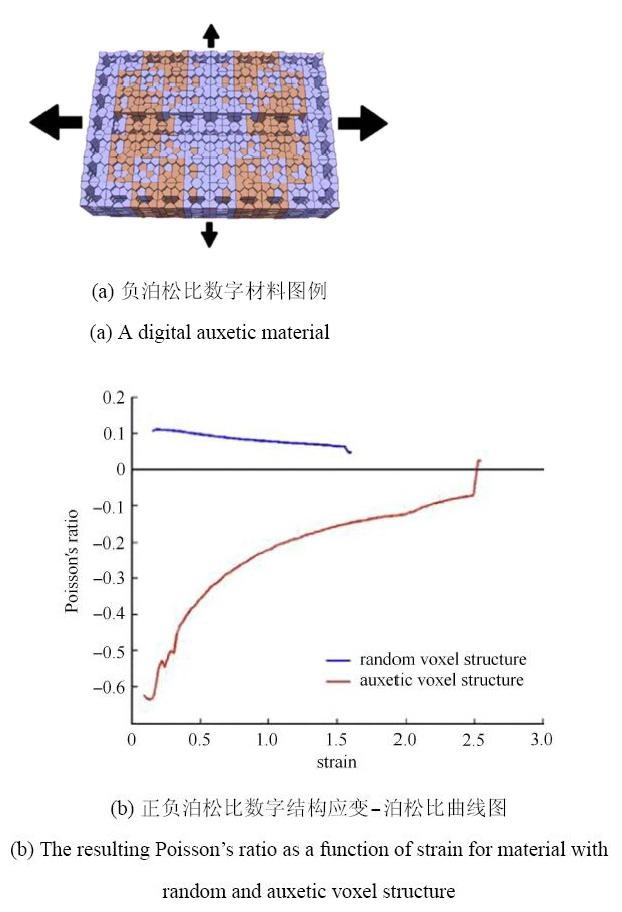 显示原图|下载原图ZIP|生成PPT
显示原图|下载原图ZIP|生成PPT图52负泊松比材料数字材料[
-->Fig. 52Images of a digital material with negative Poisson's ratio[
-->
Wang等[119]采用计算机辅助设计和3D打印技术设计和制造了一些双重负泊松比超材料,它们的力学性能与由单一材料构成的负泊松比材料相比有着明显差别,随着另一种材料的引入,超材料的力学性能在不改变负泊松比胞体整体几何结构的情况下得到很大改善.
此外,Vogiatzis等[120]采用拓扑优化方法设计和制造了具有多重物理特性的负泊松比材料,并且采用数值模拟和实验验证了该材料的负泊松比特性.
4.2 复合负泊松比材料
现有的复合负泊松比材料的研究主要基于4个方面[47]:(1)通过特定角度层压板的叠合生成负泊松比材料;(2)通过引入负泊松比内材或基材来生产负泊松比复合材料;(3)研究和评价负泊松比复合材料的性能;(4)负泊松比复合材料的制造工艺.将具有负泊松比特性的层压板按照特定的角度与普通层压板进行叠合可形成负泊松比层压纤维复合材料[121],某些典型的层 压纤维复合材料如非平衡双向层压板的泊松比最小值为$-0.369$[122],二维双向六角对称复合材料的泊松比接近于$-1$[123].复合材料层压板的泊松比可正可负,主要取决于纤维的方向[124].此外,通过设计组成材料在不同长度方向和层间的分布,可以生成泊松比接近$-1$的弹性各向同性二维和三维复合材料.负泊松比材料可以显著增强复合材料的刚度,减小板块间的横向位移[125].
负泊松比材料既可以用作复合材料的基材,也可用作复合材料的增强纤维. Nkansah等[126]研究发现:将负泊松比材料用作连 续纤维复合材料的基材可以在不降低纵向模量的情况下提高材料横向复合模量.而在普通基材中加入负泊松比纤维时,由于负泊松比纤维受拉膨胀而不易被拉出[121].
通过将负泊松比材料与其他材料相结合,可有效改善材料的某些力学性能. Zorzetto等[127]通过将两种泊松比值相差巨大的胞状结构相结合生成了一种新型的建筑复合材料,他们发现加入少部分的负泊松比内凹材料(约12%)可以在整体相对密度不变的情况下显著增加其刚度(300%). Zahra等[128]通过将负泊松比材料加入水泥复合材料的方法有效改善了其分层和脆性.Hu等[129]将水凝胶和负泊松比材料相结合制备了新型弹性水凝胶$\!$-$\!$-$\!$负泊松比复合材料,他们发现凝胶可以暂时修复基材的断裂带和裂缝.
5 负泊松比材料和结构的性质
5.1 弹性模量与剪切模量
负泊松比材料比传统材料具有更高的抗剪强度. 根据经典弹性理论[130],三维各向同性材料的力学参数弹性模量($E)$、剪 切模量($G)$、体积弹性模量($K)$和泊松比($\upsilon$)可以由其中的任意两个参数进行表示. 三维情况下,这些参数之间的关系可以表达为[131]$G = \dfrac{3K(1 - 2\nu )}{2(1 + \nu )} (16)$
$G = \dfrac{E}{2(1 + \nu )} (17)$
从 式(17)可以看出,当泊松比减小时,剪切模量将会增大,引起材料抗剪承载力的增强. 图53为材料的弹性模量$E$、剪切模量$G$与泊松比$\upsilon $关系. 图中各向同性材料的泊松比在$- 1$到0.5之间. 当泊松比的值接近$ -1$时,剪切模量将趋向无穷大,此时材料极易压缩,但几乎不发生剪切变形.
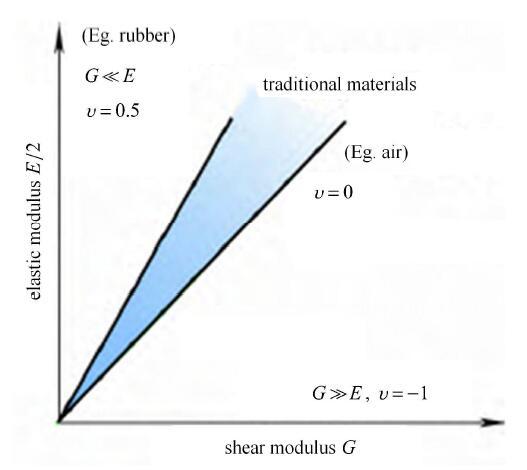 显示原图|下载原图ZIP|生成PPT
显示原图|下载原图ZIP|生成PPT图53弹性模量$E$、剪切模量$G$与泊松比$\nu $之间的关系[
-->Fig. 53Relationship of elastic material $E$, shear modulus $G$ and $\nu $[
-->
5.2 压痕阻力/抗冲击性能
在局部冲击载荷作用下,传统正泊松比材料沿压力方向被压缩并沿垂直载荷方向向四周扩展,如图54(a)所示.相反,如果对各向同性负泊松比材料施加同样的压力,材料竖向发生收缩的同时横向也会收缩,使材料向受冲击的区域汇集,材料的局部密度瞬间增大,具有抵抗压痕的效果,如图54(b)所示. Lakes等[132]采用全息干涉法研究了泡沫体的压陷阻力,研究包括传统结构和负泊松比内凹结构.根据经典的弹性理论,压陷阻力与材料硬度($H)$密切相关,它与泊松比的关系可以表达为$$H = \alpha \left[ {\dfrac{E}{\left( {1 - \nu ^2} \right)}} \right]^\gamma (18)$$
式中,$E$为弹性模量, $\upsilon $为基材泊松比, $\gamma $在均布载荷作用下取1,在集中载荷作用下为2/3.从式(18)可以看出, 当 $\upsilon $ 接近$ - 1$时,压陷阻力将达到无穷大[133]. 当$\upsilon$达到三维负泊松比材料的最大泊松比值0.5时,压陷阻力将大幅降低. 此外,Dirrenberger等[106]采用数值模拟在圆柱体和球体上进行了压痕测试,研究表明:负泊松比材料在特定强度条件下的压痕阻力优于蜂窝结构.这种特性可应用于防弹装备,Yang等[134]对铝泡沫夹芯板和负泊松比蜂窝芯板的防弹性能进行了数值模拟,由于具有负泊松比特性的材料在受冲击时,材料会向受冲击区域聚集,因此防弹性远远优于铝泡沫夹芯板.
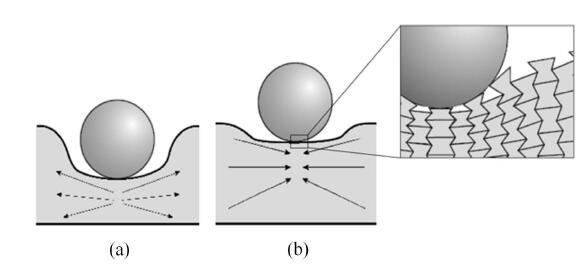 显示原图|下载原图ZIP|生成PPT
显示原图|下载原图ZIP|生成PPT图54压陷反应:(a)传统材料; (b)负泊松比材料
-->Fig. 54Indentation behaviours: (a) conventional material; (b) auxetic material
-->
5.3 抗断裂性
研究发现负泊松比材料具有比传统材料更好的抗断裂性[7,135],并且负泊松比材料的裂纹更不易发展[136].Donoghue等[137]通过试验研究发现,负泊松比层压板中裂缝发展需要更多的能量.与非负泊松比材料相比,负泊松比材料具有其几乎两倍的抗断裂性[138].同样地,负泊松比复合材料的抗断裂性几乎是传统复合材料的两倍[139].5.4 曲面同向性
当对材料施加平面外弯矩时,会产生横向曲率.传统材料会产生马鞍形的变形,其横向曲率与弯曲主曲率方向相反,如图55(a)所示.而负泊松比材料会产生拱形变形,其横向曲率与主曲率方向一致,如图55(b)所示,这种拱形变性特征也称为曲面同向性.对于纯弯作用下的板或者梁,在变形时若发生拱形变形可以有效的减轻损伤,这种罕见的特性在医疗领域也具有广泛的应用潜力. 显示原图|下载原图ZIP|生成PPT
显示原图|下载原图ZIP|生成PPT图55面外弯曲下材料的变形模式:(a)马鞍形(正泊松比); (b)拱形(负泊松比)[
-->Fig. 55Deformation patterns for non-auxetic and auxetic materials under out-of-plane bending: (a) saddle shape (non-auxetic); (b) dome shape (auxetic)[
-->
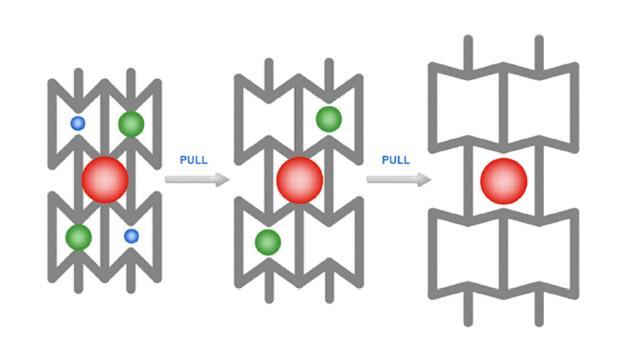 显示原图|下载原图ZIP|生成PPT
显示原图|下载原图ZIP|生成PPT图56可变渗透率的智能过滤器[
-->Fig. 56Smart filters to demonstrate the variable permeability[
-->
5.6 吸能和隔振
吸能隔振是多孔材料的普遍优点,而负泊松比多孔材料由于其特殊的内部构造和特殊的变形特性较传统多孔材料更具优越性,可有效降低冲击力. 图57比较了正泊松比蜂窝结构和负泊松比蜂窝结构在单向压缩下的应力应变曲线.在加载初期,正泊松比蜂窝结构应力随应变呈线性增长,而负泊松比蜂窝结构的弹性模量逐渐增大,到了应力平台阶段,负泊松比蜂窝结构具有更高的应力平台,其应力$\!$-$\!$-$\!$应变曲线与横坐标轴的包络面积较大,表明负泊松比材料具有更优的吸能特性.此外,对于多级蜂窝材料,其吸能特性受级数的影响,级数$n$增大时,能量吸收性能会随之增强[144].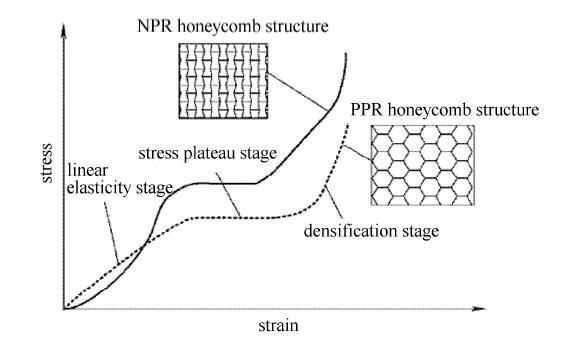 显示原图|下载原图ZIP|生成PPT
显示原图|下载原图ZIP|生成PPT图57蜂窝结构的应力$\!$-$\!$-$\!$应变曲线[
-->Fig. 57The stress-strain curve of honeycomb structure[
-->
这种特性可用于抵抗爆炸冲击载荷,与块体材料和普通蜂窝材料相比,负泊松比复合材料表现出相当大的优势.在爆炸载荷 作用下负泊松比复合材料在塑性变形阶段可吸收的冲击能量为块体材料的两倍[146].与等效蜂窝复合板相比,负泊松比复合板的冲击波得到有效降低,能量吸收性能大大改善[147].
6 负泊松比材料和结构的应用
负泊松比材料和结构由于其特殊的力学特性而具有诸多优异的性能,如优越的抗剪性、抗断性、抗凹痕性、吸声和吸能性、曲面同向性等[148-150].负泊松比材料的出现为智能材料的创新提供了一条途径,在许多领域具有广阔的应用前景[151-153]. Prawoto[154]总结了负泊松比材料在各个行业[6, 21, 109, 151, 155-156]的应用,如表1所示.Table 1
表1
表1负泊松比材料和结构的应用
Table 1Summary of the applications of the auxetic materials
 |
新窗口打开
6.1 医疗应用
在医疗应用方面,负泊松比材料可用于开发智能医用装置,例如食道支架[157-158]、血管支[159-161],心脏瓣环[162]、智能医用绷带[98]和智能脉搏监测器[163]等.食道癌被认为是世界上最严重的九大癌症之一,食道癌患者的食道中有阻碍食物通过的肿瘤,而负泊松比支架可用于扩张食道,有效缓解患者疼痛,从而延长病人的寿命,如图58所示. 目前已研发出各种结构的负泊松比支架,如Ali等[157]设计并制造了一种用于食道癌缓解治疗和预防患者吞咽困难的聚氨酯薄膜结构食道支架,拉伸试验中得到的负泊松比聚氨酯膜的泊松比为$-0.87$至$-0.963$,在气囊导管的压力作用下,负泊松比食管支架的直径从0.5,mm增大到5.73,mm,而支架的长度从0.15,mm增大到1.83,mm[158]. Gatt等[164]基于多级旋转刚性负泊松比系统,采用两级旋转刚性正方形结构设计了负泊松比支架,如图59所示,该支架可有效减小支架与身体的实际接触面积,大大降低接触部位炎症发生的概率.
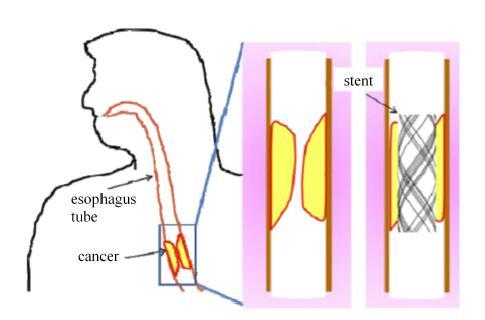 显示原图|下载原图ZIP|生成PPT
显示原图|下载原图ZIP|生成PPT图58负泊松比食道支架[
-->Fig. 58Auxetic esophagus stent[
-->
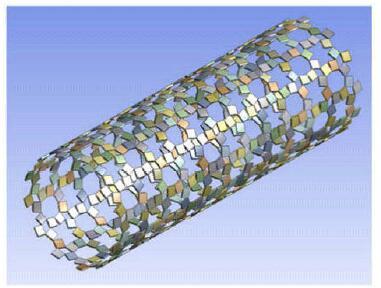 显示原图|下载原图ZIP|生成PPT
显示原图|下载原图ZIP|生成PPT图59多级负泊松比食道支架[
-->Fig. 59Hierarchical auxetic esophagus stent[
-->
负泊松比材料还可以用于制造智能医用绷带[98],它的工作机理是:当伤口肿胀时,内含药物的负泊松比绷带受到张力作用而截面变大,其储存在网格内的药剂被释放作用于伤口,达到治疗效果;而当伤口消除肿胀后,绷带会收缩从而停止释放药物.理想状态下,这种绷带具有根据伤口严重程度智能控制药物释放量的功能,如图60所示.此外,采用负泊松比织物制成的绷带,由于其特有的曲面同向性,可以有效缓解肿胀区域的压力.
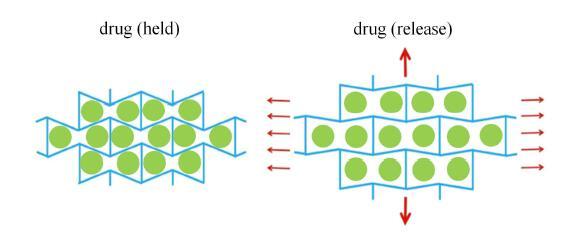 显示原图|下载原图ZIP|生成PPT
显示原图|下载原图ZIP|生成PPT图60负泊松比医用绷带
-->Fig. 60Auxetic medical bandage
-->
采用负泊松比材料制造的脉搏监测传感器,与传统材料制成的传感器相比,其灵敏度提高了24倍[163],图61为基于负泊松 比材料的脉搏监测传 感器.
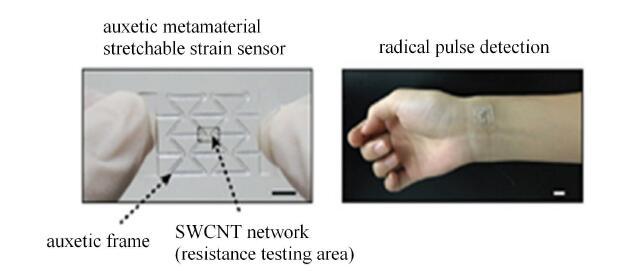 显示原图|下载原图ZIP|生成PPT
显示原图|下载原图ZIP|生成PPT图61基于负泊松比材料的脉搏监测传感器[
-->Fig. 61Auxetic pulse detection[
-->
6.2 缓冲和保护装备
采用负泊松比多孔材料制作缓冲和保护装置,例如缓冲垫[16]、手套、头盔[47]和座椅[166]等,具有比传 统材料更轻薄和吸能效果更好的特点,在起到保护作用的同时还可以为使用者提供更好的舒适性.Foster等[167]研究了使用聚氨酯负泊松比泡沫作为运动头盔中的贴合层减小冲击加速度的可行性.通过检查线性加速度的衰减发现,头盔内的贴合层对头盔整体冲击衰减特性有很大的影响,与配备传统泡沫的头盔相比,配有负泊松比泡沫的头盔可以有效减轻冲击,如图62所示. 显示原图|下载原图ZIP|生成PPT
显示原图|下载原图ZIP|生成PPT图62头盔示意图:加速度计和泡沫层位置[
-->Fig. 62Helmet schematic: the location of accelerometer and foam layer[
-->
负泊松比织物在性能上有很多优点,它可以提供很好的舒适性,且具有更高的能量吸收、贴合性、耐磨性和悬垂性[168]等特点. 目前负泊松比纺织品在商业市场中已开始得到应用,例如GoreTex和聚四氟乙烯[133]. UnderArmour公司和Adidas公司最近也发布了一些相关运动产品,如图63所示.此外,采用负泊松比织物制成的车用安全带较传统织物安全带在各方面有很大提升,传统正泊松比材料在人体较大冲击作用下会发生横向收缩,导致其与人体的接触面积减小,压强增大,严重时甚至造成乘员内脏损伤.而负泊松比材料在受拉伸时横向宽度变大,有效避免了该危险,提高了对乘客的保护效果和乘客的舒适感[169],如图64所示.
 显示原图|下载原图ZIP|生成PPT
显示原图|下载原图ZIP|生成PPT图63负泊松比球鞋:(a)鞋面; (b)鞋底
-->Fig.63Sport shoes: (a) auxetic skin; (b) auxetic sole
-->
 显示原图|下载原图ZIP|生成PPT
显示原图|下载原图ZIP|生成PPT图64佩戴安全带的乘客碰撞仿真模型及胸部压缩量变化曲线[
-->Fig. 64The simulation of passenger collision wearing seat belt and the curve of chest compression[
-->
6.3 智能传感器和过滤器
负泊松比材料具有低体积模量的特点,对外力作用更为敏感,利用此特性可以制造智能传感器. 相同压力作用下负泊松比材料能够产生比传统材料更大的变形,这种特性使其在水听器和传感器应用方面有很大的优势.Marco等[171]的研究表明,采用泊松比为$-1$的材料制作的传感器与泊松比为0.3的传统传感器相比,其灵敏度至少提高了一个量级.此外,还可利用负泊松比材料制造压电陶瓷传感器,研究表明,负泊松比材料可以将压电致动器的性能提高一个数量级以上[11]. 包含压电陶瓷棒的无源聚合物基质压电复合材料通过将力转换成电信号进行工作,反之亦然,如图65所示.采用负泊松比金属制成的压电聚合物电极可使压电设备的灵敏度得到明显的提升[172].高度各向异性负泊松比材料的横向应变远大于纵向应变,利用该特性可以制造负泊松比应变放大器.通过将负泊松比材料应用于双层结构的底部,可有效抑制双层结构在压缩应变下的表面失稳,有效提高延展性电子器件的稳定性[173]. 显示原图|下载原图ZIP|生成PPT
显示原图|下载原图ZIP|生成PPT图65负泊松比压电传感器[
-->Fig. 65Auxetic piezoelectric sensor[
-->
此外,负泊松比材料所具有的可变渗透率的理想特性可用于制造智能过滤器[9],还可以利用智能过滤器控制通道压力[141].
6.4 负泊松比钉子
负泊松比紧固件是将金属负泊松比材料应用于实际的一条思路,根据负泊松比拉胀压缩的特性,Choi[174]率先提出采用 负泊松比材料制成的紧固件具有比传统紧固件更容易打入而更难拔出的特性. 随后Grima等[175]提出负泊松比钉子的设想,其在敲入时变细而拔出时变粗,可看作是负泊松比材料的潜在应用,如图66所示,其中浅(灰)色为钉子未变形时图形,深(红)色为钉子变形后图形. 受此启发,Ren等[176]设计、制造和试验研究了第一批负泊松比钉子,如图67所示. 但负泊松比钉子并不总是表现出优于常规钉子的易推入和耐拔出性能,设计和制造更优异性能的负泊松比钉子仍然是一项具有挑战性的工作.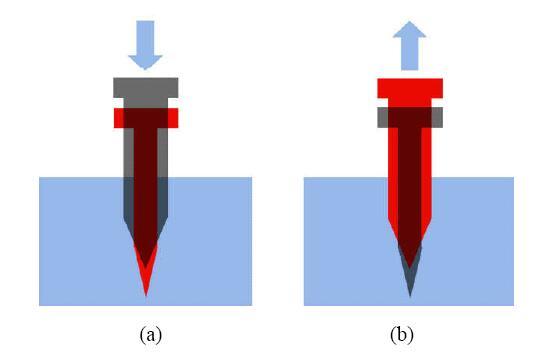 显示原图|下载原图ZIP|生成PPT
显示原图|下载原图ZIP|生成PPT图66负泊松比钉子示意图: (a)压入; (b)拉出[
-->Fig. 66Illustration of auxeticity for auxetic nails: (a) during push-in; (b) during pull-out[
-->
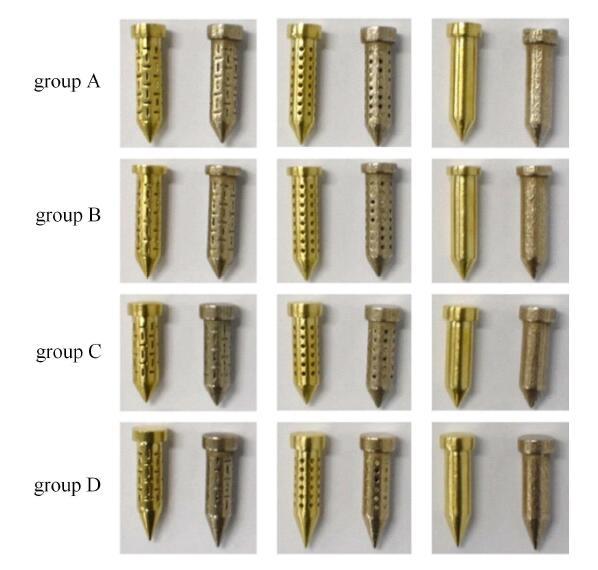 显示原图|下载原图ZIP|生成PPT
显示原图|下载原图ZIP|生成PPT图67四组黄铜、不锈钢制成的负泊松比钉子[
-->Fig. 673D printed twelve different types of nails in four nail groups using brass and stainless steel materials[
-->
6.5 航空、航海及其他国防工业
负泊松比材料和结构在航空、航海及其他国防工业有着广泛的应用.目前,负泊松比材料由于其优越的缓冲性能已大量出现在飞机机翼、发动机的叶片等部件的设计中[172, 177].负泊松比蜂窝结构具有良好的动力学性能,其夹心结构可被用作船舶的隔振器. 负泊松比材料比普通材料具有更高的剪切模量,因此可以用作为优良的阻尼材料.负泊松比蜂窝结构可以产生更大的面内变形,在垂直方向具有更强的承载力,有人提出其适用于变形飞机的机翼[178]. 吴秉鸿等[179]通过有限元方法研究发现负泊松比隔振基座的隔振性能相比传统基座有明显提升,可以实现船用主机低中频段的隔振和主机基座设计的轻量化. 杨德庆等[180]设计了一种负泊松比蜂窝舷侧防护结构,该防护结构较传统防护结构具有更好的水下抗爆性能.此外,通过设计内部结构还可将负泊松比材料应用于船体、机体隐身等方面[181].
负泊松比材料已渗透到国防领域的方方面面,目前防弹衣、保暖内衣和作战服等均引入了负泊松比材料. 采用负泊松比材料制作的子弹,大大降低了子弹通过枪管时产生的侧向膨胀,减少了子弹与枪管摩擦导致的动能损失,如图68所示[6].此外负泊松比材料还可用于制造消音器等[182-183].
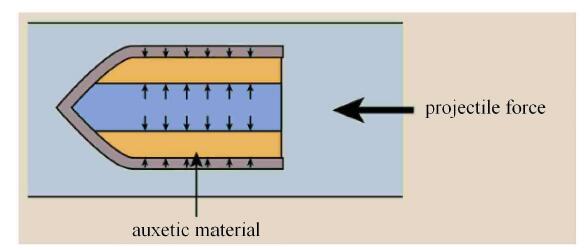 显示原图|下载原图ZIP|生成PPT
显示原图|下载原图ZIP|生成PPT图68包含负泊松比材料的子弹或壳体结构[
-->Fig. 68Bullet or shell structure containing auxetic material[
-->
6.6 其他应用
负泊松比材料的应用正逐步渗透到当今许多领域,孔凡臣等[184]设计了由曲柄滑块机构组成的负泊松比可展机构单元, 可用于制作可展开天线、可伸缩支架等,如图69所示.可折叠的折纸结构也已在空间太阳能电池帆板上得到了应用[185-186].
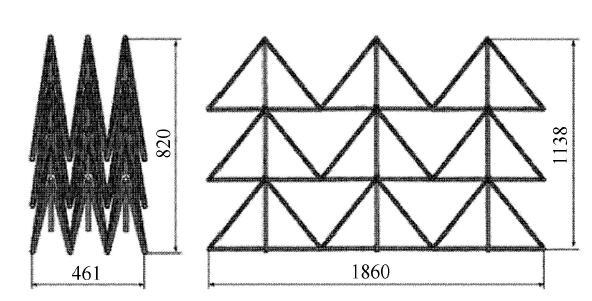 显示原图|下载原图ZIP|生成PPT
显示原图|下载原图ZIP|生成PPT图69负泊松比可展机构[
-->Fig. 69Auxetic expandable mechanism[
-->
在耳机的设计中引入负泊松比泡沫材料,不仅提高了耳部的舒适度,并且减轻了空气渗漏从而改善了音质[187].世界上 首款负泊松比非充气轮胎也成功应用于市场[188].
形状记忆是指材料在发生塑性变形后但仍能记住其原始形状的特性[189]. Bianchi等[189]研究发现形状记忆特性 对负泊松比泡沫的力学行为有显著影响. Hassan等[190]提出了一种将手性蜂窝结构和形状记忆合金结合起来形成新型智能胞状结构的新概念.受到负泊松比结构的启发,Jacobs等[153]设计、制造并测试了可展开的形状记忆合金天线. Rossiter等[69]提出并研究了不需要外部驱动机制的新型形状记忆负泊松比可展开结构.
7 结论、挑战与展望
7.1 结论
本文对国内外负泊松比材料的进展进行了总结,主要介绍了负泊松比材料的种类、内部单元结构、变形机理、力学性能和应用前景等方面的研究成果.本文尽可能多的总结了负泊松比超材料和结构领域的相关成果,由于篇幅有限,并未将所有相关研究工作包含其中,敬请谅解.过去的三十年,负泊松比材料在理论分析、有限元模拟和试验研究等方面取得了显著进展,但仍有许多问题需要进一步研究.一方面,目前大多数负泊松比材料的研究主要基于二维结构,而基于三维的负泊松比结构大多采用橡胶类材料作为基材,其承载力和抗冲击能力有限.另一方面,现有的三维负泊松比材料大多仅在小应变下表现出负泊松比特性,且大多三维负泊松比材料的几何形状是预先设计的,通常难以调整其力学性能,这极大地限制了负泊松比材料和结构的应用.此外,文中提到的某些负泊松比管状结构在压力作用下无法表现出负泊松比行为,限制了负泊松比管状结构的广泛应用.为了改进负泊松比材料的上述不足,本文特别介绍了一种新型三维负泊松比金属材料和管状结构的设计和制造方法,并通过数值模拟和试验验证了该方法的实用性和可靠性.
7.2 挑战
(1) 负泊松比材料的制造成本仍然太高.对于大多数具有可靠负泊松比行为的三维负泊松比材料,试验样品使用3D打印技术制造.尽管3D打印技术制造方便,但成本较高,这显著地限制了负泊松比材料的广泛应用,因此以更低的成本实现批量生产仍是一个关键问题.(2) 负泊松比材料和负泊松比结构的几何构型大多具有较高的孔隙率,这不可避免地降低了它们的承载力和抗冲击性能.与块体材料相比,为获得负泊松比材料的抗剪切性、抗凹陷性和能量吸收等特性,实际上人们是以牺牲材料的强度和刚度为代价的.多数情况下,所获得的负泊松比性能并不能补偿由负泊松比材料的多孔微结构导致的力学性能的损失.一般来说,与同等质量的实体材料相比,负泊松比材料的刚度和强度更低,因而显著降低了负泊松比行为的优点,尤其在能量吸收设备或保护装置的应用方面.
尽管负泊松材料具有十分突出的优良特性,但在考虑到制造成本等因素时,将其投入到实际运用中仍还有一段距离. 此外,在实际工程应用中,负泊松比材料所具有的理想特性并非是不可或缺的.这就合理解释了为什么截止到目前,负泊松比材料在实际工程中的应用依然鲜见.
7.3 展望
在过去的三十年,虽然负泊松比材料领域的研究取得了较大进展,也已经取得了一些初步应用,但大多数负泊松比材料在应用方面的研究仍处于初级阶段.因此,尝试新的负泊松比材料的应用,并将负泊松比材料所具有的优点拓展到实际运用中,仍需广大研究者们一起努力.本文结合负泊松比材料的研究现状,提出了以下工作设想:(1)负泊松比相关研究主要集中在二维材料和结构,将二维结构拓展到三维结构将是一项有意义的工作,如最近引起广泛关注的多级材料和结构. Sun等[191]理论上提出了通过纵向拉伸下使多级管状结构出现负泊松比性能的方法. Gatt等[164]基于旋转单元机制并采用数值模拟方法提出了具有负泊松比行为的二维多级系统. Tang等[192]提出了一种多级切割铰链的设计,并且采用数值模拟和试验进行了负泊松比验证. Billon等[193]提出了一种具有矩形穿孔的负泊松比多级结构.而这些研究主要局限于二维情况,设计一个可以在变形下展现出负泊松比行为的三维多级系统具有十分重要的意义.
(2)大多数负泊松比材料和结构都不能在压力和拉力作用下同时具有负泊松比特性,能在拉压条件下具有相同负泊松比性能的材料和结构更是少见. 我们在之前的工作[114, 194]中提出了设计三维负泊松比金属材料和结构的方法[116-117],当选择60%的PSF值时,三维负泊松比超材料和三维负泊松比管状结构在压缩和拉伸时可具有几乎相同的拉胀效应,如图73所示.当该负泊松比材料在压力或拉力作用下产生竖向应变时,其横向也具有与其相同的应变变化,这种特性有利于生物医学设备和三维智能传感器的应用.
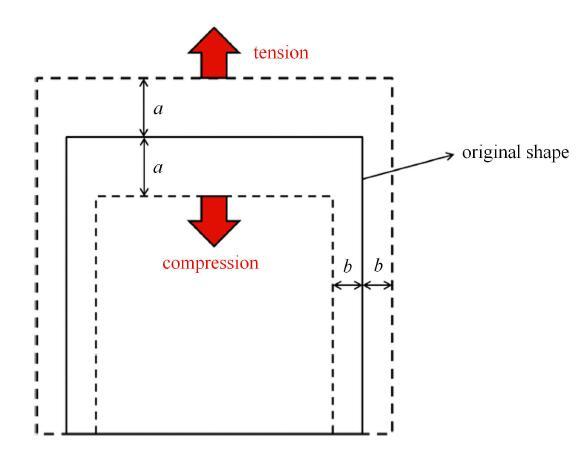 显示原图|下载原图ZIP|生成PPT
显示原图|下载原图ZIP|生成PPT图70拉压条件下具有一致负泊松比性能的材料[
-->Fig. 70Auxetic material with identical auxetic behaviour both in compression and tension[
-->
(3) 利用渐进优化法设计出力学性能更优的材料和结构. 大多数现有的负泊松比材料设计主要基于工程师的经验.虽然我们提出了一种生成三维金属负泊松比材料和结构的新方法,并且设计的负泊松比系统的力学性能可以通过PSF的单个参数轻松调整,但这种方法仍然存在一些局限性.最大的限制是这种方法必须从考虑屈曲为首要因素的几何设计开始,因此设计自由度受到很大限制.使用拓扑结构优化方法来设计具有优化性能的负泊松比材料将是负泊松比材料领域的新方向[195].近年来,采用该方法已经生成了几种负泊松比材料[196-199],但这些设计主要是基于二维设计.通过使用先进的拓扑优化算法,例如渐进结构优化法(ESO)[200-201]和双向渐进优化法(BESO)[202-203],可以设计出更多具有优越性能的三维负泊松比材料和结构.
(4) 将负泊松比(negative Poisson's ratio, NPR)与负压缩性(negative compressibility,NC)和负热膨胀性(negative thermal expansion,NTE)等参数结合可以生成一些新颖且具有特殊功能的材料,以满足具有多功能和多用途设备的要求,如图71所示.Ai 等[204]开创性地提出了一种具有NPR和NTE双重特性的星形内凹平面晶格结构. Ng等[205]通过数值模拟和分析将NTE与NPR结合形成双负参数内凹细胞超材料.进一步研究NPR, NC和NTE之间的关系十分关键[5]. 此外,Hewage等[206]最近提出了一种同时具有负刚度和NPR的力学超材料.
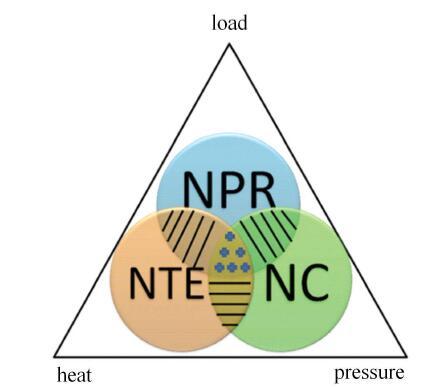 显示原图|下载原图ZIP|生成PPT
显示原图|下载原图ZIP|生成PPT图71NPR、NTE和NC的关系及拥有双重/三重负参数的材料[
-->Fig. 71Relationship among NPR, NTE, and NC, and materials with both/multi negative indexes (indicated by the shadowed regions) [
-->
(5)尽管负泊松比材料的研究众多、潜在的应用广泛,但大多还停留在理论和实验阶段,高昂的制造成本及功能的非必须性使真正运用于实际的负泊松比产品依然很少.因此,如何有效降低负泊松比材料的制造成本,并将负泊松比材料的优点与实际需求相结合进行产品设计将是一个值得研究者们共同思考的问题.
The authors have declared that no competing interests exist.
参考文献 原文顺序
文献年度倒序
文中引用次数倒序
被引期刊影响因子
| [1] | . <p>目前对于声学超材料的传输特性分析和优化大多是基于确定的数值和确定的模型,然而在实际工程和结构设计中存在大量材料自身特性和几何物理参数的不确定性.如果忽略这些不确定变量对声学超材料传输特性分析和优化过程的影响,得到的结果可能不正确.针对这一现状,拟将切比雪夫区间模型引入多层穿孔板超材料,提出多层穿孔板超材料声学透射率的区间切比雪夫展开——蒙特卡洛模拟法(interval Chebyshev expansionMonte Carlo simulation method,ICE-MCSM).该方法采用截断切比雪夫多项式近似拟合多层穿孔板超材料的声学透射率响应曲线,构造声学透射率响应曲线的切比雪夫代理模型;然后采用蒙特卡洛模拟法(Monte Carlosimulation method,MCSM)随机生成一定数量的不确定区间变量的样本数据点,并将生成的不确定区间变量样本数据点代入切比雪夫代理模型,预测单个不确定区间变量和多个不确定区间变量条件下的多层穿孔板超材料声学透射率区间的上界和下界.数值分析结果表明,ICE-MCSM预测的声学透射率变化区间的上界和下界与直接蒙特卡洛法(direct Monte Carlo simulation method,DMCSM)预测的声学透射率上界和下界的结果非常接近.与DMCSM相比,ICE-MCSM具有更高的计算效率.因此,ICE-MCSM可有效且高效地分析不确定区间变量条件下多层穿孔板超材料声学透射率传输特性,具有良好的工程应用前景.</p> . <p>目前对于声学超材料的传输特性分析和优化大多是基于确定的数值和确定的模型,然而在实际工程和结构设计中存在大量材料自身特性和几何物理参数的不确定性.如果忽略这些不确定变量对声学超材料传输特性分析和优化过程的影响,得到的结果可能不正确.针对这一现状,拟将切比雪夫区间模型引入多层穿孔板超材料,提出多层穿孔板超材料声学透射率的区间切比雪夫展开——蒙特卡洛模拟法(interval Chebyshev expansionMonte Carlo simulation method,ICE-MCSM).该方法采用截断切比雪夫多项式近似拟合多层穿孔板超材料的声学透射率响应曲线,构造声学透射率响应曲线的切比雪夫代理模型;然后采用蒙特卡洛模拟法(Monte Carlosimulation method,MCSM)随机生成一定数量的不确定区间变量的样本数据点,并将生成的不确定区间变量样本数据点代入切比雪夫代理模型,预测单个不确定区间变量和多个不确定区间变量条件下的多层穿孔板超材料声学透射率区间的上界和下界.数值分析结果表明,ICE-MCSM预测的声学透射率变化区间的上界和下界与直接蒙特卡洛法(direct Monte Carlo simulation method,DMCSM)预测的声学透射率上界和下界的结果非常接近.与DMCSM相比,ICE-MCSM具有更高的计算效率.因此,ICE-MCSM可有效且高效地分析不确定区间变量条件下多层穿孔板超材料声学透射率传输特性,具有良好的工程应用前景.</p> |
| [2] | . |
| [3] | |
| [4] | . Abstract In comparing a material's resistance to distort under mechanical load rather than to alter in volume, Poisson's ratio offers the fundamental metric by which to compare the performance of any material when strained elastically. The numerical limits are set by 陆 and -1, between which all stable isotropic materials are found. With new experiments, computational methods and routes to materials synthesis, we assess what Poisson's ratio means in the contemporary understanding of the mechanical characteristics of modern materials. Central to these recent advances, we emphasize the significance of relationships outside the elastic limit between Poisson's ratio and densification, connectivity, ductility and the toughness of solids; and their association with the dynamic properties of the liquids from which they were condensed and into which they melt. |
| [5] | . Abstract Materials with negative Poisson's ratio attract considerable attention due to their underlying intriguing physical properties and numerous promising applications, particularly in stringent environments such as aerospace and defense areas, because of their unconventional mechanical enhancements. Recent progress in materials with a negative Poisson's ratio are reviewed here, with the current state of research regarding both theory and experiment. The inter-relationship between the underlying structure and a negative Poisson's ratio is discussed in functional materials, including macroscopic bulk, low-dimensional nanoscale particles, films, sheets, or tubes. The coexistence and correlations with other negative indexes (such as negative compressibility and negative thermal expansion) are also addressed. Finally, open questions and future research opportunities are proposed for functional materials with negative Poisson's ratios. |
| [6] | . |
| [7] | . A novel foam structure is presented, which exhibits a negative Poisson's ratio. Such a material expands laterally when stretched, in contrast to ordinary materials. |
| [8] | . |
| [9] | . Micromachined polymeric honeycomb membranes having conventional and re-entrant cell geometries have been fabricated using femtosecond laser ablation. Mechanical properties characterization confirms that the re-entrant membrane is auxetic (possesses negative Poisson's ratios:65 νxy = 611.82 ± 0.05 and νyx = 610.51 ± 0.01) whereas the conventional membrane possesses positive Poisson's ratios (νxy = +0.86 ± 0.06 and νyx = +0.6 ± 0.1). Comparison with honeycomb theory confirms that the dominant deformation mechanism is flexure of the honeycomb ribs. The auxetic membrane has been challenged with single-sized glass chromatography beads such that the beads were initially resting on the re-entrant cells. Subsequent tensile loading of the membrane showed the auxetic cells opening during deformation, enabling the beads to pass through the membrane. We have modeled the pore-opening properties of both types of membranes, and the observed behavior for the auxetic membrane is consistent with the model. This is a clear pro... |
| [10] | |
| [11] | . |
| [12] | . |
| [13] | . This letter presents a piezoelectric bimorph with auxetic (negative Poisson's ratio) behaviors for increased power output in vibration energy harvesting. The piezoelectric bimorph comprises a 2D auxetic substrate sandwiched between two piezoelectric layers. The auxetic substrate is capable of introducing auxetic behaviors and thus increasing the transverse stress in the piezoelectric layers when the bimorph is subjected to a longitudinal stretching load. As a result, both 31- and 32-modes are simultaneously exploited to generate electric power, leading to an increased power output. The increasing power output principle was theoretically analyzed and verified by finite element (FE) modelling. The FE modelling results showed that the auxetic substrate can increase the transverse stress of a bimorph by 16.7 times. The average power generated by the auxetic bimorph is 2.76 times of that generated by a conventional bimorph. |
| [14] | . A three-dimensional fully auxetic cellular structure with negative Poisson’s ratio is presented. Samples are fabricated from Ti6Al4V powder via selective electron beam melting. The influence of the strut thickness and the amplitude of the strut on the mechanical properties and the deformation behaviour of cellular structures is studied. |
| [15] | |
| [16] | . Analytical investigations on the contact problems between two homogeneous and isotropic soft bodies were performed to simulate the contact of human buttocks and seat cushions. The cushion materials' Poisson's ratio were allowed to be negative. The human buttocks were modeled as an ideal sphere with radius 15 cm, and assumed to have a low Young's modulus and a Poisson's ratio close to 0.5. These parameters were held constant during our analysis. Peak contact pressure was reduced by adjusting the contour curvature of cushions according to Hertz theory, as expected. Moreover, analysis by both the Hertz model and a finite thickness 3D elasticity model showed that using negative Poisson's ratio cushions could further reduce the pressure. Negative Poisson's ratio cushions may be beneficial in the prevention of pressure sores or ulcers in the sick and in reduction of pressure-induced discomfort in seated people. |
| [17] | . The work describes the mechanical performance of a metal rubber particles (MRP) damper design based on an auxetic (negative Poisson鈥檚 ratio) cellular configuration. The auxetic damper configuration is constituted by an anti-tetrachiral honeycomb, where the cylinders are filled with the MRP material. The MRP samples have been subjected to quasi-static loading to measure the stiffness and loss factor from the static hysteresis curve. A parametric experimental analysis has been carried out to investigate the effect of relative density and filling percentage on the static performance of the MRP, and to identify design guidelines for best use of MRP devices. An experimental assessment of the integrated auxetic-MRP damper concept has been provided through static and dynamic force response techniques. (paper) |
| [18] | . Negative Poisson's ratio behavior has been uncovered in cellular solids that comprise a solid matrix with a square array of circular voids. The simplicity of the fabrication implies robust behavior, which is relevant over a range of scales. The behavior results from an elastic instability, which induces a pattern transformation and excellent quantitative agreement is found between calculation and experiment. |
| [19] | . |
| [20] | . Love, A E H |
| [21] | . Poisson's ratio is, for specified directions, the ratio of a lateral contraction to the longitudinal extension during the stretching of a material. Although a negative Poisson's ratio (that is, a lateral extension in response to stretching) is not forbidden by thermodynamics, this property is generally believed to be rare in crystalline solids. In contrast to this belief, 69% of the cubic elemental metals have a negative Poisson's ratio when stretched along the [110] direction. For these metals, we find that correlations exist between the work function and the extremal values of Poisson's ratio for this stretch direction, which we explain using a simple electron-gas model. Moreover, these negative Poisson's ratios permit the existence, in the orthogonal lateral direction, of positive Poisson's ratios up to the stability limit of 2 for cubic crystals. Such metals having negative Poisson's ratios may find application as electrodes that amplify the response of piezoelectric sensors. |
| [22] | . THE Poisson ratio of a solid characterizes its response to uniaxial stress. It is defined as the negative ratio of the transverse strain to the corresponding axial strain. Normally, this ratio is positive, as most solids expand in the transverse direction when subjected to a uniaxial compression. Although a negative Poisson ratio is not forbidden by thermodynamics, it is rare in crystalline solids: the results of recent experiments 1 which observed a negative Poisson ratio in α-cristobalite were therefore unexpected. We have investigated the elastic behaviour of α-cristobalite and other forms of silica with first-principles calculations and classical interatomic potentials. Our calculations reproduce the negative Poisson ratio in α-cristobalite and predict that α-quartz, the most common form of crystalline silica, will also exhibit a negative Poisson ratio under large uniaxial tension. We attribute the occurrence of a negative Poisson ratio in low-density silica polymorphs to the high rigidity of the SiO 4 tetrahedra. |
| [23] | . As a basic mechanical parameter, Poisson's ratio ({\nu}) measures the mechanical responses of solids against external loads. In rare cases, materials have a negative Poisson's ratio (NPR), and present an interesting auxetic effect. That is, when a material is stretched in one direction, it will expand in the perpendicular direction. To design modern nanoscale electromechanical devices with special functions, two dimensional (2D) auxetic materials are highly desirable. In this work, based on first principles calculations, we rediscover the previously proposed {\delta}-phosphorene ({\delta}-P) nanosheets [Jie Guan et al., Phys. Rev. Lett. 2014, 113, 046804] are good auxetic materials with a high NPR. The results show that the Young's modulus and Poisson's ratio of {\delta}-P are all anisotropic. The NPR value along the grooved direction is up to -0.267, which is much higher than the recently reported 2D auxetic materials. The auxetic effect of {\delta}-P originated from its puckered structure is robust and insensitive to the number of layers due to weak interlayer interactions. Moreover, {\delta}-P possesses good flexibility because of its relatively small Young's modulus and high critical crack strain. If {\delta}-P can be synthesized, these extraordinary properties would endow it great potential in designing low dimensional electromechanical devices. |
| [24] | . |
| [25] | . Recently synthesized atomically thin boron sheets (that is, borophene) provide a fascinating template for new material property discovery. Here, we report findings of an extraordinary combination of unusual mechanical and electronic properties in hydrogenated borophene, known as borophane, from first-principles calculations. This novel 2D material has been shown to exhibit robust Dirac transport physics. Our study unveils that borophane is auxetic with a surprising negative Poisson鈥檚 ratio stemming from its unique puckered triangle hinge structure and the associated hinge dihedral angle variation under a tensile strain in the armchair direction. Our results also identify borophane to be ferroelastic with a stress-driven 90掳 lattice rotation in the boron layer, accompanied by a remarkable orientation switch of the anisotropic Dirac transport channels. These outstanding strain-engineered properties make borophane a highly versatile and promising 2D material for innovative applications in microelectromechanical and nanoelectronic devices. |
| [26] | . In this work, we perform molecular dynamics (MD) simulations to study the effect of rippling on the Poisson's ratio of graphene. Due to the atomic scale thickness of graphene, out-of-plane ripples are generated in free standing graphene with topological defects (e.g. heptagons and pentagons) to release the in-plane deformation energy. Through MD simulations, we have found that the Poisson's ratio of rippled graphene decreases upon increasing its aspect ratio η (amplitude over wavelength). For the rippled graphene sheet η = 0.188, a negative Poisson's ratio of 610.38 is observed for a tensile strain up to 8%, while the Poisson's ratio for η = 0.066 is almost zero. During uniaxial tension, the ripples gradually become flat, thus the Poisson's ratio of rippled graphene is determined by the competing factors of the intrinsic positive Poisson's ratio of graphene and the negative Poisson's ratio due to the de-wrinkling effect. Besides, the rippled graphene exhibits excellent fracture strength and toughness. With the combination of its auxetic and excellent mechanical properties, rippled graphene may possess potential for application in nano-devices and nanomaterials. |
| [27] | . Transition metal carbides include a wide variety of materials with attractive properties that are suitable for numerous and diverse applications. A most recent experimental advance could provide a path toward the successful synthesis of large-area and high-quality ultrathin MoC membranes with superconducting properties. In the present study, we used first-principles density functional theory calculations to explore the mechanical and optical response of single-layer and free-standing MoC. Uniaxial tensile simulations along the armchair and zigzag directions were conducted and we found that while the elastic properties are close along various loading directions, the nonlinear regimes in stress-strain curves are considerably different. We found that MoC sheets present negative Poisson's ratio and thus can be categorized as an auxetic material. Our simulations also reveal that MoC films retain their metallic electronic characteristic upon uniaxial loading. We found that for MoC nanomembranes the dielectric function becomes anisotropic along in-plane and out-of-plane directions. Our findings can be useful for the practical application of MoC sheets in nanodevices. |
| [28] | . Materials with a negative Poisson's ratio, also known as auxetic materials, exhibit unusual and counterintuitive mechanical behaviour—becoming fatter in cross-section when stretched. Such behaviour is mostly attributed to some special re-entrant or hinged geometric structures regardless of the chemical composition and electronic structure of a material. Here, using first-principles calculations, we report a class of auxetic single-layer two-dimensional materials, namely, the 1T-type monolayer crystals of groups 6–7 transition-metal dichalcogenides, MX2(M=Mo, W, Tc, Re; X=S, Se, Te). These materials have a crystal structure distinct from all other known auxetic materials. They exhibit an intrinsic in-plane negative Poisson's ratio, which is dominated by electronic effects. We attribute the occurrence of such auxetic behaviour to the strong coupling between the chalcogenporbitals and the intermetalt2g-bonding orbitals within the basic triangular pyramid structure unit. The unusual auxetic behaviour in combination with other remarkable properties of monolayer two-dimensional materials could lead to novel multi-functionalities. Auxetic materials—those that expand laterally when stretched—can possess enhanced mechanical properties, including shear modulus, indentation resistance, and fracture toughness. Here the authors show that 1T-type crystalline 2D transition metal dichalcogenides exhibit intrinsic in-plane negative Poisson's ratios. |
| [29] | . Poisson's ratio is a fundamental property of a material which reflects the transverse strain response to the applied axial strain. Negative Poisson's ratio is allowed theoretically, but is rare in nature. Besides the discovery and tailoring of bulk auxetic materials, recent studies have also found a negative Poisson's ratio in nanomaterials, while their negative Poisson's ratio is mainly based on conventional rigid mechanical models as bulk auxetic materials. In this work, we report the existence of in-plane negative Poisson's ratio in a two-dimensional convex structure of newly synthesized semi-fluorinated graphene by using first-principles calculations. In addition, the sign of the Poisson's ratio can be tuned by the applied strain. Interestingly, we find that this unconventional negative Poisson's ratio cannot be explained by conventional rigid mechanical models but originates from the enhanced bond angle strain over the bond strain due to chemical functionalization. This new mechanism of auxetics extends the scope of auxetic nanomaterials and can serve as design principles for future discovery and design of new auxetic materials. |
| [30] | . An investigation has been made of the source and magnitude of anisotropic material properties of cancellous bone in the proximal epiphysis of the human tibia. Results are reported for stiffness measurements made in three orthogonal directions on 21 cubes of cancellous bone before testing to failure along one of the three principal axes. The structure is approximately transversely isotropic. Strength and stiffness are linear with area fraction for loading along the isotropic axis. Strength is proportional to stiffness for all directions. A finite element model is proposed, based on experimental observations, which enables one to predict the elastic constants of cylindrically structured cancellous bone in the tibia from morphological measurements in the transverse plane. |
| [31] | . The mechanical characterization of skin tissue is examined employing the principles of finite elasticity. A strain energy or work function is employed to develop time independent stress-strain relations valid for large deformations. Results from unaxial tests on cat skin are presented. Comparing the experimentally determined force-extension curves with the analytical stress-strain relations permits the determination of suitable strain energy functions. |
| [32] | |
| [33] | . auxetic materials: avoiding the shrinkWhen compressed in a vice, the sides of a material are expected to bulge. Conversely, stretching is |
| [34] | . |
| [35] | . |
| [36] | . Embryonic stem cells (ESCs) self-renew in a state of na茂ve pluripotency in which they are competent to generate all somatic cells. It has been hypothesized that, before irreversibly committing, ESCs pass through at least one metastable transition state. This transition would represent a gateway for differentiation and reprogramming of somatic cells. Here, we show that during the transition, the nuclei of ESCs are auxetic: they exhibit a cross-sectional expansion when stretched and a cross-sectional contraction when compressed, and their stiffness increases under compression. We also show that the auxetic phenotype of transition ESC nuclei is driven at least in part by global chromatin decondensation. Through the regulation of molecular turnover in the differentiating nucleus by external forces, auxeticity could be a key element in mechanotransduction. Our findings highlight the importance of nuclear structure in the regulation of differentiation and reprogramming. |
| [37] | . Biophysical properties of the scaffolds such as the elastic modulus, have been recently shown to impact stem cell lineage commitment. On the other hand, the contribution of the Poisson’s ratio, another important biophysical property, to the stem cell fate decision, has not been studied. Scaffolds with tunable Poisson’s ratio (ν) (termed as auxetic scaffolds when Poisson’s ratio is zero or negative) are anticipated to provide a spectrum of unique biophysical 3-D microenvironments to influence stem cell fate. To test this hypothesis, in the present work we fabricated auxetic polyurethane scaffolds (ν = 0 to -0.45) and evaluated their effects on neural differentiation of mouse embryonic stem cells (ESCs) and human induced pluripotent stem cells (hiPSCs). Compared to the regular scaffolds (ν = +0.30) before auxetic conversion, the auxetic scaffolds supported smaller aggregate formation and higher expression of β-tubulin III upon neural differentiation. The influences of pore structure, Poisson’s ratio, and elastic modulus on neural lineage commitment was further evaluated using a series of auxetic scaffolds. The results indicate that Poisson’s ratio may confound the effects of elastic modulus, and auxetic scaffolds with proper pore structure and Poisson’s ratio enhance neural differentiation. This study demonstrates that tuning the Poisson’s ratio of the scaffolds together with elastic modulus and microstructure would enhance the capability to generate broader, more diversified ranges of biophysical 3-D microenvironments for the modulation of cellular differentiation. Biophysical signaling from the substrates and scaffolds plays a critical role in neural lineage commitment of pluripotent stem cells. While the contribution of elastic modulus has been well studied, the influence of Poisson’s ratio along with microstructure of the scaffolds remains unknown largely due to the lack of technology to produce materials with tailorable Poisson’s ratio. This study fabricated auxetic polyurethane scaffolds with different elastic modulus, Poisson’s ratio and microstructure and evaluated neural differentiation of pluripotent stem cells. The findings add a novel angle to understand the impact of biophysical microenvironment on stem cell fate decisions. |
| [38] | |
| [39] | . Abstract Ultralight (<10 milligrams per cubic centimeter) cellular materials are desirable for thermal insulation; battery electrodes; catalyst supports; and acoustic, vibration, or shock energy damping. We present ultralight materials based on periodic hollow-tube microlattices. These materials are fabricated by starting with a template formed by self-propagating photopolymer waveguide prototyping, coating the template by electroless nickel plating, and subsequently etching away the template. The resulting metallic microlattices exhibit densities 0301 090906 0.9 milligram per cubic centimeter, complete recovery after compression exceeding 50% strain, and energy absorption similar to elastomers. Young's modulus E scales with density as E ~ 0301(2), in contrast to the E ~ 0301(3) scaling observed for ultralight aerogels and carbon nanotube foams with stochastic architecture. We attribute these properties to structural hierarchy at the nanometer, micrometer, and millimeter scales. |
| [40] | . |
| [41] | . The mechanical properties (the moduli and collapse strengths) of three-dimensional cellular solids or foams are related to the properties of the cell wall, and to the cell geometry. The results of the analyses give a good description of a large body of data for polymeric foams. |
| [42] | . ABSTRACT A theoretical model has been developed for predicting the elastic constants of honeycombs based on the deformation of the honeycomb cells by flexure, stretching and hinging. This is an extension of earlier work based on flexure alone. The model has been used to derive expressions for the tensile moduli, shear moduli and Poisson's ratios. Examples are given of structures with a negative Poisson's ratio. It is shown how the properties can be tailored by varying the relative magnitudes of the force constants for the different deformation mechanisms. Off-axis elastic constants are also calculated and it is shown how the moduli and Poisson's ratios vary with applied loading direction. Depending on the geometry of the honeycomb the properties may be isotropie (for regular hexagons) or extremely anisotropic. Again, the degree of anisotropy is also affected by the relative magnitude of the force constants for the three deformation mechanisms. |
| [43] | |
| [44] | . This paper describes a new way to design and fabricate compliant micromechanisms and material structures with negative Poisson's ratio (NPR). The design of compliant mechanisms and material structures is accomplished in an automated way using a numerical topology optimization method, The procedure allows the user to specify the elastic properties of materials or the mechanical advantages (MA's) or geometrical advantages (GA's) of compliant mechanisms and returns the optimal structures. The topologies obtained by the numerical procedure require practically no interaction by the engineer before they can be transferred to the fabrication unit. Fabrication is carried out by patterning a sputtered silicon on a plasma-enhanced chemical vapor deposition (PECVD) glass with a laser micromachining setup. Subsequently, the structures are etched into the underlying PECVD glass, and the glass is underetched, all in one two-step reactive ion etching (RIE) process. The components are tested using a probe placed on an x-y stage. This fast prototyping allows newly developed topologies to be fabricated and tested within the same day |
| [45] | . Auxetic materials and structures exhibit the unexpected behaviour of getting wider when stretched and thinner when compressed. This behaviour requires the structures (the internal structure in the case of materials) to have geometric features, which must deform in a way that results in the structure expanding when stretched. This paper assesses the potential for auxetic behaviour of a novel class of two-dimensional periodic structures which can be described as “connected stars” as they contain star-shaped units of different rotational symmetry which are connected together to form two-dimensional periodic structures. These structures will be studied through a technique based on force-field based methods (the EMUDA technique) and it will be shown that some, but not all, of these structures can exhibit auxetic behaviour. An attempt is made to explain the reasons for the presence or absence of a negative Poisson's ratio in these systems. |
| [46] | . |
| [47] | . |
| [48] | . A finite element model for three-dimensional, open-called foams is developed. A reentrant cell shape is defined that has the unusual property of exhibiting a negative Poisson's ratio. By altering the cell shape it is possible to achieve different values for the elastic constants and different degrees of anisotropy. It is shown that simple two-dimensional approximations fail to model the properties of the three-dimensional network accurately and a full three-dimensional analysis is required. The reentrant cell used is fully auxetic, with negative Poisson's ratios exhibited when loaded in all three orthogonal directions. |
| [49] | . In this work, an analytical model of a 3D re-entrant auxetic cellular structure has been established based on energy method. In the model the overlapping of the struts as well as axial extension or compression (mostly neglected in former studies) were taken into consideration to make the model applicable when the struts are relative stubby which is common in engineering designs. Analytical solutions for the modulus and Poisson's ratios of the cellular structure in all principal directions were deduced. To validate the analytical model in present study, numerical calculations using brick elements were performed on unit cell models with periodic boundary conditions, and comparisons of the present model with analytical formulae and experimental results available in former literatures were also conducted. The results show that when the struts are slender enough, the bending of the struts play decisive role on the deformation of the structure and other mechanisms can be ignored; while when the struts become relative stubby, all the mechanisms including bending, shearing and axial loading need to be considered; The often-ignored axial extension or compression term may even play decisive role on determining the lateral Poisson's ratio of the structure when the struts are relative stubby. |
| [50] | . In this work, an analytical model of a 3D re-entrant honeycomb auxetic cellular structure has been established based on both a large deflection beam model and a Timoshenko beam model. Analytical solutions for the modulus, Poisson鈥檚 ratios and yield strength of the cellular structure in all principal directions were obtained, which indicate a wide range of mechanical property control via geometrical designs. The results were compared with experimentation and finite element analysis, and it was verified that the analytical model provides a convenient and relatively accurate method in the prediction of the performance for the auxetic cellular structures once the manufacturing related factors are adequately incorporated into the model. It was also found that the model provides less accurate predictions when higher-order coupling effects such as warp locking becomes significant under lower structural symmetry. |
| [51] | . In the present work, a new design of honeycomb is proposed by embedding the rhombic configuration into the normal re-entrant hexagonal honeycomb (NRHH), in order to enhance the honeycomb’s in-plane mechanical properties. Both theoretical analysis and numerical simulations are employed to calculate the in-plane mechanical properties of the new honeycomb under uniaxial compression, including Young’s modulus, Poisson’s ratio and critical buckling strength. The results show that the new honeycomb can maintain auxetic performance, while both the in-plane Young’s modulus and the critical buckling strength are significantly improved compared to the NRHH. Comparisons between the present design and other exiting enhanced periodic topologies are also carried out. With respect to them, the present design features superior performances. For these outstanding properties, this layout may provide a new concept for the optimization and design of auxetic materials. |
| [52] | . In view of their potential applications in sandwich structures, there has been increasing interest in honeycomb networks. Several different types of honeycomb systems have been proposed each exhibiting different mechanical properties. Here we propose a new hexagonal honeycomb structure composed of two different geometrical features: a re-entrant feature which is known to generate auxetic behavior, and a non re-entrant feature found in regular hexagonal honeycombs which leads to conventional behavior. This results in a 090008semi re-entrant honeycomb090009 built of alternate conventional and auxetic layers. Finite element analysis and analytical modeling of these honeycombs show that they exhibit a zero Poisson ratio in one direction and a higher than normal Young's modulus in the orthogonal direction. We also show that by virtue of its zero Poisson's ratio, this honeycomb has a natural tendency to form cylindrical shaped curvatures, something which is very difficult to achieve with conventional or auxetic honeycombs. |
| [53] | . |
| [54] | . |
| [55] | . Auxetics exhibit the unusual property of expanding when uniaxially stretched (negative Poisson's ratio), a property that is usually linked to particular geometric features and deformation mechanisms. One of the mechanisms which results in auxetic behaviour is the one involving rotating rigid units, for which, systems made from triangles, squares or rectangles have already been considered. In this work we extend this study by considering systems which can be constructed from either connected rhombi or connected parallelograms. We show that various types of such systems can exist and we discuss in detail the properties of one type of rotating rhombi' and one type of rotating parallelograms'. We also show that the Poisson's ratio of these systems, which can be positive or negative, is anisotropic and dependent on the shape of the parallelograms/rhombi and the degree of openness of the system. (脗漏 2008 WILEY-VCH Verlag GmbH & Co. KGaA, Weinheim) |
| [56] | . No Abstract available for this article. |
| [57] | . The article discusses whether a material with a rotating triangles geometry exhibits conventional or auxetic behavior. It has been observed that the auxetic behavior is retained, which is very significant because it shows that the rotating triangles mechanism can be a very effective way for introducing negative Poisson's ratios in real materials. This will lead to the discovery of new materials with negative Poisson's ratios. |
| [58] | . |
| [59] | . fact, assuming that the stiffness of the structure results solely from resistance to relative rotation of the squares (i.e. the squares are connected together through hinges which have a hinge constant Kh), the `mechanical properties' of this idealised two dimensional system are completely described in terms of a (3 x 3) compliance matrix S which relates the applied stress σ to the resulting strain ε through ε = Sσ, i.e.: |
| [60] | . Analytical expressions are derived for the Poisson's ratios associated with a three-dimensional network of regular, corner-sharing tetrahedra in which: (1) the tetrahedra are assumed to be rigid and free to rotate relative to each other; (2) the tetrahedra are assumed to maintain shape and orientation but are free to change size (dilate); (3) tetrahedral rotation and dilation are assumed to act concurrently. The structure has a primitive unit cell containing four tetrahedra and is analogous to the molecular structure of 伪-cristobalite. Strain-dependent variations in Poisson's ratio are also predicted by the models. For deformation due to tetrahedral rotation the network is found to exhibit negative Poisson's ratios in each of the three principal directions, with the magnitude of the Poisson's ratio being dependent on the angle of rotation of the tetrahedra. The behaviour of the Poisson's ratio is isotropic in the transverse plane, but anisotropic elsewhere. In the dilation model negative Poisson's ratios equal to 鈭1 are observed for uniaxial loading in any of the principal directions, with the value being constant irrespective of tetrahedral size. The model for concurrent tetrahedral rotation and dilation allows positive as well as negative Poisson's ratios, with the values determined by the framework geometry and relative strengths of the two mechanisms. The concurrent model also offers a design route to materials and structures having ultrahigh Young's moduli. |
| [61] | . [Display omitted] |
| [62] | . Poisson's ratio in materials is governed by the following aspects of the microstructure: the presence of rotational degrees of freedom, non-affine deformation kinematics, or anisotropic structure. Several structural models are examined. The non-affine kinematics are seen to be essential for the production of negative Poisson's ratios for isotropic materials containing central force linkages of positive stiffness. Non-central forces combined with pre-load can also give rise to a negative Poisson's ratio in isotropic materials. A chiral microstructure with noncentral force interaction or non-affine deformation can also exhibit a negative Poisson's ratio. Toughness and damage resistance in these materials may be affected by the Poisson's ratio itself, as well as by generalized continuum aspects associated with the microstructure. |
| [63] | . Auxetics are systems which get fatter when stretched and thinner when compressed i.e. they exhibit a negative Poisson's ratio. Here, we present an analysis of a novel class of structures (referred to as meta-chiral') which belong to the class of auxetics constructed using chiral building blocks. We show through analytical modelling that some of these systems can exhibit negative Poisson's ratios, the extent of which will depend, amongst other things, on the geometry of the system. (0008 2008 WILEY-VCH Verlag GmbH & Co. KGaA, Weinheim) |
| [64] | . A theoretical and experimental investigation is conducted of a two-dimensionally chiral honeycomb. The honeycomb exhibits a Poisson's ratio of -1 for deformation in-plane. This Poisson's ratio is maintained over a significant range of strain, in contrast to the variation with strain seen in known negative Poisson's ratio materials. |
| [65] | . Chiral honeycombs are one of the most important and oft studied classes of auxetic systems due to their vast number of potential applications which range from stent geometries to composites, sensors and satellite components. Despite numerous works on these systems, however, relatively few studies have investigated the effect of structural disorder on these structures. In view of this, in this study, the effect of translational disorder on hexachiral honeycombs were investigated through a Finite Element approach. It was found that this type of disorder has minimal effect on the Poisson's ratios of these systems provided that the ligament length to thickness ratio remains sufficiently large and the overall length to width ratio of the disordered system does not differ considerably from that of its ordered counterpart. This makes it ideal for use in various applications and products such as sandwich composites with an auxetic core. |
| [66] | . |
| [67] | . Based on a 2D cross chiral structure, two novel 3D cross chiral structures (Structure-1 and structure-2) with negative Poisson's ratios were proposed in this paper. Structure-1 could be evolved into structure-2 by adding a star structure. Analytical models of the two auxetic cellular structures were established based on the Timoshenko beam theory. The Young's modulus and Poisson's ratio of the cellular structures were obtained in all principal directions, which were verified by finite element method (FEM). Structure-1 exhibits anisotropic auxetic behavior while structure-2 shows uniform auxetic behavior in all three principal directions with all on-axis Poisson's ratios closer to the limit of -1. Additionally, the extra addition of star structure can enhance the Young's modulus of structure-2 significantly in the case of same relative density, compared to structure-1. Moreover, the effect of parameter variation on elastic properties of two structures and the comparison with other classical 3D auxetic structures were also thoroughly studied and discussed in details. These results are expected to eventually contribute to the advance of research and the application of new 3D auxetic structures in the future. |
| [68] | . A new design thought for 3D auxetic material is proposed based on the rotaion mechanism of chiral honeycombs. Two kinds of cell shape of the 3D auxetic material are studied as example, which are developed from the tetrachiral honeycombs with circular loops and square loops, respectively, with inclined rods connecting the neighbor layers. By replacing the tetrachiral honeycomb layers by other chiral honeycombs, such as trichiral, hexachiral honeycombs, other kinds of 3D chiral material with negative Poisson's ratio can be obtained. Moreover, since the cells' deformation of the 3D material is dominated by that of ligaments and rods under small deformation, the elastic properties of the 3D auxetic material are almost independent of the loops' shape. Thus, the loop can be designed to any shape instead of the traditional circular loop in order to obtain priory mechanical properties under large deformation. Based on beam theory and micromechanical method, the analytical formulas of both the elastic mudulus and Poisson's ratio are deduced for this category of 3D chiral material, which are verified by numerical simulations but also the experiment of 3D printed model. The verification results indicate that the formulas have higher precision and wider application scope. The influence of layer space on the equivalent parameters and the conditions for isotropic realization are discussed base on the analytical formulas. By changing the oblique direction of the inclined rods, another new 3D material can be obtained with positive Poisson's ratio in two directions and negative Poisson's ratio in the other one direction, for which the analytical formulas are still applicable. |
| [69] | . Planar auxetic structures have the potential to impact on a wide range of applications from deployable and morphing structures to space-filling composite and medical treatments. The ability to fabricate auxetics from smart materials greatly enhances this facility by building in controllable actuation and deployment. A smart auxetic device can be compressed and fixed into a storage state. When deployment is required the device can be appropriately stimulated and the stored elastic energy is released, resulting in a marked structural expansion. Instead of using a conventional external actuator to drive deployment the material is made to undergo phase transition where one stimulus (e.g.聽heat) initiates a mechanical response. Here we show how smart material auxetics can be realized using a thermally responsive shape memory polymer composites. We show how a shape memory polymer auxetic hexachiral structure can be tailored to provide a tunable stiffness response in its fully deployed state by varying the angle of inter-hub connections, and yet is still able to undergo thermally stimulated deployment. (paper) |
| [70] | . Abstract Graphene can be made auxetic through the introduction of vacancy defects. This results in the thinnest negative Poisson's ratio material at ambient conditions known so far, an effect achieved via a nanoscale de-wrinkling mechanism that mimics the behavior at the macroscale exhibited by a crumpled sheet of paper when stretched. |
| [71] | . In this study, we report a novel periodic material with negative Poisson鈥檚 ratio (also called auxetic materials) fabricated by denting spherical dimples in an elastic flat sheet. While previously reported auxetic materials are either porous or comprise at least two phases, the material proposed here is non-porous and made of a homogeneous elastic sheet. Importantly, the auxetic behavior is induced by a novel mechanism which exploits the out-of-plane deformation of the spherical dimples. Through a combination of experiments and numerical analyses, we demonstrate the robustness of the proposed concept, paving the way for developing a new class of auxetic materials that significantly expand their design space and possible applications. |
| [72] | . 折纸是指不经剪裁和粘接,将二维平面纸张折叠成三维立体的方法,具有设计简单、成形迅速、适用范围广等优点,在可展开式结构、结构组装与自成型等领域有着广阔的应用前景.本文首先简述了多种典型的新式折纸应用,如屈曲诱导的微尺度三维结构、可折叠太阳能电池板、DNA螺旋组装结构等;根据折纸的曲线折痕数量、相对运动、刚性折叠面、使用纸张数量界定折纸的分类;然后折痕设计是实现折纸结构的核心问题,着重阐述了折纸的折痕设计方面,包括梳理折痕设计的基本条件,给出若干典型折痕设计如三浦折痕设计、水弹折痕设计、吉村式折痕设计和对角线型折痕设计,介绍典型折痕设计的显著特点及几何条件,将目前折纸折痕设计的创新方法归纳为对经典折痕设计适当改进、形成折痕设计数据库、利用拓扑优化方法、借助成型的汇编算法等;最后,基于当前折纸的研究进展对未来的研究方向进行了展望,其中涉及到可重构折纸结构、四维折纸、多材料折纸和多尺度折纸等. . 折纸是指不经剪裁和粘接,将二维平面纸张折叠成三维立体的方法,具有设计简单、成形迅速、适用范围广等优点,在可展开式结构、结构组装与自成型等领域有着广阔的应用前景.本文首先简述了多种典型的新式折纸应用,如屈曲诱导的微尺度三维结构、可折叠太阳能电池板、DNA螺旋组装结构等;根据折纸的曲线折痕数量、相对运动、刚性折叠面、使用纸张数量界定折纸的分类;然后折痕设计是实现折纸结构的核心问题,着重阐述了折纸的折痕设计方面,包括梳理折痕设计的基本条件,给出若干典型折痕设计如三浦折痕设计、水弹折痕设计、吉村式折痕设计和对角线型折痕设计,介绍典型折痕设计的显著特点及几何条件,将目前折纸折痕设计的创新方法归纳为对经典折痕设计适当改进、形成折痕设计数据库、利用拓扑优化方法、借助成型的汇编算法等;最后,基于当前折纸的研究进展对未来的研究方向进行了展望,其中涉及到可重构折纸结构、四维折纸、多材料折纸和多尺度折纸等. |
| [73] | . 61The deformation behavior of the Miura-ori patterned sheet is investigated.61The patterned sheet is made of copolymer Elvaloy, capable of elastic deformations.61In-plane properties, not reported before, are investigated.61The energy absorption capacities of the patterned sheet have been investigated. |
| [74] | . The work describes the manufacturing and testing of graded conventional/auxetic honeycomb cores. The graded honeycombs are manufactured using Kevlar woven fabric/914 epoxy prepreg using Kirigami techniques, which consist in a combination of Origami and ply-cut processes. The cores are used to manufacture sandwich panels for flatwise compression and edgewise loading. The compressive modulus and compressive strength of stabilized (sandwich) honeycombs are found to be higher than those of bare honeycombs, and with density-averaged properties enhanced compared to other sandwich panels offered in the market place. The modulus and strength of graded sandwich panel under quasi-static edgewise loading vary with different failure mode mechanisms, and offer also improvements towards available panels from open literature. Edgewise impact loading shows a strong directionality of the mechanical response. When the indenter impacts the auxetic portion of the graded core, the strong localization of the damage due to the negative Poisson鈥檚 ratio effect contains significantly the maximum dynamic displacement of the sandwich panel. |
| [75] | . Mechanical metamaterials exhibit unusual properties through the shape and movement of their engineered subunits. This work presents a new investigation of the Poisson鈥檚 ratios of a family of cellular metamaterials based on Kirigami design principles. Kirigami is the art of cutting and folding paper to obtain 3D shapes. This technique allows us to create cellular structures with engineered cuts and folds that produce large shape and volume changes, and with extremely directional, tuneable mechanical properties. We demonstrate how to produce these structures from flat sheets of composite materials. By a combination of analytical models and numerical simulations we show how these Kirigami cellular metamaterials can change their deformation characteristics. We also demonstrate the potential of using these classes of mechanical metamaterials for shape change applications like morphing structures. |
| [76] | . |
| [77] | . Materials and structures with negative Poisson's ratio are characterized as auxetics. They are interesting for engineering applications due to their non-conventional behavior. However, most of the auxetic structures suffer with a disadvantage that they are difficult to be fabricated because of their complicated geometry structure. To overcome this problem, an auxetic structure made of tubes and corrugated sheets using conventional technology is proposed in this study. Its auxetic effect is investigated by both geometrical analysis and finite element method. For validating the analyses, a real auxetic structure is made with aluminum material and tested under compression condition. All the results obtained show that the proposed structure has very significant negative Poisson's ratio effect under compression. The study has provided a simple way to fabricate auxetic structure for using in a wide range of industrial fields at a low cost. |
| [78] | . Sheets made from readily available conventional materials containing diamond or star shaped perforations are shown to exhibit various Poisson's ratio values which could also be negative (auxetic). This behavior may be exhibited in both tension and compression and can be explained through models based on rotating rigid units. This provides an easy manner for the manufacture of auxetic or conventional systems at any scale which can be tailor made to exhibit particular values of the Poisson's ratio. |
| [79] | . 超材料自21世纪初诞生以来,历经近20年的发展已逐渐发展成为新材料技术的一个重要学科.近年来,功能迥异的超材料在各个领域层出不穷,综述了声、光、热、力、电磁学超材料的发展历史概况.针对机械超材料中的负泊松比超材料,从负泊松比结构的变形机理角度,着重详述了内凹多边形结构、旋转刚体结构、手性结构等物理模型.对基于负泊松比胞元结构的热学和声学超材料,从功能原理到基本特性进行了系统性的调研,综述分析了其研究现状,并对负泊松比超材料未来面临的挑战与发展趋势进行了展望. . 超材料自21世纪初诞生以来,历经近20年的发展已逐渐发展成为新材料技术的一个重要学科.近年来,功能迥异的超材料在各个领域层出不穷,综述了声、光、热、力、电磁学超材料的发展历史概况.针对机械超材料中的负泊松比超材料,从负泊松比结构的变形机理角度,着重详述了内凹多边形结构、旋转刚体结构、手性结构等物理模型.对基于负泊松比胞元结构的热学和声学超材料,从功能原理到基本特性进行了系统性的调研,综述分析了其研究现状,并对负泊松比超材料未来面临的挑战与发展趋势进行了展望. |
| [80] | . Abstract Perforated systems with quasi-disordered arrays of slits are found to exhibit auxetic characteristics almost as much as their traditional ordered “rotating-squares” counterparts. This provides a highly robust methodology for constructing auxetics that may be used for various practical applications such as skin grafting, where a high degree of precision may not always be achievable. |
| [81] | . We studied the mechanical response of a recently developed new class of mechanical metamaterials based on the paper art of cutting, kirigami. Specially, the geometrical and structural design of representative cut units, via combined line cut, cut-out, and hierarchy of the structure, was explored for achieving both extreme stretchability and/or compressibility in kirigami metamaterials through experiments, alongside geometrical modeling and finite element simulations. The kirigami design was tested on constituent materials including non-stretchable copy papers and highly stretchable silicone rubber to explore the role of constituent material properties. The cut unit in the shape of solid rectangles with the square shape as a special case was demonstrated for achieving the extreme stretchability via rigid rotation of cut units. We found that compared to the square cut units, the theoretically predicted maximum stretchability via unit rotation in rectangle units (aspect ratio 2:1) increased dramatically from about 41% to 124% for the level 1 cut structure without hierarchy, and from about 62% to 156% for the level 2 hierarchical cut structure, which was validated by both experiments and simulations. To demonstrate the achievement of both extreme stretchability and compressibility, we replaced the solid square cut units with porous squares and re-entrant lattice shapes in silicone rubber based metamaterials. We found that a porous structure can enable an extreme compressibility of as high as 81%. |
| [82] | Sheets made from easily available conventional non-crystalline materials which contain star or triangular shaped perforations are simulated through FE models and are shown to be capable of exhibiting auxetic behaviour, a property which may be observed for loading in both tension and compression. An attempt is made to explain this behaviour in terms of analytical models based on “rotating rigid triangles” and we also show that through careful choice of the shape and density of the perforations, one may control the magnitude and sign of the Poisson's ratio. All this provides an easy and cost-effective method for the manufacture of systems at any scale which can be tailor made to exhibit particular values of the Poisson's ratio (auxetic or non-auxetic) so as to fit particular practical applications. |
| [83] | . A 2D ‘Rough Particle’ model consisting of interlocking hexagons is reported. Analytical expressions for the in-plane Poisson’s ratios and Young’s moduli due to particle translation along the geometrically matched male and female interlocks are derived for the model. The dependency of the mechanical properties on each of the model (geometrical and stiffness) parameters is provided, and it is shown that the assembly of interlocking hexagons deforming by particle translation along the interlocks displays auxetic (negative Poisson’s ratio) behaviour. The model predictions are compared with experimental mechanical properties for auxetic polypropylene (PP) films and fibres. The model predicts the experimental Poisson’s ratio values very well (model: ν xy =02 611.30, ν yx =02 610.77; experiment (PP films): ν || =02 611.12, \(\nu_{\bot} = -0.77\) ). The model generally overestimates the Young’s moduli of the films, but is in reasonable agreement with the axial Young’s modulus of the fibres. |
| [84] | . |
| [85] | . Abstract A microporous, anisotropic form of expanded polytetrafluoroethylene has been found to have a large negative major Poisson's ratio. The value of Poisson's ratio varies with tensile strain and can attain values as large as -12. The microporous structure of the material is described and the mechanisms that lead to this large negative Poisson's ratio are identified. Micro-rotational degrees of freedom are observed, suggesting that a micropolar elasticity theory may be required to describe the mechanical properties. |
| [86] | . A 2D model for the deformation of auxetic microporous polymers (those with a negative Poisson's ratio) has been previously developed, consisting of a network of rigid rectangular nodules interconnected by fibrils. This model has now been extended to describe the deformation of the network via concurrent fibril hinging and stretching mechanisms. Expressions for the strain-dependent Poisson's ratios and Young's moduli are derived and fully investigated with respect to their dependence on the model parameters. These expressions are compared with the experimental strain-dependent data for auxetic microporous polytetrafluoroethylene (PTFE) and ultra-high molecular weight polyethylene (UHMWPE). The use of concurrent deformation mechanisms makes a very significant improvement in the agreement of theory with experiment for both cases. Slight discrepancies are discussed in terms of the use of the assumptions of a 2D network of regular, rectangular nodules and a constant force coefficient ratio governing the two deformation mechanisms |
| [87] | The term ''auxetic'' is applied to materials that possess a negative Poisson''s ratio 0205. The use of auxetic polymers has been limited because of problems with deploying them in their fabricated forms, i.e. as 10 mm diameter cylinders. This paper reports the successful development of a processing route to produce a more useful and usable form of auxetic polymeric material, namely fibres. A conventional polymer processing technique (melt spinning) is the basis of this technique, with novel modifications. Video extensometry was used to measure the Poisson''s ratio and a value of 0205 = -0.6000±0.05 was obtained. |
| [88] | . |
| [89] | . |
| [90] | . |
| [91] | . The manufacture of negative Poisson’s ratio (auxetic) composites, containing inherently auxetic phases is rare and has been confined to relatively low modulus composite systems with stiffnesses several orders of magnitude below those of structural composites. This paper presents the use of an auxetic double helix yarn that is used to produce a unidirectional fibre composite with both relatively high stiffness (4GPa) and negative Poisson’s ratio (616.8), at 30% fibre volume fraction, compared to other auxetic composites. This is the first structural auxetic composite to be produced using carbon fibre and importantly it was produced using standard manufacturing techniques and therefore is potentially applicable in a variety of engineering applications. |
| [92] | . 介绍了近年来材料科学的一大热点--负泊松比材料的研究概况,通过讨论负泊松比材料的微观结构与形变机理,阐述了该材料所具有的特殊物理机械性能,并通过与普通材料的性能的比较,指出了此类材料所具有的巨大应用前景和实用价值. . 介绍了近年来材料科学的一大热点--负泊松比材料的研究概况,通过讨论负泊松比材料的微观结构与形变机理,阐述了该材料所具有的特殊物理机械性能,并通过与普通材料的性能的比较,指出了此类材料所具有的巨大应用前景和实用价值. |
| [93] | . Negative Poissin's ratio (NPR) materials have excellent and unique mechanical properties. Knitting structure is one of the best structures to make the NPR materials. In this paper, the structures and mechanical properties of NPR fabrics produced in knitting machines were studied. First of all, the structure of NPR fabric was design, their weaving processes were determined, and knitting is performed on a KS4 Tricot knitting machine.Then, the tensile properties testing of fabrics were performed in the directions of 0 °, 45 °, 90 ° and 135 °, and by stretching a stress-strain curve in different directions and a Poisson's ratio-strain curve, the mechanical properties of the fabrics were studied, and the final destruction morphologies of several fabric stretched in different directions were analyzed, and the results show that differencesin mechanical properties exist between different tabrics and in directions. . Negative Poissin's ratio (NPR) materials have excellent and unique mechanical properties. Knitting structure is one of the best structures to make the NPR materials. In this paper, the structures and mechanical properties of NPR fabrics produced in knitting machines were studied. First of all, the structure of NPR fabric was design, their weaving processes were determined, and knitting is performed on a KS4 Tricot knitting machine.Then, the tensile properties testing of fabrics were performed in the directions of 0 °, 45 °, 90 ° and 135 °, and by stretching a stress-strain curve in different directions and a Poisson's ratio-strain curve, the mechanical properties of the fabrics were studied, and the final destruction morphologies of several fabric stretched in different directions were analyzed, and the results show that differencesin mechanical properties exist between different tabrics and in directions. |
| [94] | . 利用纺织技术编织负泊松比材料越来越受重视.线圈串接的可折叠负 泊松比材料是基于织物中正面线圈和反面线圈的不平衡结构引起的织物皱折、收缩而在生产过程结束后形成一种浮雕效果.可折叠纬编织物在不同领域具有潜在应 用,如用于功能性服装、运动服、医疗保健、包装、减震降噪等场合.现阶段的研究目标是研究原料组成、线圈密度、结构参数,如循环数、突起棱宽/循环大小的 比值对线圈串接针织物折叠效果的影响.第一系列试样为方形结构的锯齿形图案,即循环单元中横列数和纵列数相等,且从最大循环24×24减少至最小的 4×4.第二系列是以不同宽度的锯齿形和一个恒定的横列数为循环单元,循环从最宽的24×24到最窄的4×24,在这个系列中,棱的宽度有限制,研究了形 成棱的线圈数量对结构的折叠效果的影响. . 利用纺织技术编织负泊松比材料越来越受重视.线圈串接的可折叠负 泊松比材料是基于织物中正面线圈和反面线圈的不平衡结构引起的织物皱折、收缩而在生产过程结束后形成一种浮雕效果.可折叠纬编织物在不同领域具有潜在应 用,如用于功能性服装、运动服、医疗保健、包装、减震降噪等场合.现阶段的研究目标是研究原料组成、线圈密度、结构参数,如循环数、突起棱宽/循环大小的 比值对线圈串接针织物折叠效果的影响.第一系列试样为方形结构的锯齿形图案,即循环单元中横列数和纵列数相等,且从最大循环24×24减少至最小的 4×4.第二系列是以不同宽度的锯齿形和一个恒定的横列数为循环单元,循环从最宽的24×24到最窄的4×24,在这个系列中,棱的宽度有限制,研究了形 成棱的线圈数量对结构的折叠效果的影响. |
| [95] | . 对一种具有负泊松比性能的三维织物结构的压缩过程进行分析,讨论其变形机理,得到结构参数与泊松比间相互关系.三维织物结构压缩过程分析中不仅考虑织物结构几何参数的影响,还讨论了经纬纱弹性模量的影响.这一原因使压缩过程机理分析结果与实验结果有相同的变化趋势,随着压缩应变的增加,该三维织物结构的负泊松比效应愈加明显.但压缩过程分析中对纱线属性的假设与实际有差距和忽略经纬纱间各部分接触作用对泊松比的影响,以及实验误差,导致分析得到的负泊松比性能随压缩应变的变化略高于实验结果.考虑了结构的各参数对织物结构泊松比的影响规律的变形分析结果,对新型三维织物结构的设计具有一定的指导意义. . 对一种具有负泊松比性能的三维织物结构的压缩过程进行分析,讨论其变形机理,得到结构参数与泊松比间相互关系.三维织物结构压缩过程分析中不仅考虑织物结构几何参数的影响,还讨论了经纬纱弹性模量的影响.这一原因使压缩过程机理分析结果与实验结果有相同的变化趋势,随着压缩应变的增加,该三维织物结构的负泊松比效应愈加明显.但压缩过程分析中对纱线属性的假设与实际有差距和忽略经纬纱间各部分接触作用对泊松比的影响,以及实验误差,导致分析得到的负泊松比性能随压缩应变的变化略高于实验结果.考虑了结构的各参数对织物结构泊松比的影响规律的变形分析结果,对新型三维织物结构的设计具有一定的指导意义. |
| [96] | . 为开发具有实际意义的负泊松比织物,探讨工艺参数对织物拉胀效果的影响。基于歪斜的六角网眼,采用旋转结构受到拉伸时展开扩张的原理进行负泊松比经编织物的设计。实验选用涤纶低弹丝编织地组织,前梳采用锦纶编织缺垫与编链组织,设计了4种组织方案,通过调节每种组织方案下织物的前梳送经量,对各工艺参数的影响进行分析。实验结果表明,原料的性能,特别是纱线的刚度和弹性对织物负泊松比效果有很重要的影响;前梳编链组织结构的送经量对织物的负泊松比效果也有一定的影响,同时织物的负泊松比性能与地组织的歪斜程度具有明显的关系。 . 为开发具有实际意义的负泊松比织物,探讨工艺参数对织物拉胀效果的影响。基于歪斜的六角网眼,采用旋转结构受到拉伸时展开扩张的原理进行负泊松比经编织物的设计。实验选用涤纶低弹丝编织地组织,前梳采用锦纶编织缺垫与编链组织,设计了4种组织方案,通过调节每种组织方案下织物的前梳送经量,对各工艺参数的影响进行分析。实验结果表明,原料的性能,特别是纱线的刚度和弹性对织物负泊松比效果有很重要的影响;前梳编链组织结构的送经量对织物的负泊松比效果也有一定的影响,同时织物的负泊松比性能与地组织的歪斜程度具有明显的关系。 |
| [97] | . 为采用经编间隔编织技术构建具有较好负泊松比效果的三维结构,对负泊松比经编间隔六角网眼织物的结构建立几何模型进行数学分析,并采用拉舍尔双针床经编机进行试样织造。综合数学模拟计算和实际织造效果表明:经编间隔六角网眼织物的负泊松比性能主要取决于初始状态下3个轴向(尤其是y轴向)的收缩变形,在织造工艺参数方面主要由原料粗细、经编机机号、织物密度、网眼织物的组织,以及线圈纵行的歪斜角度决定,同时也受原料和织物刚度、间隔纱倒伏性的影响;间隔纱组织的连续同向垫纱更有利于织物y轴向的收缩变形,即更易于获得明显的负泊松比效果。 . 为采用经编间隔编织技术构建具有较好负泊松比效果的三维结构,对负泊松比经编间隔六角网眼织物的结构建立几何模型进行数学分析,并采用拉舍尔双针床经编机进行试样织造。综合数学模拟计算和实际织造效果表明:经编间隔六角网眼织物的负泊松比性能主要取决于初始状态下3个轴向(尤其是y轴向)的收缩变形,在织造工艺参数方面主要由原料粗细、经编机机号、织物密度、网眼织物的组织,以及线圈纵行的歪斜角度决定,同时也受原料和织物刚度、间隔纱倒伏性的影响;间隔纱组织的连续同向垫纱更有利于织物y轴向的收缩变形,即更易于获得明显的负泊松比效果。 |
| [98] | . 本文对各个负泊松比材料的作用 原理进行概括和总结,并简要介绍了目前用针织技术实现负泊松比结构的方案,包括平面经编织物、三维间隔织物、纬编折叠结构织物等。最后对负泊松比结构针织 物在服用和产业用方面广泛的潜在应用分别进行了介绍,并展望了负泊松比结构针织物在以后研究中的发展方向及前景。 . 本文对各个负泊松比材料的作用 原理进行概括和总结,并简要介绍了目前用针织技术实现负泊松比结构的方案,包括平面经编织物、三维间隔织物、纬编折叠结构织物等。最后对负泊松比结构针织 物在服用和产业用方面广泛的潜在应用分别进行了介绍,并展望了负泊松比结构针织物在以后研究中的发展方向及前景。 |
| [99] | . 本文综述了负泊松比材料与结构研究的发展过程,包括负泊松比材料拉伸膨胀理论研究、天然和人工制备负泊松比材料与结构的力学性能研究、负泊松比材料与结构的制备以及其在各个领域的广泛应用,并对未来负泊松比材料与结构的力学性能研究及应用进行了展望. . 本文综述了负泊松比材料与结构研究的发展过程,包括负泊松比材料拉伸膨胀理论研究、天然和人工制备负泊松比材料与结构的力学性能研究、负泊松比材料与结构的制备以及其在各个领域的广泛应用,并对未来负泊松比材料与结构的力学性能研究及应用进行了展望. |
| [100] | . (2017). Design and manufacture of knitted tubular fabric with auxetic effect. The Journal of The Textile Institute. Ahead of Print. doi: 10.1080/00405000.2017.1361582 |
| [101] | . |
| [102] | . 介绍负泊松比材料的加工工艺及发展过程,阐述纱线和针织物实现负泊松比效应的原理,对负泊松比纺织材料在服用、产业用及医用领域的应用做出展望,提出其发展亟需解决的问题. . 介绍负泊松比材料的加工工艺及发展过程,阐述纱线和针织物实现负泊松比效应的原理,对负泊松比纺织材料在服用、产业用及医用领域的应用做出展望,提出其发展亟需解决的问题. |
| [103] | . Foams have previously been fabricated with a negative Poisson's ratio (termed auxetic foams). A novel model is proposed to explain this and to describe the strain-dependent Poisson's function behaviour of honeycomb and foam materials. The model is two-dimensional and is based upon the observation of broken cell ribs in foams processed via the compression and heating technique usually employed to convert conventional foams to auxetic behaviour. The model has two forms: the “intact” form is a network of ribs with biaxial symmetry, and the “auxetic” form is a similar network but with a proportion of cell ribs removed. The model output is compared with that of an existing two-dimensional model and experimental data, and is found to be superior in predicting the Poisson's function and marginally better at predicting the stress–strain behaviour of the experimental data than the existing model, using realistic values for geometric parameters. |
| [104] | . Abstract Auxetics exhibit the anomalous property of getting fatter rather than thinner when uniaxially stretched [negative Poisson's ratio (NPR)]. This paper presents an analytical model of a structure constructed from umbrella type sub-units which is predicted to exhibit this property together with the results of mechanical tests of a structure having this geometry. It is shown that such systems can exhibit negative on-axis Poisson's ratio of 鈭1 which means that they maintain their aspect ratio, while Poisson's ratio becomes less negative for loading off-axis. It is also shown that this model can explain the sign and anisotropy of Poisson's ratio demonstrated by a molecular level system constructed from calix(4)arenes having the same geometry. |
| [105] | . AbstractModels for the nano/micro-structural deformation and mechanical properties of auxetic materials (i.e. materials with a negative Poisson鈥檚 ratio) have been previously developed. However, most of these models have been two-dimensional, were usually designed specifically to describe some particular class of auxetic materials, and generally only described the behaviour of one particular plane whilst completely ignoring the out-of-plane behaviour of the material. A three-dimensional model has been developed which can be applied to several classes of auxetic materials, including microporous expanded polymers such as e-PTFE, e-UHMWPE and e-PA, body-centered cubic metals and foams. It is generalised that its underlying structure is not specific to a lengthscale or material as the previous list shows. The new model offers a better insight into the underlying principles behind the observed auxetic behaviour and offers a significant improvement in the agreement of the models with existing experimental data. It is shown that there are geometric limitations to the number of planes that can simultanesously display auxetic behaviour. This has ramifications on the design of ordered auxetic materials. |
| [106] | . Materials presenting a negative Poisson's ratio (auxetics) have drawn attention for the past two decades, especially in the field of lightweight composite structures and cellular media. Studies have shown that auxeticity may result in higher shear modulus, indentation toughness and acoustic damping. In this work, three auxetic periodic microstructures based on 2D geometries are considered for being used as sandwich-core materials. Elastic moduli are computed for each microstructure by using finite elements combined with periodic homogenization technique. Anisotropy of elastic properties is investigated in and out-of-plane. Comparison is made between auxetics and the classical honeycomb cell. A new 3D auxetic lattice is proposed for volumic applications. Cylindrical and spherical elastic indentation tests are simulated in order to conclude on the applicability of such materials to structures. Proof is made that under certain conditions, auxetics can be competitive with honeycomb cells in terms of indentation strength. Their relatively soft response in tension can be compensated, in some situations, by high shear moduli. |
| [107] | . |
| [108] | . Abstract Designing structures that dilate rapidly in both tension and compression would benefit devices such as smart filters, actuators or fasteners. This property however requires an unusual Poisson ratio, or Poisson function at finite strains, which has to vary with applied strain and exceed the familiar bounds: less than 0 in tension and above 1/2 in compression. Here, by combining mechanical tests and discrete element simulations, we show that a simple three-dimensional architected material, made of a self-entangled single long coiled wire, behaves in between discrete and continuum media, with a large and reversible dilatancy in both tension and compression. This unusual behaviour arises from an interplay between the elongation of the coiled wire and rearrangements due to steric effects, which, unlike in traditional discrete media, are hysteretically reversible when the architecture is made of an elastic fibre. |
| [109] | . Foam materials based on metal and several polymers were transformed so that their cellular architecture became re-entrant, i.e. with inwardly protruding cell ribs. Foams with re-entrant structures exhibited negative Poisson's ratios as well as greater resilience than conventional foams. Foams with negative Poisson's ratios were prepared using different techniques and materials and their mechanical behaviour and structure evaluated. |
| [110] | . The Poisson's ratios of re-entrant Cu foams with different initial relative densities were studied by resonant ultrasound spectroscopy (RUS). Slight anisotropy in foam was detected by RUS and removed by a small unidirectional compression. The transformation into the re-entrant foam was accomplished by applying a sequence of permanent triaxial compression deformations. The Poisson's ratio first decreases and then increases with increasing compression strain. A minimum in Poisson's ratio of approximately 0908080.7 for all initial densities was achieved with an appropriate permanent compression strain, compared with 0908080.6 at similar density determined earlier via optical methods. Foams with higher values of initial density attained minima in Poisson's ratio at lower permanent volumetric compression. The shear modulus increased with increasing volumetric compression ratio, and showed a small hump near the point corresponding to Poisson's ratio minimum. |
| [111] | . Large auxetic properties of iron-gallium and iron-aluminum alloys have been investigated with both theoretical and experimental approaches. Tensile tests of single-crystal iron-gallium alloys with compositions of 12%–25% gallium were conducted to determine the composition dependent values of the Poisson’s ratio. Systematic density functional calculations revealed a simple correlation between the Poisson’s ratio and tetragonal shear modulus. We attribute the auxetic properties of these intermetallic alloys to the drastic reduction inC′with the presence of metalloid atoms in theDO3-type structures. |
| [112] | . We present a thorough investigation of the mechanical behaviour of a non-stochastic cellular auxetic structure. A combination of experimental and numerical methods is used to gain a deeper understanding of the mechanical behaviour and its dependence on the geometric properties of the cellular structure. The experimental samples are built from Ti-6Al-4V using selective electron beam melting, an additive manufacturing process giving the possibility to vary the geometry of the structure in a highly controlled manner. The use of finite element simulations and mathematical homogenisation allows us also to investigate off-axis properties of the cellular material. This leads to a more comprehensive understanding of the mechanical behaviour of the auxetics. Ultimately, the gained knowledge can be used to tailor auxetic materials to specific applications. |
| [113] | . It appears that most models for micro-structured materials with auxetic deformations were found by clever intuition, possibly combined with optimization tools, rather than by systematic searches of existing structure archives. Here we review our recent approach of finding micro-structured materials with auxetic mechanisms within the vast repositories of planar tessellations. This approach has produced two previously unknown auxetic mechanisms, which have Poisson's ratio 0205ss = -1 when realized as a skeletal structure of stiff incompressible struts pivoting freely at common vertices. One of these, baptized Triangle-Square Wheels, has been produced as a linear-elastic cellular structure from Ti-6Al-4V alloy by selective electron beam melting. Its linear-elastic properties were measured by tensile experiments and yield an effective Poisson's ratio 0205LE 090908 -0.75, also in agreement with finite element modeling. The similarity between the Poisson's ratios 0205SS of the skeletal structure and 0205LE of the linear-elastic cellular structure emphasizes the fundamental role of geometry for deformation behavior, regardless of the mechanical details of the system. The approach of exploiting structure archives as candidate geometries for auxetic materials also applies to spatial networks and tessellations and can aid the quest for inherently three-dimensional auxetic mechanisms. |
| [114] | . Materials exhibiting a negative Poisson鈥檚 ratio (auxetics) have drawn attention for the past two decades, especially in the field of lightweight composite structures and cellular media. Studies have shown that auxeticity may result in higher shear modulus, indentation toughness and acoustic damping. Although elastic properties of such materials have been extensively investigated, the effect of plasticity on auxetic behavior has not been discussed. In particular, does the auxetic character of the material remain while entering the plastic domain? The present work aims at modeling the nonlinear mechanical response of auxetics. Full-field simulations are performed using the finite element method with periodic boundary conditions. Macroscopic modeling of auxetics is attempted using an anisotropic compressible plasticity framework. |
| [115] | . Auxetic behavior in low porosity metallic structures is demonstrated via a simple system of orthogonal elliptical voids. In this minimal 2D system, the Poisson's ratio can be effectively controlled by changing the aspect ratio of the voids. In this way, large negative values of Poisson's ratio can be achieved, indicating an effective strategy for designing auxetic structures with desired porosity. |
| [116] | . Auxetic metamaterials are synthetic materials with microstructures engineered to achieve negative Poisson鈥檚 ratios. Auxetic metamaterials are of great interest because of their unusual properties and various potential applications. However, most of the previous research has been focused on auxetic behaviour of elastomers under elastic deformation. Inspired by our recent finding of the loss of auxetic behaviour in metallic auxetic metamaterials, a systematic experimental and numerical investigation has been carried out to explore the mechanism behind this phenomenon. Using an improved methodology of generating buckling-induced auxetic metamaterials, several samples of metallic auxetic metamaterials have been fabricated using a 3D printing technique. The experiments on those samples have revealed the special features of auxetic behaviour for metallic auxetic metamaterials and proved the effectiveness of our structural modification. Parametric studies have been performed through experimentally validated finite element models to explore the auxetic performance of the designed metallic metamaterials. It is found that the auxetic performance can be tuned by the geometry of microstructures, and the strength and stiffness can be tuned by the plasticity of the base material while maintaining the auxetic performance. (paper) |
| [117] | . Auxetic materials and structures are increasingly used in various fields because of their unusual properties. Auxetic tubular structures have been fabricated and studied due to their potential to be adopted as oesophageal stents where only tensile auxetic performance is required. However, studies on compressive mechanical properties of auxetic tubular structures are limited in the current literature. In this paper, we developed a simple tubular structure which exhibits auxetic behaviour in both compression and tension. This was achieved by extending a design concept recently proposed by the authors for generating 3D metallic auxetic metamaterials. Both compressive and tensile mechanical properties of the auxetic tubular structure were investigated. It was found that the methodology for generating 3D auxetic metamaterials could be effectively used to create auxetic tubular structures as well. By properly adjusting certain parameters, the mechanical properties of the designed auxetic tubular structure could be easily tuned. |
| [118] | . ABSTRACT Purpose – Digital materials are composed of many discrete voxels placed in a massively parallel layer deposition process, as opposed to continuous (analog) deposition techniques. The purpose of this paper is to explore the wide range of material properties attainable using a voxel-based freeform fabrication process, and demonstrate in simulation the versatility of fabricating with multiple materials in this manner. Design/methodology/approach – A representative interlocking voxel geometry was selected, and a nonlinear physics simulator was implemented to perform virtual tensile tests on blocks of assembled voxels of varying materials. Surface contact between tiles, plastic deformation of the individual voxels, and varying manufacturing precision were all modeled. Findings – By varying the precision, geometry, and material of the individual voxels, continuous control over the density, elastic modulus, coefficient of thermal expansion, ductility, and failure mode of the material is obtained. Also, the effects of several hierarchical voxel “microstructures” are demonstrated, resulting in interesting properties such as negative Poisson's ratio. Research limitations/implications – This analysis is a case study of a specific voxel geometry, which is representative of 2.5D interlocking shapes but not necessarily all types of interlocking voxels. Practical implications – The results imply that digital materials can exhibit widely varying and tunable properties in a single desktop fabrication process. Originality/value – The paper explores the vast potential of tunable materials, especially using the concept of voxel microstructure, applicable primarily to 3D voxel printers but also to other multi-material freeform fabrication processes. |
| [119] | . Metamaterials are inherently advantageous in achieving designable auxeticity since their Poisson’ ratios are determined by the geometry of their unit cells. A family of auxetic metamaterials was created by computer-aided design (CAD) and dual-material three-dimensional (3D) printing. The effects of material selections and stiff material fraction on the Poisson’s ratio, equivalent Young’s Modulus, and maximum volume reduction were investigated. The results from finite element analysis (FEA) and mechanical testing indicated that the auxeticity and mechanical properties of this dual-material auxetic metamaterial (DMAM) are distinctly different from those of traditional single-material auxetic metamaterials (SMAMs). The interesting properties of DMAMs could be valuable to various engineering applications such as smart materials, biomedical components, and shock-resistant components. |
| [120] | . 61For multimaterial topology optimization, the conventional ‘color’ level set method is advanced with a new approach exploiting the reconciled level-set (RLS) method.61The proposed method simplifies the multimaterial topology optimization by evolving each individual material with a single level set function and reconciling the result level-set field with the Merriman–Bence–Osher (MBO) operator.61Shape sensitivities are analyzed by combining the general linear elastic governing equation with a weak imposition of Dirichlet boundary condition.61The effective auxetic properties of the achieved designs are verified through finite element simulations and characterized using experimental test with 3D printed prototypes. |
| [121] | . Auxetic composite materials can be produced either from conventional components via specially designed configurations or from auxetic components. This paper reviews manufacturing methods for both these scenarios. It then looks at the possibility of property enhancements in both low velocity impact and fibre pull out due to the negative Poisson's ratio. Tests revealed that auxetic carbon fibre composites made from commercially available prepreg show evidence of increased resistance to low velocity impact and static indentation with a smaller area of damage. Also, using auxetic fibres in composite materials is shown to produce a higher resistance to fibre pullout. (? 2005 WILEY-VCH Verlag GmbH & Co. KGaA, Weinheim) |
| [122] | |
| [123] | . |
| [124] | . ABSTRACT A simple analysis using two-dimensional lamination theory combined with the appropriate three-dimensional anisotropic constitutive equation is presented to show some rather surprising results for the range of values of the through-the-thickness effective Poisson's ratio nu sub xz for angle ply laminates. Results for graphite-epoxy show that the through-the-thickness effective Poisson's ratio can range from a high of 0.49 for a 90 laminate to a low of -0.21 for a + or - 25s laminate. It is shown that negative values of nu sub xz are also possible for other laminates. |
| [125] | . Non-linear dynamic behavior of sandwich plates with shape memory alloy (SMA) reinforced face sheets and soft auxetic (negative Poisson ratio) cores is investigated in the present article. Plates with stiff or traditional cores may be regarded as special cases. One of superiorities of the present work is considering the localized and instantaneous changes of martensite volume fraction of the individual particles of the SMA wires, through proposing a constitutive law and a cyclic phase-transformation tracing algorithm that are appropriate for pursuing the cyclic loading events and the relevant nested hysteretic pseudoelastic loops due to the plate vibration. Another novelty is incorporation of the core auxeticity and transverse compliance, through an efficient global-local layerwise plate theory. An updating iterative approach is employed to solve the resulting non-linear time-dependent finite element formulation. Results confirm the vibration attenuation due to the loss in the stored energy of the plate that is consumed by the SMA wires during the phase transformation. Moreover, the auxeticity of the core has led to significant stiffening in both the core and plate and consequently, reductions in the lateral deflections of the plate. |
| [126] | . Finite-element methods have been used to examine the elastic properties of continuous-fibre reinforced composites. Consideration has been given to the possibilities of using either reinforcing or matrix constituents with large negative Poisson's ratios (with values of 611.0 81v 81610.3). It is shown that a large negative Poisson's ratio can lead directly to considerably enhanced transverse moduli without altering the longitudinal moduli. For example, changing the matrix Poisson's ratio from 0.3 to610.9 and keeping all other constituent properties constant produces an almost four-fold increase in the composite transverse modulus. |
| [127] | . A contrast in Poisson ratio is a possible strategy to enhance the stiffness of composite structures. In solid materials Poisson ratio is hardly tailorable unless cellular architectures are considered. Here, we first investigated the effect of a single re-entrant inclusion acting as a defect into a regular (non-re-entrant) honeycomb lattice. Building on this, we generated regular patterns of re-entrant inclusions into a regular hexagonal cellular matrix and we characterized the apparent stiffness and Poisson ratio of the obtained structures. We also explored the role of the intrinsic material properties of the inclusion as well as of its closest environment on the interplay between the deformations of different phases in the lattice. Our main finding is that a small fraction of re-entrant inclusions (around 12%) is sufficient to generate a substantial augmentation in stiffness (300%) at constant overall relative density and without inducing strong anisotropy. Eventually, we fabricated by 3D polyjet printing bi-material composite architectures to demonstrate the superior mechanical behavior obtained exploiting the Poisson effect. |
| [128] | . |
| [129] | . |
| [130] | . Auxetic materials are endowed with a behavior that contradicts common sense, when subjected to an axial tensile load they increase their transverse dimension. In case of a compression load, they reduce their transverse dimension. Consequently, these materials have a negative Poisson鈥檚 ratio in such direction. This paper reviews research related to these materials. It presents the theories that explain their deformation behavior and reveals the important role represented by the internal structure. Their mechanical properties are explored and some potential applications for these materials are shown. |
| [131] | . |
| [132] | . ABSTRACT The indentation resistance of foams, both of conventional structure and of a novel re-entrant structure giving rise to negative Poisson's ratio, was studied using holographic interferometry. In holographic indentation tests, re-entrant foams had higher yield strengths sigma(y) and lower stiffness E than conventional foams of the same original relative density. Damage in both kinds of foam occurred primarily directly under the indenter. Calculated energy absorption for dynamic impact is considerably higher for re-entrant foam than conventional foam. |
| [133] | . Auxetics are a modern class of material fabricated by altering the material microstructure. Unlike conventional materials, auxetics exhibit a negative Poisson's ratio when subjected to tensile loading. These materials have gained popularity within the research community because of their enhanced properties, such as density, stiffness, fracture toughness and dampening. This paper provides a critical oversight of the auxetic field with particular emphasis to the auxetic foams, due to their low price, easy availability and desirable mechanical properties. Key areas discussed include the fabrication method, the effects played by different parameters (temperature, heating time, cell shape and size and volumetric compression ratio), microstructural models, mechanical properties and potential applications. |
| [134] | . |
| [135] | . |
| [136] | . Negative Poisson's ratio copper foam was prepared and characterized experimentally. The transformation into re-entrant foam was accomplished by applying sequential permanent compressions above the yield point to achieve a triaxial compression. The Poisson's ratio of the re-entrant foam depended on strain and attained a relative minimum at strains near zero. Poisson's ratio as small as -0.8 was achieved. The strain dependence of properties occurred over a narrower range of strain than in the polymer foams studied earlier. Annealing of the foam resulted in a slightly greater magnitude of negative Poisson's ratio and greater toughness at the expense of a decrease in the Young's modulus. |
| [137] | . Two sets of carbon fibre laminate configurations have been designed, manufactured and examined. The first consisted of one in-plane auxetic ( i.e. having a negative Poisson's ratio) and one with matched elastic moduli, but a positive in-plane Poisson's ratio. The second consisted of three laminates, again with matched elastic moduli, but with negative, near zero and positive thru-thickness Poisson's ratio. Fracture toughness is predicted to be enhanced if a negative thru-thickness Poisson's ratio is present. This study also shows that more energy is required to propagate a crack in the auxetic laminate and that it is less notch sensitive than its conventional counterpart for the negative in-plane Poisson's ratio. |
| [138] | . In micromechanical modeling of composites, it is well known that the Voigt formula or the rule-of-mixture method gives the most general upper bound estimate of the effective Young’s modulus. In this article it is shown that the effective longitudinal Young’s modulus of a continuous unidirectional fiber composite significantly exceeds the rule-of-mixture when both constituents possess equal or almost equal Young’s moduli and opposing Poisson’s ratio signs. |
| [139] | . Experimental study was performed to investigate fracture and impact properties of novel Auxetic Kevlar03 laminated composites. For comparison, standard Kevlar03 woven composites with and without polyurethane treatment were also considered in this study. For these three composites, short nylon fibers of two different fiber lengths and three different fiber densities were flocked between laminates. Vacuum infusion process along with optimized compaction was employed to fabricate composites. The double cantilever beam configuration was used to investigate the fracture properties. The Auxetic Kevlar03 composites showed a significant improvement of 225% in fracture toughness compared to regular woven Kevlar03 composites. Furthermore, the initiation toughness was increased by 577% with the application of flocking in Auxetic Kevlar03. During impact testing, the Auxetic Kevlar03 reinforced composites showed a significant reduction in damaged area compared to woven counterpart. On the other hand, the reduction in damaged area influenced the reduction in impact energy absorption. |
| [140] | . Four novel cylinder-ligament honeycombs are described, where each cylinder has 3 tangentially-attached ligaments to form either a hexagonal or re-entrant hexagonal cellular network. The re-entrant cylinder-ligament honeycombs are reported for the first time. The in-plane linear elastic constants and out-of-plane bending response of these honeycombs are predicted using finite element (FE) modelling and comparison made with hexagonal and re-entrant hexagonal honeycombs without cylinders. A laser-crafted re-entrant cylinder-ligament honeycomb is manufactured and characterized to verify the FE model. The re-entrant honeycombs display negative Poisson’s ratios and synclastic curvature upon out-of-plane bending. The hexagonal and ‘trichiral’ honeycombs possess positive Poisson’s ratios and anticlastic curvature. The ‘anti-trichiral’ honeycomb (short ligament limit) displays negative Poisson’s ratios when loaded in the plane of the honeycomb, but positive Poisson’s ratio behaviour (anticlastic curvature) under out-of-plane bending. These responses are understood qualitatively through considering deformation occurs via direct ligament flexure and cylinder rotation-induced ligament flexure. |
| [141] | . This article briefly shows how auxetic materials offer improved filter performance from the macro-scale to the nano-scale because of their unique pore-opening properties and characteristics. |
| [142] | . An auxetic foam structure is described which has the property of widening when stretched (negative Poisson's ratio behaviour), in contrast to the situation with most materials which narrow when stretched. The fabrication of this material involves a combination of heat and compressive treatments of a conventional commercial air-filtration foam. The resulting microstructure is examined by scanning electron microscopy (SEM). The pertinent mechanical properties are described in terms of the changes in specimen dimensions and associated strains. From these quantities, Poisson's ratios are determined for the large strain regime involved. The property of being able to open pores by stretching the material is a useful feature in various types of filtration application. In particular, where the long-term efficiency of the process is hindered by ingress of particles into the system which block the active pore structure, the marriage of permeability and mechanical deformation via a negative Poisson's ratio offers an alternative to other methods of clearance. This notion is illustrated by the use of some very simple tests in which the foam is challenged by glass beads of uniform diameter. Simple air pressure-drop tests are also performed on auxetic and conventional foams to demonstrate that the change in permeability due to mechanical deformation enables a means of varying the pressure-drop acting across an auxetic foam to a far greater degree than is possible for the conventional foams. (脗漏 2007 WILEY-VCH Verlag GmbH & Co. KGaA, Weinheim) |
| [143] | . |
| [144] | In this paper, we study the elastic buckling of a new class of honeycomb materials with hierarchical architecture, which is often observed in nature. Employing the top–down approach, the virtual buckling stresses and corresponding strains for each cell wall at level n0261021 are calculated from those at level n; then, comparing these virtual buckling stresses of all cell walls, the real local buckling stress is deduced; also, the progressive failure of the hierarchical structure is studied. Finally, parametric analyses reveal influences of some key parameters on the local buckling stress and strength-to-density ratio; meanwhile the constitutive behaviors and energy-absorption properties, with increasing hierarchy n, are calculated. The results show the possibility to tailor the elastic buckling properties at each hierarchical level, and could thus have interesting applications, e.g., in the design of multiscale energy-absorption honeycomb light materials. |
| [145] | . |
| [146] | . This paper aims at investigating the deformation and damage mechanisms of auxetic sandwich panels subjected to localised blast. The ability of self-densifying and adjusting to the loads, typical of auxetic structures, has been evaluated. A numerical model of the auxetic cellular composite panel has been developed to conduct statistical studies on different parameters (core geometry and... [Show full abstract] |
| [147] | . Equivalent sandwich panels composed of auxetic and conventional honeycomb cores and metal facets are analysed and compared for their resistance performances against impulsive loadings. The dynamic behaviours of these structures are numerically investigated, taking into account the rate-dependent effects. The Johnson-Cook model is employed to describe the dynamic responses of the composite sandwiches subjected to high strain-rate loadings. Analytical models are derived correlating unit cell geometrical parameters and crushing strengths of the representative panels at different impact velocities. Parametric studies are conducted to evaluate the performances of different sandwich panel designs under impulsive loadings. In particular, transmitted reaction forces and maximum stresses on the protected structure are quantified for various design parameters including the geometrical factors and the effective Poisson鈥檚 ratios. A quarter of the panel is symmetrically modelled with shell elements and the CONWEP model is used to simulate the blast loading. Auxetic panels demonstrate interesting crushing behaviour, effectively adapting to the dynamic loading by progressively drawing material into the locally loaded zone to thereby enhance the impact resistance. Meanwhile, conventional honeycomb panels deform plastically without localised stiffness enhancement. |
| [148] | . Materials with unusual mechanical properties can be potentially used as matrices to create high-performance lightweight composites. The appearance of materials with negative Poisson's ratio (auxetics), has led to the evaluation of auxetic composites for possible engineering applications. Because the experimental evaluation of composites with specific properties is expensive and time consuming, computational modelling and simulation provide efficient alternatives to predict the parameters of the composites. In this paper a finite element method was used to find the engineering constants (Young's modulus and Poisson's ratio) of auxetic composites consisting of concentric cylindrical inclusions made of combinations of auxetic and classic (non-auxetic) materials. It has been observed that not only the mechanical properties of the different composite phases influence the effective mechanical properties of the whole composite, but also the location of the same material phases do matter. |
| [149] | . In the present paper, various computational methods and tools are used to investigate the effect of the prior processing and the resulting microstructure on the performance of all-metal sandwich-structures with an auxetic-hexagonal core. Specific fabrication processes analyzed in the present work include: (a) sheet-metal fabrication using cold flat rolling; (b) a simple stamping process used to impart the desired corrugation to the as-cold rolled sheet-metal blanks; and (c) laser welding used to join the corrugated and stacked adjacent blanks over their areas of contact. The computational analyses employed yielded the results which clearly revealed how each of the three fabrication processes affects the grain microstructure of the sheet-metal blanks, the presence of residual stresses within the sandwich-structure as well as the presence of distortions. In the last portion of the present work, a series of transient nonlinear dynamics finite-element computational analyses is carried out in order to demonstrate how the prior fabrication processes and the material microstructure, residual stresses and distortions yielded by them affects the dynamic performance of the all-metal auxetic sandwich-structures subjected to blast loading. The results obtained clearly showed that the effect of prior processing must be taken into account in order to obtain accurate insight into the dynamic response of sandwich structures when subjected to blast loading. (c) 2013 Elsevier Ltd. All rights reserved. |
| [150] | . A sandwich-structured composite is a special class of composite materials that is fabricated by attaching two thin but stiff layers to a lightweight but thick core. Composites analyzed in this paper consist of two different materials: auxetic and structural steel. The optimization criterion is minimum compliance for the load case where the frame's top boundary is downward loaded. Outer layers are made of steel while the middle layer is two-phase solid material composite. Only the middle layer is optimized by means of minimization of the objective function defined as the internal strain energy. In the first part of this paper we study the application of the solid isotropic material with penalization (SIMP) model to find the optimal distribution of a given amount of materials in sandwich-structured composite. In the second part we propose a multilayered composite structure in which internal layers surfaces are wavy. In both cases the total energy strain is analyzed. |
| [151] | |
| [152] | . Cellular materials are known to have two properties; structures and mechanisms. Therefore, one may design structures with cellular materials while controlling stiffness and flexibility depending on the struts' connectivity. The objectives of this study are to investigate in-plane flexible properties of bending dominated cellular materials under macroscopic deformation and to secure a method to design a passive morphing airfoil with flexible cellular cores. The airfoil with three cellular cores (chiral, regular and re-entrant hexagonal honeycombs) is investigated under a static load through the deformation gradient of the cellular cores under an aerostatic load. The structural performance of the airfoil with the designed compliant cellular cores is validated through the fluid structure interaction through which a structural finite element analysis is combined with fluid statics. Considering the deformation of the airfoil with flexible cellular cores under an aerostatic load, shear is the dominant deformation mode of the cores of the airfoil. The re-entrant hexagonal honeycomb core shows the highest flexibility in shear and causes a lower stress in local cell walls in shear than the other cellular cores when the cellular mesostructures are designed to have the same shear modulus. This implies that the re-entrant hexagonal honeycomb core has the potential to be used as a structure with a passive morphing airfoil. (C) 2013 Elsevier Ltd. All rights reserved. |
| [153] | . This work describes the design, manufacturing and testing of a deployable antenna for deep-space missions based on a hybrid honeycomb truss made of shape memory alloy (SMA). The deployable characteristics are enhanced by the equivalent auxetic (negative Poisson’s ratio) behaviour of the cellular configuration. Specific emphasis is placed on the modal analysis techniques used to test the lightweight SMA structure. (paper) |
| [154] | . This paper summarizes research work related to materials with zero, or negative Poisson鈥檚 ratio, materials which are also referred to as auxetic materials. This review puts an emphasis on computations and aspects of their mechanics. It also considers diverse examples: from large structural, to biomedical applications. It is concluded that auxetic materials are technologically and theoretically important. While the development of the research has been dominated by periodic/ordered microstructures, the author predicts that future research will be in the direction of disordered microstructures utilizing the homogenization method. |
| [155] | . A new method is presented for evaluating the performance of 1–3 polymer/piezoelectric ceramic composites for hydrophone applications. The Poisson’s ratio effect, i.e., the enhancement of the hydrostatic performance which can be achieved by mixingpiezoelectricceramics with polymers, is studied in detail. Using an “effective medium” approach, algebraic expressions are derived for the compositehydrostatic charge coefficient d h , the hydrostatic figure of merit d h g h , and the hydrostatic electromechanical coupling coefficient k h in terms of the properties of the constituent materials, the ceramic volume fraction, and a microstructural parameter p. The high contrast in stiffness and dielectric constants existing between the two phases can be exploited to derive simple, geometry-independent approximations which explain quantitatively the Poisson’s ratio effect. It is demonstrated that the stiffness and the Poisson’s ratio of the polymer matrix play a crucial role in enhancing hydrophone performance. Using a differential scheme to model the parameter p, we evaluate d h , d h g h , and k h for polymer/piezoelectric ceramic systems at varying compositions. Several examples involving Pb65 ( Zr,65Ti ) O 3 and ( Pb,Ca ) TiO 3 piezoelectricceramics are given to illustrate the theory. |
| [156] | . |
| [157] | . Oesophageal cancer is the ninth leading cause of malignant cancer death and its prognosis remains poor. Dysphagia which is an inability to swallow is a presenting symptom of oesophageal cancer and is indicative of incurability. The goal of this study was to design and manufacture an Auxetic structure film and to configure this film as an Auxetic stent for the palliative treatment of oesophageal cancer, and for the prevention of dysphagia. Polypropylene was used as a material for its flexibility and non-toxicity. The Auxetic (rotating-square geometry) structure was made by laser cutting the polypropylene film. This flat structure was welded together to form a tubular form (stent), by an adjustable temperature control soldering iron station: following this, an annealing process was also carried out to ease any material stresses. Poisson鈥檚 ratio was estimated and elastic and plastic deformation of the Auxetic structure was evaluated. The elastic and plastic deformation behaviours of the Auxetic polypropylene film were evaluated by applying repetitive uniaxial tensile loads. Observation of the structure showed that it was initially elastically deformed, thereafter plastic deformation occurred. This research discusses a novel way of fabricating an Auxetic structure (rotating-squares connected together through hinges) on Polypropylene films, by estimating the Poisson鈥檚 ratio and evaluating the plastic deformation relevant to the expansion behaviour of an Auxetic stent within the oesophageal lumen. |
| [158] | . Abstract Oesophageal cancer is the ninth leading cause of malignant cancer death and its prognosis remains poor, ranking as the sixth most frequent cause of death in the world. This research work aims to adopt an Auxetic (rotating-squares) geometry device, that had previously been examined theoretically and analysed by Grima and Evans (J Mater Sci Lett 19(17):1563-1565, 2000), to produce a novel Auxetic oesophageal stent and stent-grafts relevant to the palliative treatment of oesophageal cancer and also for the prevention of dysphagia. This paper discusses the manufacture of a small diameter Auxetic oesophageal stent and stent-graft. The oral deployment of such an Auxetic stent would be simplest if a commercial balloon dilatational catheter was used as this obviates the need for an expensive dedicated delivery system. A novel manufacturing route was employed in this research to develop both Auxetic films and Auxetic oesophageal stents, which ranged from conventional subtractive techniques to a new additive manufacturing method. Polyurethane was selected as a material for the fabrication of Auxetic films and Auxetic oesophageal stents because of its good biocompatibility and non-toxicological properties. The Auxetic films were later used for the fabrication of seamed Auxetic oesophageal stents. The flexible polyurethane tubular grafts were also attached to the inner luminal side of the seamless Auxetic oesophageal stents, in order to prevent tumour in-growth. Scanning electron microscopy was used to conduct surface morphology study by using different Auxetic specimens developed from different conventional and new additive manufacturing techniques. Tensile testing of the Auxetic films was performed to characterise their mechanical properties. The stent expansion tests of the Auxetic stents were done to analyse the longitudinal extension and radial expansion of the Auxetic stent at a range of radial pressures applied by the balloon catheter, and to also identify the pressure values where the Auxetic stent fails. Finite element models of both Auxetic film and Auxetic stent were developed, and the results were compared with experimental results with a good agreement. The tensile testing of the Auxetic polyurethane films revealed that the Poisson's ratio of the sample ranged between -0.87 and -0.963 at different uniaxial tensile load values. From the stent expansion test, it was found that the Auxetic oesophageal stent radially expanded from 0.5 to 5.73脗聽mm and longitudinally extended from 0.15 to 1.83脗聽mm at a range of applied pressure increments (0.5-2.7脗聽bar) from the balloon catheter. |
| [159] | . This paper describes the design, manufacturing and properties of a new type of stent graft, the origami stent graft. Unlike conventional stent grafts which consist of a wire mesh stent and a covering membrane, the new origami stent graft is made from a single foldable foil with hill and valley folds. The Ni-rich titanium/nickel (TiNi) shape memory alloy (SMA) foil made by the newly developed ultrafine laminates method was used in order to produce the stent graft. The pattern of folds on the foil was produced by negative photochemical etching. The deployment of the stent graft is achieved either by SMA effect at the body temperature or by making use of property of superelasticity. A number of prototypes of the stent graft, which are the same size as standard oesophageal and aortal stent grafts, have been produced successfully. It was demonstrated that the stent graft deploy as expected. |
| [160] | . |
| [161] | . |
| [162] | . An annuloplasty prosthesis (10) comprising an inner tubular member (18) having a perforated lateral wall and exhibiting auxetic behaviour when subject to a tensile stress along the longitudinal axis (20) of at least one of its portions. The auxetic behaviour may be obtained by perforating the tubular member (18) with apertures of desired shape, thus obtaining, for instance, re-entrant honeycomb cell structures or cell structures with two-dimensional chiral symmetry. |
| [163] | . Abstract Stretchable strain sensors play a pivotal role in wearable devices, soft robotics, and Internet-of-Things, yet these viable applications, which require subtle strain detection under various strain, are often limited by low sensitivity. This inadequate sensitivity stems from the Poisson effect in conventional strain sensors, where stretched elastomer substrates expand in the longitudinal direction but compress transversely. In stretchable strain sensors, expansion separates the active materials and contributes to the sensitivity, while Poisson compression squeezes active materials together, and thus intrinsically limits the sensitivity. Alternatively, auxetic mechanical metamaterials undergo 2D expansion in both directions, due to their negative structural Poisson's ratio. Herein, it is demonstrated that such auxetic metamaterials can be incorporated into stretchable strain sensors to significantly enhance the sensitivity. Compared to conventional sensors, the sensitivity is greatly elevated with a 24-fold improvement. This sensitivity enhancement is due to the synergistic effect of reduced structural Poisson's ratio and strain concentration. Furthermore, microcracks are elongated as an underlying mechanism, verified by both experiments and numerical simulations. This strategy of employing auxetic metamaterials can be further applied to other stretchable strain sensors with different constituent materials. Moreover, it paves the way for utilizing mechanical metamaterials into a broader library of stretchable electronics. |
| [164] | . |
| [165] | . |
| [166] | . |
| [167] | . |
| [168] | . The design, manufacturing and characterization of warp knit textile structures with enhanced drapeability and energy absorption is reported in this paper. Four textile structures were produced, all based on a triangular or double arrowhead structure, which is known to lead to a negative Poisson's ratio 0205. Mechanical testing has confirmed that textile structures can be produced which are auxetic at 00± 4500° to the warp direction, with 0205 of up to 0908080.2209000900±0900090.03. |
| [169] | . 天然材料通常表现为正泊松比,即拉伸时材料变窄,压缩时变宽。近几十年来发现了一些具有负泊松比性能的材料,并于1991年被Evans等人命名为拉胀材料(Auxetic material),其泊松比的绝对值越大,负泊松比效应越明显。研究发现,拉胀材料除具有负泊松比外,与传统材料相比,还具有其他独特性能,如剪切刚度、断裂韧性、抗压痕性、能量吸收能力(超声波、声、阻尼)等都有所提高。以上优良的力学性能使得拉胀材料可望应用于航空航天、环保、生物医学及其他国防领域,从而使拉胀材料的开发和研究具有重要意义。 本课题旨在设计开发一种具有负泊松比效应的三维织物结构,研究其产生负泊松比的压缩变形机理并讨论其结构参数对负泊松比的影响。该结构包括经纱、纬纱及捆绑纱,其结构特点是经纬纱多层排列,不进行交织,层间垂直交叉排列,层内纱线一隔一或完全平行排列,同时由织针在垂直于经纬纱交叉排列平面的方向编织经编编链结构形成捆绑纱。标记经纬纱其中一组纱线一隔一排列的结构为结构A,经纬纱同时一隔一排列的结构为结构B。定义该织物的结构松弛率为理想状态下即经纬纱都完全平直情况下织物的厚度与下机后织物的厚度差占理想状态下织物厚度的比例,则影响织物的相关结构参数有:经纬纱半径、不同层相邻经纱间的水平距离、不同层相邻纬纱间的水平距离、经纬纱弹性模量、结构松弛率。 本课题研究工作主要分为四部分:(1)设计一种具有负泊松比效应的三维织物结构,建立该结构的二维几何模型,考察该结构中各参数对其泊松比性能的影响。制造三维织机实现以上结构的织造。(2)通过手工和机械的方法编织出14种不同结构参数的试样,并对以上试样进行压缩实验测试,研究织物产生负泊松比的变形机理以及结构参数对负泊松比的影响。(3)根据经典弹性理论和接触理论建立该结构的二维力学模型,比较该模型所得结果与二维几何模型及压缩实验结果的差别。(4)利用有限元分析方法建立该结构的有限元模型,讨论其结果与二维力学模型及压缩实验结果的差别。 研究主要结论: (1)三维织物结构在二维几何原理上能够展现负泊松比效应。二维几何模型表明,该结构的负泊松比随着压缩应变的增加而增加。该结构经纱半径增加,不同层相邻经纱间的水平距离减小,同时避免纬纱半径及其结构松弛率过大就可得到负泊松比更明显的织物。 (2)该类结构在一向具有负泊松比。结构在压缩过程中产生负泊松比性能的原因是弯曲刚度大的一组纱线一隔一排列。手工编织试样与三维织机织造试样压缩试验对比发现,两种编织方法得到的试样都能使三维织物结构的展现负泊松比性能。但由于编织方法的不同,相同编织参数织物的结构松弛率有所不同,其泊松比性能也有些微差异。经纱半径和不同层相邻经纱间的水平距离对织物泊松比的影响与二维几何模型具有相同变化趋势:随着以上参数的增加织物负泊松比性能增加。但纬纱半径对泊松比影响的变化趋势则刚好相反。 (3)三维织物结构的二维力学模型计算结果与实验结果显示相同的变化趋势,随着压缩应变的增加,结构的负泊松比效应愈加明显。但其二维力学模型所得负泊松比略大于、受力明显大于实验结果。二维力学模型研究发现经纱半径的增加、纬纱半径的减小,不同层相邻经纱间的水平距离的减小,经纱弹性模量的增加,纬纱弹性模量的减小都使该结构负泊松比效应增加。结构松弛率的增加虽能增加结构的负泊松比性能,却使结构的最大压缩应变降低。 (4)有限元分析表明,以该结构的最小单元作为有限元模型足以模拟该结构的泊松比、受力状况与压缩应变的关系。结构A和结构B在结构参数相同时,具有几乎相同的泊松比—压缩应变曲线及受力—压缩应变曲线。有限元模型中结构参数变化对结构泊松比—压缩应变关系的影响趋势与压缩实验结果和二维力学模型结果相同。 . 天然材料通常表现为正泊松比,即拉伸时材料变窄,压缩时变宽。近几十年来发现了一些具有负泊松比性能的材料,并于1991年被Evans等人命名为拉胀材料(Auxetic material),其泊松比的绝对值越大,负泊松比效应越明显。研究发现,拉胀材料除具有负泊松比外,与传统材料相比,还具有其他独特性能,如剪切刚度、断裂韧性、抗压痕性、能量吸收能力(超声波、声、阻尼)等都有所提高。以上优良的力学性能使得拉胀材料可望应用于航空航天、环保、生物医学及其他国防领域,从而使拉胀材料的开发和研究具有重要意义。 本课题旨在设计开发一种具有负泊松比效应的三维织物结构,研究其产生负泊松比的压缩变形机理并讨论其结构参数对负泊松比的影响。该结构包括经纱、纬纱及捆绑纱,其结构特点是经纬纱多层排列,不进行交织,层间垂直交叉排列,层内纱线一隔一或完全平行排列,同时由织针在垂直于经纬纱交叉排列平面的方向编织经编编链结构形成捆绑纱。标记经纬纱其中一组纱线一隔一排列的结构为结构A,经纬纱同时一隔一排列的结构为结构B。定义该织物的结构松弛率为理想状态下即经纬纱都完全平直情况下织物的厚度与下机后织物的厚度差占理想状态下织物厚度的比例,则影响织物的相关结构参数有:经纬纱半径、不同层相邻经纱间的水平距离、不同层相邻纬纱间的水平距离、经纬纱弹性模量、结构松弛率。 本课题研究工作主要分为四部分:(1)设计一种具有负泊松比效应的三维织物结构,建立该结构的二维几何模型,考察该结构中各参数对其泊松比性能的影响。制造三维织机实现以上结构的织造。(2)通过手工和机械的方法编织出14种不同结构参数的试样,并对以上试样进行压缩实验测试,研究织物产生负泊松比的变形机理以及结构参数对负泊松比的影响。(3)根据经典弹性理论和接触理论建立该结构的二维力学模型,比较该模型所得结果与二维几何模型及压缩实验结果的差别。(4)利用有限元分析方法建立该结构的有限元模型,讨论其结果与二维力学模型及压缩实验结果的差别。 研究主要结论: (1)三维织物结构在二维几何原理上能够展现负泊松比效应。二维几何模型表明,该结构的负泊松比随着压缩应变的增加而增加。该结构经纱半径增加,不同层相邻经纱间的水平距离减小,同时避免纬纱半径及其结构松弛率过大就可得到负泊松比更明显的织物。 (2)该类结构在一向具有负泊松比。结构在压缩过程中产生负泊松比性能的原因是弯曲刚度大的一组纱线一隔一排列。手工编织试样与三维织机织造试样压缩试验对比发现,两种编织方法得到的试样都能使三维织物结构的展现负泊松比性能。但由于编织方法的不同,相同编织参数织物的结构松弛率有所不同,其泊松比性能也有些微差异。经纱半径和不同层相邻经纱间的水平距离对织物泊松比的影响与二维几何模型具有相同变化趋势:随着以上参数的增加织物负泊松比性能增加。但纬纱半径对泊松比影响的变化趋势则刚好相反。 (3)三维织物结构的二维力学模型计算结果与实验结果显示相同的变化趋势,随着压缩应变的增加,结构的负泊松比效应愈加明显。但其二维力学模型所得负泊松比略大于、受力明显大于实验结果。二维力学模型研究发现经纱半径的增加、纬纱半径的减小,不同层相邻经纱间的水平距离的减小,经纱弹性模量的增加,纬纱弹性模量的减小都使该结构负泊松比效应增加。结构松弛率的增加虽能增加结构的负泊松比性能,却使结构的最大压缩应变降低。 (4)有限元分析表明,以该结构的最小单元作为有限元模型足以模拟该结构的泊松比、受力状况与压缩应变的关系。结构A和结构B在结构参数相同时,具有几乎相同的泊松比—压缩应变曲线及受力—压缩应变曲线。有限元模型中结构参数变化对结构泊松比—压缩应变关系的影响趋势与压缩实验结果和二维力学模型结果相同。 |
| [170] | . 为减轻汽车碰撞事故中安全带可能造成的乘员伤害,提出了具有负泊松比(NPR)特性的安全带织带的概念。建立了包含人体胸部简化模型的织带性能仿真有限元模型。对比了NPR织带与传统织带的乘员保护效能;研究了泊松比、摩擦因数对NPR织带保护效能的影响;Madymo假人碰撞仿真,验证了NPR织带的有效性。结果表明:与传统织带相比,NPR织带能有效减小乘员胸部压缩变形量;泊松比越小,保护效能越佳;而胸部与织带间的摩擦不利于NPR织带保护效能的发挥。 . 为减轻汽车碰撞事故中安全带可能造成的乘员伤害,提出了具有负泊松比(NPR)特性的安全带织带的概念。建立了包含人体胸部简化模型的织带性能仿真有限元模型。对比了NPR织带与传统织带的乘员保护效能;研究了泊松比、摩擦因数对NPR织带保护效能的影响;Madymo假人碰撞仿真,验证了NPR织带的有效性。结果表明:与传统织带相比,NPR织带能有效减小乘员胸部压缩变形量;泊松比越小,保护效能越佳;而胸部与织带间的摩擦不利于NPR织带保护效能的发挥。 |
| [171] | . A new method is presented for evaluating the performance of 1–3 polymer/piezoelectric ceramic composites for hydrophone applications. The Poisson’s ratio effect, i.e., the enhancement of the hydrostatic performance which can be achieved by mixingpiezoelectricceramics with polymers, is studied in detail. Using an “effective medium” approach, algebraic expressions are derived for the compositehydrostatic charge coefficient d h , the hydrostatic figure of merit d h g h , and the hydrostatic electromechanical coupling coefficient k h in terms of the properties of the constituent materials, the ceramic volume fraction, and a microstructural parameter p. The high contrast in stiffness and dielectric constants existing between the two phases can be exploited to derive simple, geometry-independent approximations which explain quantitatively the Poisson’s ratio effect. It is demonstrated that the stiffness and the Poisson’s ratio of the polymer matrix play a crucial role in enhancing hydrophone performance. Using a differential scheme to model the parameter p, we evaluate d h , d h g h , and k h for polymer/piezoelectric ceramic systems at varying compositions. Several examples involving Pb65 ( Zr,65Ti ) O 3 and ( Pb,Ca ) TiO 3 piezoelectricceramics are given to illustrate the theory. |
| [172] | . Poisson's ratio is, for specified directions, the ratio of a lateral contraction to the longitudinal extension during the stretching of a material. Although a negative Poisson's ratio (that is, a lateral extension in response to stretching) is not forbidden by thermodynamics, this property is generally believed to be rare in crystalline solids. In contrast to this belief, 69% of the cubic elemental metals have a negative Poisson's ratio when stretched along the [110] direction. For these metals, we find that correlations exist between the work function and the extremal values of Poisson's ratio for this stretch direction, which we explain using a simple electron-gas model. Moreover, these negative Poisson's ratios permit the existence, in the orthogonal lateral direction, of positive Poisson's ratios up to the stability limit of 2 for cubic crystals. Such metals having negative Poisson's ratios may find application as electrodes that amplify the response of piezoelectric sensors. |
| [173] | . 当上层超弹性硬质薄膜和下层可膨胀基底构成的双层结构受压时,薄膜的自由表面可通过形成褶皱降低系统能量.研究表明,上下两层的模量比不同时,上层弹性硬质薄膜将表现出不同的表面失稳模式.本文提出了一种新颖的方法可有效抑制双层软材料的表面失稳,即改变基底材料的泊松比,这种方法同时适用于不具有应变硬化的软材料.首先基于Neo-Hookean模型发展了小变形条件下双层结构表面失稳的理论模型,通过半解析的方法得到了表面失稳的临界应变;然后通过有限元计算与模拟,进一步验证了负泊松比基底可延缓表面失稳.结果表明:(1)当双层结构基底泊松比为正且趋于0.5(不可压缩)时,双层结构在较小的压缩应变下出现表面失稳;(2)当基底的泊松比为负且趋于-1时,可被压缩至46%而不出现表面失稳,即可膨胀基底能有效抑制薄膜的表面失稳.本文发展的方法及主要结果可为延展性电子器件的设计提供指导. . 当上层超弹性硬质薄膜和下层可膨胀基底构成的双层结构受压时,薄膜的自由表面可通过形成褶皱降低系统能量.研究表明,上下两层的模量比不同时,上层弹性硬质薄膜将表现出不同的表面失稳模式.本文提出了一种新颖的方法可有效抑制双层软材料的表面失稳,即改变基底材料的泊松比,这种方法同时适用于不具有应变硬化的软材料.首先基于Neo-Hookean模型发展了小变形条件下双层结构表面失稳的理论模型,通过半解析的方法得到了表面失稳的临界应变;然后通过有限元计算与模拟,进一步验证了负泊松比基底可延缓表面失稳.结果表明:(1)当双层结构基底泊松比为正且趋于0.5(不可压缩)时,双层结构在较小的压缩应变下出现表面失稳;(2)当基底的泊松比为负且趋于-1时,可被压缩至46%而不出现表面失稳,即可膨胀基底能有效抑制薄膜的表面失稳.本文发展的方法及主要结果可为延展性电子器件的设计提供指导. |
| [174] | . |
| [175] | . |
| [176] | . |
| [177] | . |
| [178] | . 提出一种负泊松比柔性蜂窝结构,建立了柔性蜂窝蒙皮结构的力学分析模型,研究了柔性蜂窝结构参数对面内变形能力和面外承载能力的影响,并对结果进行了有限元仿真分析与试验验证。试验结果表明,负泊松比蜂窝结构具有较大的面内变形能力,其结构变形具有特殊的拉涨特性,采用负泊松比柔性蜂窝结构的变体机翼具有改善无人机起降性能的潜力。 . 提出一种负泊松比柔性蜂窝结构,建立了柔性蜂窝蒙皮结构的力学分析模型,研究了柔性蜂窝结构参数对面内变形能力和面外承载能力的影响,并对结果进行了有限元仿真分析与试验验证。试验结果表明,负泊松比蜂窝结构具有较大的面内变形能力,其结构变形具有特殊的拉涨特性,采用负泊松比柔性蜂窝结构的变体机翼具有改善无人机起降性能的潜力。 |
| [179] | . 文章主要研究负泊松比超材料隔振基座在实船主机减振中的应用。通过数值计算方法,分别对内六角蜂窝型和星型超材料结构隔振基座的力学性能进行分析,并在整船有限元计算中对比分析隔振基座的隔振性能。研究表明,负泊松比超材料隔振基座的静力学性能与传统基座类似,隔振性能相比传统基座有明显提升,可以实现船用主机低中频段的隔振和主机基座设计的轻量化。 . 文章主要研究负泊松比超材料隔振基座在实船主机减振中的应用。通过数值计算方法,分别对内六角蜂窝型和星型超材料结构隔振基座的力学性能进行分析,并在整船有限元计算中对比分析隔振基座的隔振性能。研究表明,负泊松比超材料隔振基座的静力学性能与传统基座类似,隔振性能相比传统基座有明显提升,可以实现船用主机低中频段的隔振和主机基座设计的轻量化。 |
| [180] | . 提出一种具有宏观负泊松比效应的新型蜂窝舷侧防护结构,通过对负 泊松比效应蜂窝胞元特殊结构构型设计,实现中等弹速下良好抗爆抗冲击性能.利用有限元动力学分析软件,研究鱼雷或导弹水下对舷侧防护结构的撞击侵入和穿透 过程,对比研究了不同蜂窝构型、材料、胞元尺寸和胞壁厚度对舷侧结构抗冲击性能的影响.结果表明,蜂窝防护结构具有良好的抗冲击性能,负泊松比蜂窝构型较 正泊松比蜂窝构型抗冲击性能更优. . 提出一种具有宏观负泊松比效应的新型蜂窝舷侧防护结构,通过对负 泊松比效应蜂窝胞元特殊结构构型设计,实现中等弹速下良好抗爆抗冲击性能.利用有限元动力学分析软件,研究鱼雷或导弹水下对舷侧防护结构的撞击侵入和穿透 过程,对比研究了不同蜂窝构型、材料、胞元尺寸和胞壁厚度对舷侧结构抗冲击性能的影响.结果表明,蜂窝防护结构具有良好的抗冲击性能,负泊松比蜂窝构型较 正泊松比蜂窝构型抗冲击性能更优. |
| [181] | . 声隐身是隐身舰船的一个重要研究方向。本文概述了舰船声隐身技术和材料的发展现状,重点从材料角度阐述了舰船声隐身的发展方向,同时介绍了几种在舰船声隐身工程中具有应用前景的新材料。 . 声隐身是隐身舰船的一个重要研究方向。本文概述了舰船声隐身技术和材料的发展现状,重点从材料角度阐述了舰船声隐身的发展方向,同时介绍了几种在舰船声隐身工程中具有应用前景的新材料。 |
| [182] | . 介绍了负泊松比材料的种类、性能、用途、微观结构、测试手段及应用前景,重点阐述了负泊松比材料的微观结构及其所具有的特殊性能. . 介绍了负泊松比材料的种类、性能、用途、微观结构、测试手段及应用前景,重点阐述了负泊松比材料的微观结构及其所具有的特殊性能. |
| [183] | . |
| [184] | . 通过机构连杆轨迹输出特点分析,给定了可实现直线连杆轨迹曲柄滑块的机构尺寸参数。利用四组曲柄滑块机构构成平面可展机构单元方法,设计了具有恒定截面的棱柱展开机构单元。再由各单元连接结构设计,得到具有恒定截面的棱柱形可展机构。分析了机构函数输出特点,利用曲柄滑块机构组成具有负泊松比可展机构单元,进而得到圆形展开面的可展机构。 . 通过机构连杆轨迹输出特点分析,给定了可实现直线连杆轨迹曲柄滑块的机构尺寸参数。利用四组曲柄滑块机构构成平面可展机构单元方法,设计了具有恒定截面的棱柱展开机构单元。再由各单元连接结构设计,得到具有恒定截面的棱柱形可展机构。分析了机构函数输出特点,利用曲柄滑块机构组成具有负泊松比可展机构单元,进而得到圆形展开面的可展机构。 |
| [185] | . The Japan Aerospace Exploration Agency (JAXA) will make the world's first solar power sail craft demonstration of photon propulsion and thin film solar power generation during its interplanetary cruise by IKAROS (Interplanetary Kite-craft Accelerated by Radiation Of the Sun). The spacecraft deploys and spans a membrane of 20 meters in diameter taking the advantage of the spin centrifugal force. The spacecraft weighs approximately 310kg, launched together with the agency's Venus Climate Orbiter, AKATSUKI in May 2010. This will be the first actual solar sail flying an interplanetary voyage. |
| [186] | . 78 JAXA launched the world's first deep space solar sail demonstration spacecraft “IKAROS” on May 21, 2010. 78 IKAROS was injected to an Earth–Venus trajectory to demonstrate several key technologies for solar sail utilizing the deep space flight environment. 78 IKAROS succeeded in deploying a 20 m-span solar sail on June 9, and is now flying towards the Venus with the assist of solar photon propulsion. 78 This paper describes the mission design, system design, solar sail deployment operation and current flight status of IKAROS. |
| [187] | |
| [188] | |
| [189] | . Shape memory is the property of a material to remember its original shape despite subsequent plastic deformation. The exposure to specific temperature profiles induces a shape memory effect on auxetic (negative Poisson’s ratio) foam specimens, returning them to their initial dimensions. This behaviour is a one-way effect, and it is a property of the polyurethane (PU) constituent of the foam. The foam specimens were transformed from conventional Poisson’s ratio to auxetic, returned to conventional and once again to auxetic under multiple mechanical and thermal loading. At each stage the foams were mechanically characterized under cyclic tensile and compressive loading. The manufacturing route adopted for the auxetic PU specimens involved a multiaxial compression of the native foam, heating of the compressed specimens above the g of the foam polymer, and cooling under running water. Twenty specimens, divided equally between two varieties of PU-based foam, were fabricated. Two different compression ratios were used during auxetic conversion for both kinds of foam, and the same final temperature of 13502°C was adopted. Tensile and compressive cyclic tests were performed in order to measure the tangent modulus (i.e. stiffness), Poisson’s ratios and energy dissipated per unit volume. Remarkable differences before and after the memory effect took place were found, showing mechanical behaviour unique to each of these phases. The shape memory effect plays an important role in the mechanical behaviour of the auxetic foams. |
| [190] | . An auxetic (or negative Poisson's ratio) material expands in all directions when pulled in only one, behaving in an opposite way compared with “classical” materials. A structure not super-imposable with its mirror image is defined as chiral. A chiral structural honeycomb (noncentresymmetric) features auxeticity, i.e., a negative Poisson's ratio behaviour in the plane. Although chirality is common in nature and organic chemistry, it is an unusual characteristic in structural materials and components. We have manufactured truss assemblies based on cells of chiral honeycomb topology using shape memory alloy (SMA) ribbons as core material. The main objective of this work is to obtain a new functional structure combining the chiral honeycomb topology and shape memory alloys as a new concept of smart cellular solid. The chiral SMA honeycomb can be used in new types of deployable antenna reflectors, allowing the compression of the structure in a small volume of space for subsequent deployment. The new honeycomb concept could also be used in packaging applications to store strain energy during an impact loading and as a core for a sandwich structure for damping or for crashworthiness. |
| [191] | . In this paper, a new kind of hierarchical tube with a negative Poisson's ratio (NPR) is proposed. The first level tube is constructed by rolling up an auxetic hexagonal honeycomb. Then, the second level tube is produced by substituting the arm of the auxetic sheet with the first level tube and rolling it up. The Nth (N >= 1) level tube can be built recursively. Based on the Euler beam theory, the equivalent elastic parameters of the NPR hierarchical tubes under small deformations are derived. Under longitudinal axial tension, instead of shrinking, all levels of the NPR hierarchical tubes expand in the transverse direction. Using these kinds of auxetic tubes as reinforced fibers in composite materials would result in a higher resistance to fiber pullout. Thus, this paper provides a new strategy for the design of fiber reinforced hierarchical bio-inspired composites with a superior pull-out mechanism, strength and toughness. An application with super carbon nanotubes concludes the paper. |
| [192] | . Abstract Applying hierarchical cuts to thin sheets of elastomer generates super-stretchable and reconfigurable metamaterials, exhibiting highly nonlinear stress–strain behaviors and tunable phononic bandgaps. The cut concept fails on brittle thin sheets due to severe stress concentration in the rotating hinges. By engineering the local hinge shapes and global hierarchical structure, cut-based reconfigurable metamaterials with largely enhanced strength are realized. |
| [193] | . We describe in this work a composite metamaterial with a hierarchical topology made by tessellating perforations that exhibit an auxetic (negative Poisson鈥檚 ratio) behaviour. We perform an analysis of the hierarchical structure by evaluating the fractal order of the topologies associated to the perforated composites.The periodic hierarchical lattice configuration shows negative Poisson鈥檚 ratio characteristics at higher levels of hierarchy, even when the baseline configuration has a topology not exhibiting an auxetic behaviour. We investigate the wave propagation characteristics of these particular hierarchical lattices by using a Bloch wave approach applied to detailed Finite Element geometries of the unit cell configurations. We show that the level of hierarchy creates new band gaps with large relative widths, and it also shifts the same bandgaps towards lower frequencies. We correlate the mechanical properties, fractal order and the dispersion characteristics of the multiscale auxetic perforated metamaterial with the parameters defining the geometry of the lattice and the hierarchy levels, and discuss the results in a nondimensional form to provide a performance map of the mechanical and dynamic properties. |
| [194] | . Auxetic materials exhibit uncommon behaviour, i.e. they will shrink (expand) laterally under compression (tension). This novel feature has attracted intense research interest. However, most of previous works focus on auxetic behaviour in either compression or tension. Most of the auxetic materials are not symmetric in tension and compression under large deformation. Studies on the auxetic performance of metamaterials both in compression and tension are important but rare. As an extension of our previous research on compressive auxetic performance of 3D metallic auxetic metamaterials, numerical simulations were carried out to investigate the auxetic and other mechanical properties of the 3D metallic auxetic metamaterials in tension. The preliminary results indicated that the designed 3D metallic auxetic metamaterials exhibited better auxetic performance in compression than in tension. By increasing a pattern scale factor, auxetic performance of the 3D metallic auxetic metamaterials under tension can be improved. With proper adjustment of the pattern scale factor, an approximately symmetric auxetic performance could be achieved in compression and tension. |
| [195] | Mechanical instabilities are traditionally regarded as a route toward failure. However, they can also be exploited to design architected cellular materials with tunable functionality. In this review, we focus on three examples and show that mechanical instabilities in architected cellular materials can be harnessed (a) to design auxetic materials, (b) to control the propagation of elastic waves, and (c) to realize reusable energy-absorbing materials. Together, these examples highlight a new strategy to design tunable systems across a wide range of length scales. |
| [196] | . This paper proposes a level set-based robust topology optimization (RTO) method for computational design of metamaterials under hybrid uncertainties, e.g. auxetics with negative Poisson’s ratio, where the Young’s modulus of the solid is described as a random variable while the Poisson’s ratio is regarded as an interval variable. Firstly, the robust objective function is formulated by a combination of interval mean and interval variance of the deterministic objective function. Secondly, the interval mean and interval variance are computed by a hybrid uncertain analysis approach, termed as Polynomial Chaos-Chebyshev Interval (PCCI) method. Thirdly, the design sensitivities of the robust objective function are obtained after the implementation of the PCCI method. Finally, a powerful parametric level set method (PLSM) in conjunction with the numerical homogenization method is applied to achieve the robust topological design for the auxetic microstructure. Several numerical cases are used to demonstrate the effectiveness of the proposed method for the robust topology optimization problems. This method is non-intrusive and general, and can be easily extended to a range of design problems of micro-structured metamaterials. |
| [197] | . Abstract Topology optimized architectures are designed and printed with programmable Poisson's ratios ranging from -0.8 to 0.8 over large deformations of 20% or more. 0008 2015 WILEY-VCH Verlag GmbH & Co. KGaA, Weinheim. |
| [198] | . Aim of this work is the synthesis of auxetic structures using a topology optimization approach for micropolar (or Cosserat) materials. A distributed compliant mechanism design problem is formulated, adopting a SIMP–like model to approximate the constitutive parameters of 2D micropolar bodies. The robustness of the proposed approach is assessed through numerical examples concerning the optimal design of structures that can expand perpendicularly to an applied tensile stress. The influence of the material characteristic length on the optimal layouts is investigated. Depending on the inherent flexural stiffness of micropolar solids, truss–like solutions typical of Cauchy solids are replaced by curved beam–like material distributions. No homogenization technique is implemented, since the proposed design approach applies to elements made of microstructured material with prescribed properties and not to the material itself. |
| [199] | . An important feature that drives the auxetic behaviour of the star-shaped auxetic structures is the hinge-functional connection at the vertex connections. This feature poses a great challenge for manufacturing and may lead to significant stress concentrations. To overcome these problems, we introduced smoothed petal-shaped auxetic structures, where the hinges are replaced by smoothed connections. To accommodate the curved features of the petal-shaped auxetics, a parametrisation modelling scheme using multiple NURBS patches is proposed. Next, an integrated shape design frame work using isogeometric analysis is adopted to improve the structural performance. To ensure a minimum thickness for each member, a geometry sizing constraint is imposed via piece-wise bounding polynomials. This geometry sizing constraint, in the context of isogeometric shape optimization, is particularly interesting due to the non-interpolatory nature of NURBS basis. The effective Poisson ratio is used directly as the objective function, and an adjoint sensitivity analysis is carried out. The optimized designs–smoothed petal auxetic structures–are shown to achieve low negative Poisson’s ratios, while the difficulties of manufacturing the hinges are avoided. For the case with six petals, an in-plane isotropy is achieved. |
| [200] | . A simple evolutionary procedure is proposed for shape and layout optimization of structures. During the evolution process low stressed material is progressively eliminated from the structure. Various examples are presented to illustrate the optimum structural shapes and layouts achieved by such a procedure |
| [201] | . |
| [202] | . ABSTRACT Evolutionary structural optimization (ESO) method was originally developed based on the idea that by system-atically removing the inefficient material, the residual shape of the structure evolves toward an optimum. This paper presents an extension of the method called bidirectional ESO (BESO) for topology optimization subject to stiffness and displacement constraints. BESO allows for the material to be added as well as to be removed to modify the structural topology. Basic concepts of BESO including the sensitivity number and displacement extrapolation are proposed and optimization procedures are presented. Integrated with the finite element analysis technique, BESO is applied to several two-dimensional plane stress problems. Its effectiveness and efficiency are examined in comparison with the results obtained by ESO. It is found that BESO is more reliable and computationally more efficient than ESO in most cases. Its capability and limitation are discussed. Nomenclature C = mean compliance E = Young's modulus K* = element stiffness matrix / = thickness of plate Uj = displacement at the constrained location M* = limit of the displacement constraint ii' = element displacement vector due to real load u ij -element displacement vector due to unit virtual load acting at the location of the displacement constraint W = weight of current structure W^ = weight of maximum structure V^ b j = objective weight WSbT (1) = first local minimum of the objective weight \y|) T b 1 j l(2) = second local minimum of the objective weight W 0?t -weight of optimal topology WQ = weight of structure of the full design area W* = target weight a = sensitivity number A = increment v = Poisson's ratio |
| [203] | . This paper presents an improved algorithm for the bi-directional evolutionary structural optimization (BESO) method for topology optimization problems. The elemental sensitivity numbers are calculated from finite element analysis and then converted to the nodal sensitivity numbers in the design domain. A mesh-independency filter using nodal variables is introduced to determine the addition of elements and eliminate unnecessary structural details below a certain length scale in the design. To further enhance the convergence of the optimization process, the accuracy of elemental sensitivity numbers is improved by its historical information. The new approach is demonstrated by solving several compliance minimization problems and compared with the solid isotropic material with penalization (SIMP) method. Results show the effectiveness of the new BESO method in obtaining convergent and mesh-independent solutions. |
| [204] | . Four metallic metamaterials with tailorable mechanical properties are designed using bi-material star-shaped re-entrant planar lattice structures, which do not involve pins, adhesive, welding or pressure-fit joints and can be fabricated through laser-based additive manufacturing. Three length parameters, one angle parameter and three material combinations are used as adjustable design parameters to explore structure-property relations. For each of the four designed metamaterials, the effects of the design parameters on the Poisson’s ratio (PR), coefficient of thermal expansion (CTE), Young’s modulus and relative density are systematically investigated using unit cell-based finite element simulations that incorporate periodic boundary conditions. It is found that the bi-material lattice structures can be tailored to obtain 3-D printable metallic metamaterials with positive, near-zero or negative PR and CTE together with an uncompromised Young’s modulus. In particular, it is shown that metamaterial # 1 can exhibit both a negative PR and a non-positive CTE simultaneously. These metallic metamaterials can find applications in structures or devices such as antennas and precision instruments to reduce thermomechanical stresses and extend service lives. |
| [205] | . Negative thermal expansion (NTE) and negative Poisson's ratio (NPR) are counterintuitive material properties that have gained popularity as the focus of many recent works. However, most of the structures previously studied only exhibit NTE or NPR exclusively. One important structure that has already been shown to exhibit NPR is the re-entrant triangle. In this work, the property of NTE in re-entrant triangular cellular structure composed of welded/bonded/brazed ribs of two different materials is investigated via analytical and finite element (FE) modelling. Based on analytical and FE analysis, the geometrical and material parameters for attaining NTE in the re-entrant metamaterial are established. The analysis and simulations reveal the dependence of NTE on the inclination of the longer chevron strut, the dimensionless rod coefficient of thermal expansion (CTE), the ratio of thermal expansion coefficients of constituent struts but independent of scale and temperature. The extent of this property becomes more negative for higher values of the angle of the longer chevron strut with the vertical, higher ratios of CTE of the base to chevron strut material and for lower values of the non-dimensional re-entrant base material thermal expansion coefficient. The anisotropic and NTE behaviour is stretch-dominated. Effectively, combined with previous knowledge of NPR in the re-entrant triangle, NTE leads to further significance of such structures for many thermal and mechanical applications, such as composite materials, sensors and electronic components industries in both thermal and mechanical applications. |
| [206] | . A scalable mechanical metamaterial |
